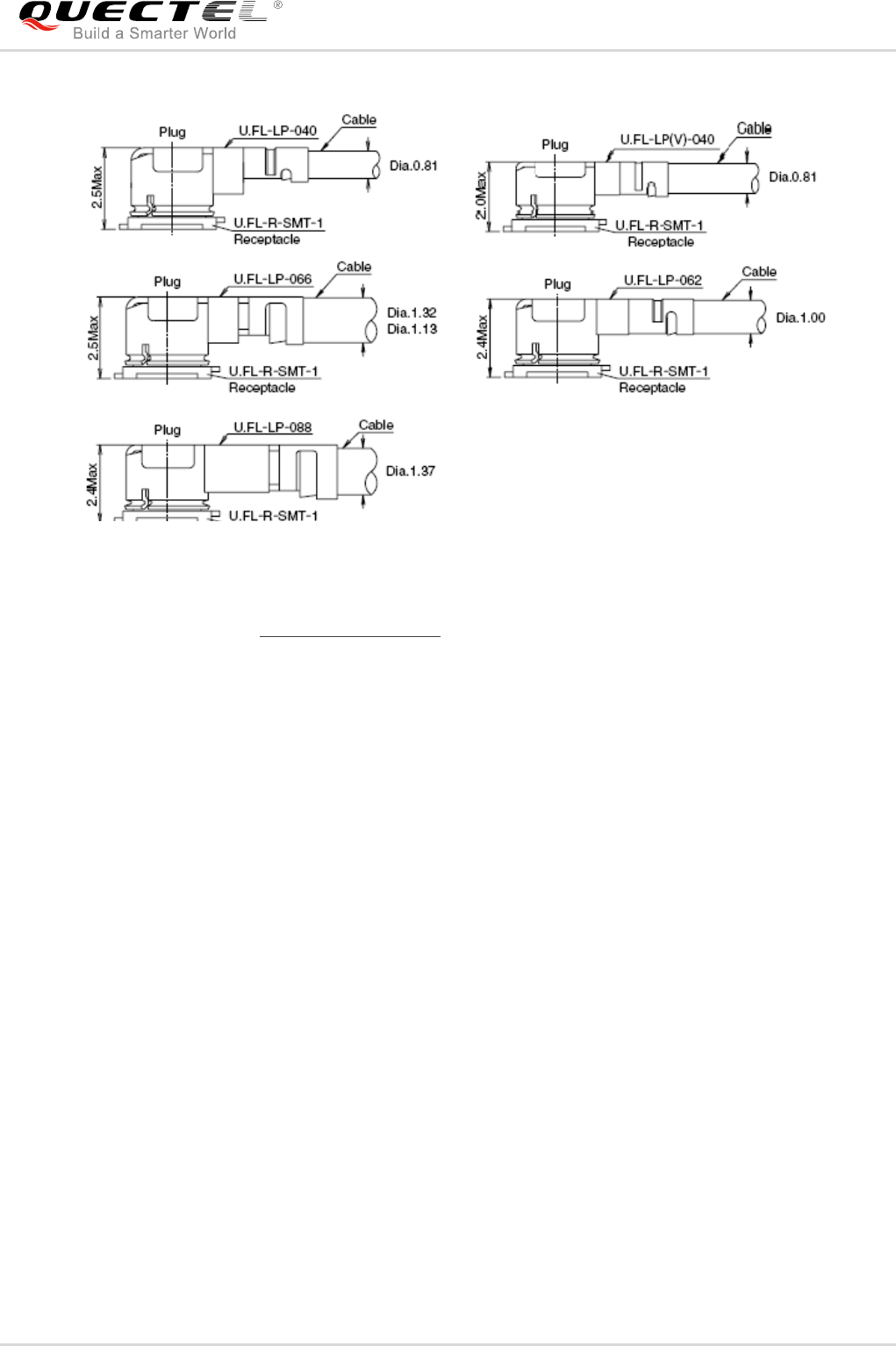Quectel Wireless Solutions 201903EG61NA LTE Cat 1 Module User Manual
Quectel Wireless Solutions Company Limited LTE Cat 1 Module Users Manual
Users Manual

LTE Module Series
EG61-NA Hardware Design
EG61-NA_Hardware_Design 1 / 77
Our aim is to provide customers with timely and comprehensive service. For any
assistance, please contact our company headquarters:
Quectel Wireless Solutions Co., Ltd.
7th Floor, Hongye Building, No.1801 Hongmei Road, Xuhui District, Shanghai 200233, China
Tel: +86 21 5108 6236
Email: info@quectel.com
Or our local office. For more information, please visit:
http://www.quectel.com/support/sales.htm
For technical support, or to report documentation errors, please visit:
http://www.quectel.com/support/technical.htm
Or email to: support@quectel.com
GENERAL NOTES
QUECTEL OFFERS THE INFORMATION AS A SERVICE TO ITS CUSTOMERS. THE INFORMATION
PROVIDED IS BASED UPON CUSTOMERS’ REQUIREMENTS. QUECTEL MAKES EVERY EFFORT
TO ENSURE THE QUALITY OF THE INFORMATION IT MAKES AVAILABLE. QUECTEL DOES NOT
MAKE ANY WARRANTY AS TO THE INFORMATION CONTAINED HEREIN, AND DOES NOT ACCEPT
ANY LIABILITY FOR ANY INJURY, LOSS OR DAMAGE OF ANY KIND INCURRED BY USE OF OR
RELIANCE UPON THE INFORMATION. ALL INFORMATION SUPPLIED HEREIN IS SUBJECT TO
CHANGE WITHOUT PRIOR NOTICE.
COPYRIGHT
THE INFORMATION CONTAINED HERE IS PROPRIETARY TECHNICAL INFORMATION OF
QUECTEL WIRELESS SOLUTIONS CO., LTD. TRANSMITTING, REPRODUCTION, DISSEMINATION
AND EDITING OF THIS DOCUMENT AS WELL AS UTILIZATION OF THE CONTENT ARE
FORBIDDEN WITHOUT PERMISSION. OFFENDERS WILL BE HELD LIABLE FOR PAYMENT OF
DAMAGES. ALL RIGHTS ARE RESERVED IN THE EVENT OF A PATENT GRANT OR
REGISTRATION OF A UTILITY MODEL OR DESIGN.
Copyright © Quectel Wireless Solutions Co., Ltd. 2019. All rights reserved.

LTE Module Series
EG61-NA Hardware Design
EG61-NA_Hardware_Design 2 / 77
About the Document
History
Revision Date Author Description
1.0 2019-01-04 Ward WANG/
Frank WANG Initial

LTE Module Series
EG61-NA Hardware Design
EG61-NA_Hardware_Design 3 / 77
Contents
About the Document ................................................................................................................................ 2
Contents .................................................................................................................................................... 3
Table Index ............................................................................................................................................... 5
Figure Index .............................................................................................................................................. 6
1 Introduction ....................................................................................................................................... 8
1.1. Safety Information ................................................................................................................... 9
2 Product Concept ............................................................................................................................. 14
2.1. General Description .............................................................................................................. 14
2.2. Key Features ......................................................................................................................... 14
2.3. Functional Diagram ............................................................................................................... 17
2.4. Evaluation Board ................................................................................................................... 17
3 Application Interfaces ..................................................................................................................... 18
3.1. General Description .............................................................................................................. 18
3.2. Pin Assignment ..................................................................................................................... 19
3.3. Pin Description ...................................................................................................................... 20
3.4. Operating Modes .................................................................................................................. 27
3.5. Power Saving ........................................................................................................................ 27
3.5.1. Sleep Mode.................................................................................................................. 27
3.5.1.1. UART Application ............................................................................................... 27
3.5.1.2. USB Application with USB Remote Wakeup Function ....................................... 28
3.5.1.3. USB Application with USB Suspend/Resume and RI Function .......................... 29
3.5.1.4. USB Application without USB Suspend Function ............................................... 30
3.5.2. Airplane Mode .............................................................................................................. 30
3.6. Power Supply ........................................................................................................................ 31
3.6.1. Power Supply Pins ....................................................................................................... 31
3.6.2. Decrease Voltage Drop ................................................................................................ 32
3.6.3. Reference Design for Power Supply ............................................................................ 33
3.6.4. Monitor the Power Supply ............................................................................................ 33
3.7. Turn-on and off Scenarios ..................................................................................................... 33
3.7.1. Turn on Module Using the PWRKEY ........................................................................... 33
3.7.2. Turn off Module ............................................................................................................ 35
3.7.2.1. Turn off Module Using the PWRKEY Pin ........................................................... 36
3.7.2.2. Turn off Module Using AT Command ................................................................. 36
3.8. Reset the Module .................................................................................................................. 36
3.9. (U)SIM Interfaces .................................................................................................................. 38
3.10. USB Interface ........................................................................................................................ 41
3.11. UART Interfaces .................................................................................................................... 42
3.12. PCM and I2C Interfaces ........................................................................................................ 45
3.13. SPI Interface ......................................................................................................................... 47
3.14. Network Status Indication ..................................................................................................... 48

LTE Module Series
EG61-NA Hardware Design
EG61-NA_Hardware_Design 4 / 77
3.15. STATUS ................................................................................................................................ 49
3.16. Behaviors of RI ..................................................................................................................... 49
3.17. USB_BOOT Interface ............................................................................................................ 50
4 GNSS Receiver ................................................................................................................................ 52
4.1. General Description .............................................................................................................. 52
4.2. GNSS Performance .............................................................................................................. 52
4.3. Layout Guidelines ................................................................................................................. 53
5 Antenna Interfaces .......................................................................................................................... 54
5.1. Main/Rx-diversity Antenna Interfaces.................................................................................... 54
5.1.1. Pin Definition ................................................................................................................ 54
5.1.2. Operating Frequency ................................................................................................... 54
5.1.3. Reference Design of RF Antenna Interface ................................................................. 55
5.1.4. Reference Design of RF Layout ................................................................................... 55
5.2. GNSS Antenna Interface ....................................................................................................... 57
5.3. Antenna Installation .............................................................................................................. 58
5.3.1. Antenna Requirement .................................................................................................. 58
5.3.2. Recommended RF Connector for Antenna Installation ................................................ 59
6 Electrical, Reliability and Radio Characteristics .......................................................................... 62
6.1. Absolute Maximum Ratings .................................................................................................. 62
6.2. Power Supply Ratings ........................................................................................................... 62
6.3. Operation and Storage Temperatures ................................................................................... 63
6.4. Current Consumption ............................................................................................................ 64
6.5. RF Output Power .................................................................................................................. 65
6.6. RF Receiving Sensitivity ....................................................................................................... 66
6.7. Electrostatic Discharge ......................................................................................................... 66
6.8. Thermal Consideration .......................................................................................................... 67
7 Mechanical Dimensions.................................................................................................................. 70
7.1. Mechanical Dimensions of the Module.................................................................................. 70
7.2. Recommended Footprint ....................................................................................................... 72
7.3. Design Effect Drawings of the Module .................................................................................. 73
8 Storage, Manufacturing and Packaging ........................................................................................ 74
8.1. Storage ................................................................................................................................. 74
8.2. Manufacturing and Soldering ................................................................................................ 75
8.3. Packaging ............................................................................................................................. 76
9 Appendix A References .................................................................................................................. 78

LTE Module Series
EG61-NA Hardware Design
EG61-NA_Hardware_Design 5 / 77
Table Index
TABLE 1: FREQUENCY BANDS OF EG61-NA MODULE ................................................................................ 14
TABLE 2: KEY FEATURES OF EG61-NA MODULE ......................................................................................... 15
TABLE 3: IO PARAMETERS DEFINITION ........................................................................................................ 20
TABLE 4: PIN DESCRIPTION ........................................................................................................................... 20
TABLE 5: OVERVIEW OF OPERATING MODES ............................................................................................. 27
TABLE 6: VBAT AND GND PINS ....................................................................................................................... 31
TABLE 7: PIN DEFINITION OF PWRKEY ........................................................................................................ 34
TABLE 8: PIN DEFINITION OF RESET_N ....................................................................................................... 37
TABLE 9: PIN DEFINITION OF (U)SIM INTERFACES ..................................................................................... 38
TABLE 10: PIN DEFINITION OF USB INTERFACE ......................................................................................... 41
TABLE 11: PIN DEFINITION OF MAIN UART INTERFACE ............................................................................. 43
TABLE 12: PIN DEFINITION OF DEBUG UART INTERFACE ......................................................................... 43
TABLE 13: LOGIC LEVELS OF DIGITAL I/O .................................................................................................... 43
TABLE 14: PIN DEFINITION OF PCM AND I2C INTERFACES ....................................................................... 46
TABLE 15: PIN DEFINITION OF SPI INTERFACE ........................................................................................... 47
TABLE 16: PIN DEFINITION OF NETWORK STATUS INDICATOR ................................................................ 48
TABLE 17: WORKING STATE OF THE NETWORK STATUS INDICATOR ...................................................... 48
TABLE 18: PIN DEFINITION OF STATUS ........................................................................................................ 49
TABLE 19: DEFAULT BEHAVIORS OF RI ........................................................................................................ 50
TABLE 20: PIN DEFINITION OF USB_BOOT INTERFACE ............................................................................. 50
TABLE 21: GNSS PERFORMANCE ................................................................................................................. 52
TABLE 22: PIN DEFINITION OF RF ANTENNA ............................................................................................... 54
TABLE 23: MODULE OPERATING FREQUENCIES ........................................................................................ 54
TABLE 24: PIN DEFINITION OF GNSS ANTENNA INTERFACE ..................................................................... 57
TABLE 25: GNSS FREQUENCY ....................................................................................................................... 58
TABLE 26: ANTENNA REQUIREMENTS .......................................................................................................... 59
TABLE 27: ABSOLUTE MAXIMUM RATINGS .................................................................................................. 62
TABLE 28: POWER SUPPLY RATINGS ........................................................................................................... 62
TABLE 29: OPERATION AND STORAGE TEMPERATURES .......................................................................... 63
TABLE 30: EG61-NA CURRENT CONSUMPTION ........................................................................................... 64
TABLE 31: GNSS CURRENT CONSUMPTION OF EG61-NA ......................................................................... 65
TABLE 32: RF OUTPUT POWER ..................................................................................................................... 65
TABLE 33: EG61-NA CONDUCTED RF RECEIVING SENSITIVITY ............................................................... 66
TABLE 34: ELECTROSTATIC DISCHARGE CHARACTERISTICS ................................................................. 66
TABLE 35: RECOMMENDED THERMAL PROFILE PARAMETERS ............................................................... 75
TABLE 36: RELATED DOCUMENTS ................................................................................................................ 78
TABLE 37: TERMS AND ABBREVIATIONS ...................................................................................................... 78

LTE Module Series
EG61-NA Hardware Design
EG61-NA_Hardware_Design 6 / 77
Figure Index
FIGURE 1: FUNCTIONAL DIAGRAM ............................................................................................................... 17
FIGURE 2: PIN ASSIGNMENT (TOP VIEW) .................................................................................................... 19
FIGURE 3: SLEEP MODE APPLICATION VIA UART ....................................................................................... 28
FIGURE 4: SLEEP MODE APPLICATION WITH USB REMOTE WAKEUP .................................................... 29
FIGURE 5: SLEEP MODE APPLICATION WITH RI ......................................................................................... 29
FIGURE 6: SLEEP MODE APPLICATION WITHOUT SUSPEND FUNCTION ................................................ 30
FIGURE 7: POWER SUPPLY LIMITS DURING BURST TRANSMISSION ...................................................... 32
FIGURE 8: STAR STRUCTURE OF THE POWER SUPPLY ............................................................................ 32
FIGURE 9: REFERENCE CIRCUIT OF POWER SUPPLY .............................................................................. 33
FIGURE 10: TURN ON THE MODULE USING DRIVING CIRCUIT ................................................................. 34
FIGURE 11: TURN ON THE MODULE USING BUTTON ................................................................................. 34
FIGURE 12: TIMING OF TURNING ON MODULE ........................................................................................... 35
FIGURE 13: TIMING OF TURNING OFF MODULE ......................................................................................... 36
FIGURE 14: REFERENCE CIRCUIT OF RESET_N BY USING DRIVING CIRCUIT ...................................... 37
FIGURE 15: REFERENCE CIRCUIT OF RESET_N BY USING BUTTON ...................................................... 37
FIGURE 16: TIMING OF RESETTING MODULE ............................................................................................. 38
FIGURE 17: REFERENCE CIRCUIT OF (U)SIM INTERFACE WITH AN 8-PIN (U)SIM CARD CONNECTOR
................................................................................................................................................................... 39
FIGURE 18: REFERENCE CIRCUIT OF (U)SIM INTERFACE WITH A 6-PIN (U)SIM CARD CONNECTOR . 40
FIGURE 19: REFERENCE CIRCUIT OF USB INTERFACE ............................................................................ 41
FIGURE 20: REFERENCE CIRCUIT WITH TRANSLATOR CHIP ................................................................... 44
FIGURE 21: REFERENCE CIRCUIT WITH TRANSISTOR CIRCUIT .............................................................. 44
FIGURE 22: PRIMARY MODE TIMING ............................................................................................................ 45
FIGURE 23: AUXILIARY MODE TIMING .......................................................................................................... 46
FIGURE 24: REFERENCE CIRCUIT OF PCM APPLICATION WITH AUDIO CODEC .................................... 47
FIGURE 25: REFERENCE CIRCUIT OF SPI INTERFACE WITH PERIPHERALS ......................................... 48
FIGURE 26: REFERENCE CIRCUIT OF THE NETWORK STATUS INDICATOR ........................................... 49
FIGURE 27: REFERENCE CIRCUITS OF STATUS ......................................................................................... 49
FIGURE 28: REFERENCE CIRCUIT OF USB_BOOT INTERFACE ................................................................ 51
FIGURE 29: TIMING SEQUENCE FOR ENTERING INTO EMERGENCY DOWNLOAD MODE .................... 51
FIGURE 30: REFERENCE CIRCUIT OF RF ANTENNA INTERFACE ............................................................. 55
FIGURE 31: MICROSTRIP LINE DESIGN ON A 2-LAYER PCB ...................................................................... 56
FIGURE 32: COPLANAR WAVEGUIDE LINE DESIGN ON A 2-LAYER PCB .................................................. 56
FIGURE 33: COPLANAR WAVEGUIDE LINE DESIGN ON A 4-LAYER PCB (LAYER 3 AS REFERENCE
GROUND) .......................................................................................................................................................... 57
FIGURE 34: COPLANAR WAVEGUIDE LINE DESIGN ON A 4-LAYER PCB (LAYER 4 AS REFERENCE
GROUND) .......................................................................................................................................................... 57
FIGURE 35: REFERENCE CIRCUIT OF GNSS ANTENNA ............................................................................. 58
FIGURE 36: DIMENSIONS OF THE U.FL-R-SMT CONNECTOR (UNIT: MM) ................................................ 60
FIGURE 37: MECHANICALS OF U.FL-LP CONNECTORS ............................................................................. 60
FIGURE 38: SPACE FACTOR OF MATED CONNECTOR (UNIT: MM) ........................................................... 61

LTE Module Series
EG61-NA Hardware Design
EG61-NA_Hardware_Design 7 / 77
FIGURE 39: REFERENCED HEATSINK DESIGN (HEATSINK AT THE TOP OF THE MODULE) .................. 68
FIGURE 40: REFERENCED HEATSINK DESIGN (HEATSINK AT THE BOTTOM OF CUSTOMERS’ PCB) . 68
FIGURE 41: MODULE TOP AND SIDE DIMENSIONS ..................................................................................... 70
FIGURE 42: MODULE BOTTOM DIMENSIONS (TOP VIEW) ......................................................................... 71
FIGURE 43: RECOMMENDED FOOTPRINT (TOP VIEW) .............................................................................. 72
FIGURE 44: TOP VIEW OF THE MODULE ...................................................................................................... 73
FIGURE 45: BOTTOM VIEW OF THE MODULE .............................................................................................. 73
FIGURE 46: REFLOW SOLDERING THERMAL PROFILE .............................................................................. 75
FIGURE 47: TAPE DIMENSIONS ..................................................................................................................... 77
FIGURE 48: REEL DIMENSIONS ..................................................................................................................... 77

LTE Module Series
EG61-NA Hardware Design
EG61-NA_Hardware_Design 8 / 77
1 Introduction
This document defines the EG61-NAmodule and describes its air interface and hardware interface which
are connected with customers’ applications.
This document can help customers quickly understand module interface specifications, electrical
andmechanical details, as well as other related information of EG61-NA module. Associated with
application note and user guide, customers can use EG61-NA module to design and set up mobile
applications easily.

LTE Module Series
EG61-NA Hardware Design
EG61-NA_Hardware_Design 9 / 77
1.1. Safety Information
The following safety precautions must be observed during all phases of operation, such as usage, service
or repair of any cellular terminal or mobile incorporating EG61-NA module. Manufacturers of the cellular
terminal should send the following safety information to users and operating personnel, and incorporate
these guidelines into all manuals supplied with the product. If not so, Quectel assumes no liability for
customers’ failure to comply with these precautions.
Full attention must be given to driving at all times in order to reduce the risk of an
accident. Using a mobile while driving (even with a handsfree kit) causes
distraction and can lead to an accident. Please comply with laws and regulations
restricting the use of wireless devices while driving.
Switch off the cellular terminal or mobile before boarding an aircraft. The operation
of wireless appliances in an aircraft is forbidden to prevent interference with
communication systems. If the device offers an Airplane Mode, then it should be
enabled prior to boarding an aircraft. Please consult the airline staff for more
restrictions on the use of wireless devices on boarding the aircraft.
Wireless devices may cause interference on sensitive medical equipment, so
please be aware of the restrictions on the use of wireless devices when in
hospitals, clinics or other healthcare facilities.
Cellular terminals or mobiles operating over radio signals and cellular network
cannot be guaranteed to connect in all possible conditions (for example, with
unpaid bills or with an invalid (U)SIM card). When emergent help is needed in such
conditions, please remember using emergency call. In order to make or receive a
call, the cellular terminal or mobile must be switched on in a service area with
adequate cellular signal strength.
The cellular terminal or mobile contains a transmitter and receiver. When it is ON, it
receives and transmits radio frequency signals. RF interference can occur if it is
used close to TV set, radio, computer or other electric equipment.
In locations with potentially explosive atmospheres, obey all posted signs to turn
off wireless devices such as your phone or other cellular terminals. Areas with
potentially explosive atmospheres include fuelling areas, below decks on boats,
fuel or chemi
cal transfer or storage facilities, areas where the air contains
chemicals or particles such as grain, dust or metal powders, etc.

LTE Module Series
EG61-NA Hardware Design
EG61-NA_Hardware_Design 10 / 77
1.2. FCC Certification Requirements.
According to the definition of mobile and fixed device is described in Part 2.1091(b), this device is a
mobile device.
And the following conditions must be met:
1. This Modular Approval is limited to OEM installation for mobile and fixed applications only. The antenna
installation and operating configurations of this transmitter, including any applicable source-based time-
averaging duty factor, antenna gain and cable loss must satisfy MPE categorical Exclusion Requirements
of 2.1091.
2. The EUT is a mobile device; maintain at least a 20 cm separation between the EUT and the user’s
body and must not transmit simultaneously with any other antenna or transmitter.
3.A label with the following statements must be attached to the host end product: This device contains
FCC ID: XMR201903EG61NA.
4.To comply with FCC regulations limiting both maximum RF output power and human exposure to RF
radiation, maximum antenna gain (including cable loss) must not exceed:
❒ WCDMA Band2/ LTE Band2:≤8dBi
❒ WCDMA Band4/ LTE Band4/66:≤5dBi
❒ WCDMA Band5/ LTE Band5:≤9.42dBi
❒ LTE Band12:≤8.73dBi
❒ LTE Band13:≤9.17dBi
❒ LTE Band71:≤8.55dBi
5. This module must not transmit simultaneously with any other antenna or transmitter
6. The host end product must include a user manual that clearly defines operating requirements and
conditions that must be observed to ensure compliance with current FCC RF exposure guidelines.
For portable devices, in addition to the conditions 3 through 6 described above, a separate approval is
required to satisfy the SAR requirements of FCC Part 2.1093

LTE Module Series
EG61-NA Hardware Design
EG61-NA_Hardware_Design 11 / 77
If the device is used for other equipment that separate approval is required for all other operating
configurations, including portable configurations with respect to 2.1093 and different antenna
configurations.
For this device, OEM integrators must be provided with labeling instructions of finished products.
Please refer to KDB784748 D01 v07, section 8. Page 6/7 last two paragraphs:
A certified modular has the option to use a permanently affixed label, or an electronic label. For a
permanently affixed label, the module must be labeled with an FCC ID - Section 2.926 (see 2.2
Certification (labeling requirements) above). The OEM manual must provide clear instructions
explaining to the OEM the labeling requirements, options and OEM user manual instructions that are
required (see next paragraph).
For a host using a certified modular with a standard fixed label, if (1) the module’s FCC ID is not visible
when installed in the host, or (2) if the host is marketed so that end users do not have straightforward
commonly used methods for access to remove the module so that the FCC ID of the module is visible;
then an additional permanent label referring to the enclosed module:“Contains Transmitter Module FCC
ID: XMR201903EG61NA” or “Contains FCC ID: XMR201903EG61NA” must be used. The host OEM
user manual must also contain clear instructions on how end users can find and/or access the module
and the FCC ID.
The final host / module combination may also need to be evaluated against the FCC Part 15B criteria
for unintentional radiators in order to be properly authorized for operation as a Part 15 digital device.
The user’s manual or instruction manual for an intentional or unintentional radiator shall caution the
user that changes or modifications not expressly approved by the party responsible for compliance
could void the user's authority to operate the equipment. In cases where the manual is provided only in
a form other than paper, such as on a computer disk or over the Internet, the information required by
this section may be included in the manual in that alternative form, provided the user can reasonably be
expected to have the capability to access information in that form.

LTE Module Series
EG61-NA Hardware Design
EG61-NA_Hardware_Design 12 / 77
This device complies with part 15 of the FCC Rules. Operation is subject to the following two conditions:
(1) This device may not cause harmful interference, and (2) this device must accept any interference
received, including interference that may cause undesired operation.
Changes or modifications not expressly approved by the manufacturer could void the user’s authority to
operate the equipment.
To ensure compliance with all non-transmitter functions the host manufacturer is responsible for ensuring
compliance with the module(s) installed and fully operational. For example, if a host was previously
authorized as an unintentional radiator under the Declaration of Conformity procedure without a
transmitter certified module and a module is added, the host manufacturer is responsible for ensuring that
the after the module is installed and operational the host continues to be compliant with the Part 15B
unintentional radiator requirements.
1.3. IC Statement
IRSS-GEN
"This device complies with Industry Canada’s licence-exempt RSSs. Operation is subject to the following
two conditions: (1) This device may not cause interference; and (2) This device must accept any
interference, including interference that may cause undesired operation of the device." or "Le présent
appareil est conforme aux CNR d’Industrie Canada applicables aux appareils radio exempts de licence.
L’exploitation est autorisée aux deux conditions suivantes :
1) l’appareil ne doit pas produire de brouillage; 2) l’utilisateur de l’appareil doit accepter tout brouillage
radioélectrique subi, même si le brouillage est susceptible d’en compromettre le fonctionnement."
Déclaration sur l'exposition aux rayonnements RF
The EUT is a mobile device; maintain at least a 20 cm separation between the EUT and the user’s body
and must not transmit simultaneously with any other antenna or transmitter.
L'autre utilisé pour l'émetteur doit être installé pour fournir une distance de séparation d'au moins 20 cm
de toutes les personnes et ne doit pas être colocalisé ou fonctionner conjointement avec une autre

LTE Module Series
EG61-NA Hardware Design
EG61-NA_Hardware_Design 13 / 77
antenne ou un autre émetteur.
To comply with IC regulations limiting both maximum RF output power and human exposure to RF
radiation, maximum antenna gain (including cable loss) must not exceed:
❒ WCDMA Band2/ LTE Band2:≤8dBi
❒ WCDMA Band4/ LTE Band4/66:≤5dBi
❒ WCDMA Band5/ LTE Band5:≤6.1dBi
❒ LTE Band12:≤5.61dBi
❒ LTE Band13:≤5.93dBi
❒ LTE Band71:≤5.45dBi
The host product shall be properly labelled to identify the modules within the host product.
The Innovation, Science and Economic Development Canada certification label of a module shall be
clearly visible at all times when installed in the host product; otherwise, the host product must be labeled
to display the Innovation, Science and Economic Development Canada certification number for the
module, preceded by the word “Contains” or similar wording expressing the same meaning, as follows:
“Contains IC: 10224A-20193EG61NA” or “where: 10224A-20193EG61NA is the module’s certification
number”.
Le produit hôte doit être correctement étiqueté pour identifier les modules dans le produit hôte.
L'étiquette de certification d'Innovation, Sciences et Développement économique Canada d'un module
doit être clairement visible en tout temps lorsqu'il est installédans le produit hôte; sinon, le produit hôte
doit porter une étiquette indiquant le numéro de certification d'Innovation, Sciences et Développement
économique Canada pour le module, précédé du mot «Contient» ou d'un libellé semblable exprimant la
même signification, comme suit:
"Contient IC: 10224A-20193EG61NA " ou "où: 10224A-20193EG61NA est le numéro de certification du
module".

LTE Module Series
EG61-NA Hardware Design
EG61-NA_Hardware_Design 14 / 77
2 Product Concept
2.1. General Description
EG61-NAmodule is an embedded 4G wireless communication module with receive diversity. It
supportsLTE-FDD/WCDMA wireless communication, andprovides data connectivity on LTE-FDD,HSPA+,
HSDPA, HSUPA, WCDMAnetworks. It can also provide voice functionality1)to meet customers’ specific
application demands. The following table shows the frequency bands of EG61-NA module.
Table 1: Frequency Bands of EG61-NA Module
With a compact profile of 31.0mm ×25.0mm ×2.3mm, EG61-NA can meet almost all requirements for
M2M applications such as automotive, smart metering, tracking system, security, router, wireless POS,
mobile computing device, PDA phone, tablet PC, etc.
EG61-NA is an SMD type module which can be embedded into applications through its 106 LGA pads.
EG61-NA is integrated with internet service protocols like TCP, UDP and PPP. Extended AT commands
have been developed for customers to use these internet service protocols easily.
2.2. Key Features
The following table describes the detailed features of EG61-NA module.
Module LTE Bands
(with Rx-diversity)
WCDMA
(with Rx-diversity) GSM GNSS
EG61-NA
FDD:
B2/B4/B5/B12/B13/B66/
B71
B2/B4/B5 Not supported
GPS, GLONASS,
BeiDou/Galileo,
QZSS

LTE Module Series
EG61-NA Hardware Design
EG61-NA_Hardware_Design 15 / 77
Table 2: Key Features of EG61-NA Module
Feature Details
Power Supply Supply voltage: 3.3V~4.3V
Typical supply voltage: 3.8V
Transmitting Power Class 3 (24dBm+1/-3dB) for WCDMA bands
Class 3 (23dBm±2dB) for LTE-FDD bands
LTE Features
Support up to non-CA Cat 1 FDD
Support 1.4MHz~20MHz RF bandwidth
Support MIMO in DL direction
LTE-FDD: Max 10Mbps (DL)/5Mbps (UL)
UMTS Features
Support 3GPP R8 HSPA+, HSDPA, HSUPA and WCDMA
Support QPSK, 16-QAM and 64-QAM modulation
HSDPA: Max 7.2Mbps (DL)
HSUPA: Max 5.76Mbps (UL)
WCDMA: Max 384Kbps (DL)/384Kbps (UL)
Internet Protocol Features
SupportTCP/UDP/PPP/FTP/HTTP/NTP/PING/QMI/CMUX*/HTTPS*/
SMTP*/MMS*/FTPS*/SMTPS*/SSL*/FILE* protocols
Support PAP (Password Authentication Protocol) and CHAP (Challenge
Handshake Authentication Protocol) protocols which are usually used for
PPP connections
SMS
Text and PDU mode
Point-to-point MO and MT
SMS cell broadcast
SMS storage: ME by default
(U)SIMInterfaces Support 1.8V and 3.0V (U)SIM cards
Audio Features
Support one digital audio interface: PCM interface
WCDMA: AMR/AMR-WB
LTE: AMR/AMR-WB
Support echo cancellation and noise suppression
PCM Interface
Used for audio function with external codec
Support 16-bit linear data format
Support long frame synchronization and short frame synchronization
Support master and slave mode, but must be the master in long frame
synchronization
USB Interface
Compliant with USB 2.0 specification (slave only);the data transfer rate can
reach up to 480Mbps
Used for AT command communication, data transmission,GNSS NMEA
sentences output,software debugging, firmware upgrade and voice over
USB*
Support USB serial drivers for:
Windows 7/8/8.1/10, Windows CE
5.0/6.0/7.0*, Linux 2.6/3.x/4.1~4.14, Android 4.x/5.x/6.x/7.x/8.x, etc.
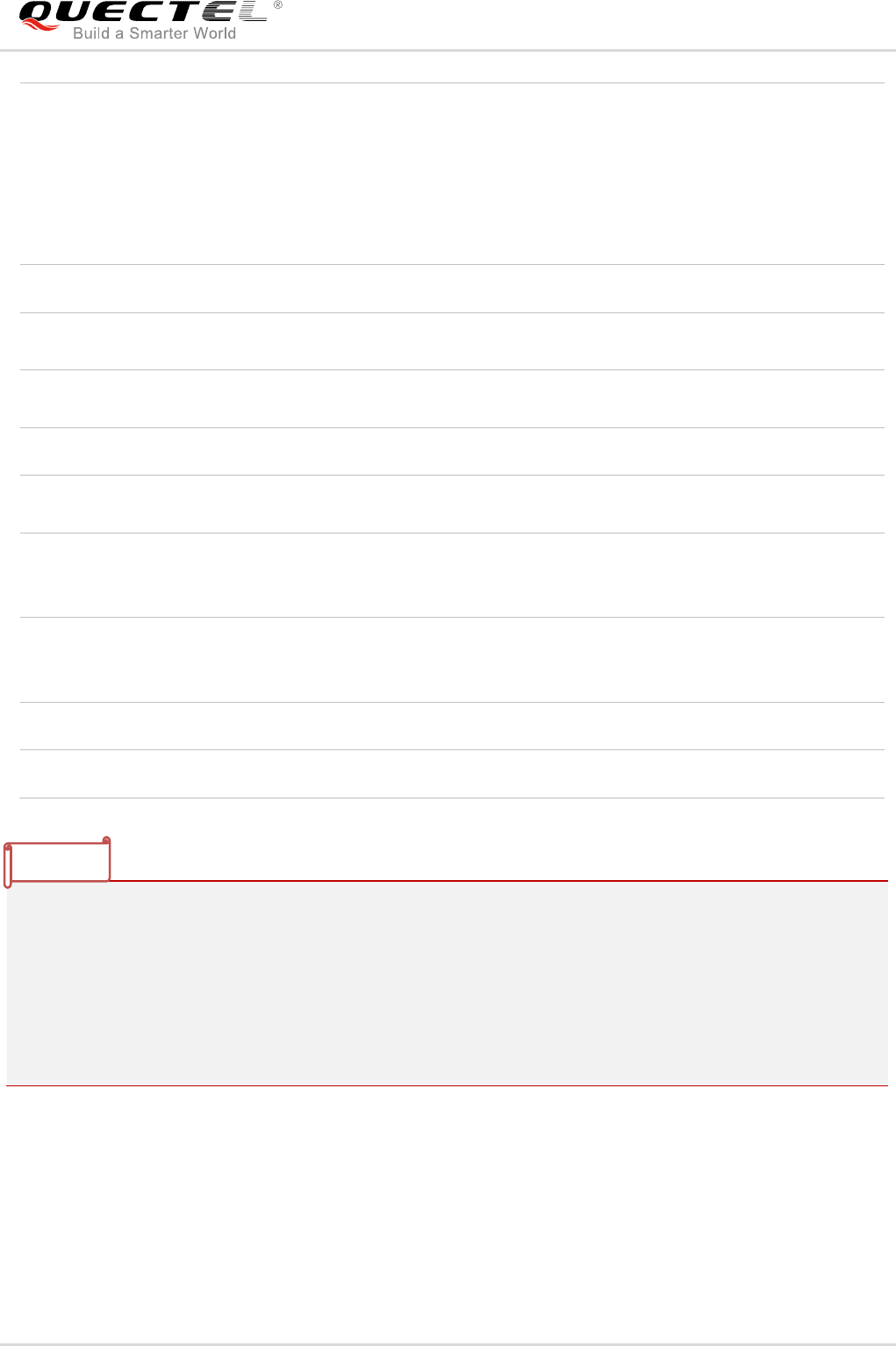
LTE Module Series
EG61-NA Hardware Design
EG61-NA_Hardware_Design 16 / 77
UART Interface
Main UART:
Used for AT command communication and data transmission
Baud rate reach up to 921600bps, 115200bps by default
Support RTS and CTS hardware flow control
Debug UART:
Used for Linux console and log output
115200bps baud rate
Rx-diversity Support LTE/WCDMA Rx-diversity
GNSS Features Gen8C Lite of Qualcomm
Protocol: NMEA 0183
AT Commands Compliant with 3GPP TS 27.007,
27.005 and Quectel enhanced AT
commands
Network Indication NETLIGHTpin for network activitystatusindication
Antenna Interface Including main antenna interface (ANT_MAIN), Rx-diversity antenna
(ANT_DIV) interface and GNSS antenna interface (ANT_GNSS)
Physical Characteristics
Size: (31.0±0.15)mm × (25.0±0.15)mm × (2.3±0.2)mm
Package: LGA
Weight: TBD
Temperature Range
Operation temperature range: -35°C ~ +75°C 1)
Extended temperature range: -40°C ~ +85°C 2)
Storage temperature range: -40°C ~ +90°C
Firmware Upgrade USB interface and DFOTA*
RoHS All hardware components are fully compliant with EU RoHS directive
1. 1) Within operation temperature range, the module is 3GPP compliant.
2. 2) Within extended temperature range, the module remains the ability to establish and maintain a
voice, SMS, data transmission, emergency call, etc. There is no unrecoverable malfunction. There
are also no effects on radio spectrum and no harm to radio network. Only one or more parameters
like Pout might reduce in their value and exceed the specified tolerances. When the temperature
returns to normal operation temperature levels, the module will meet 3GPP specifications again.
3. “*” means under development.
NOTES
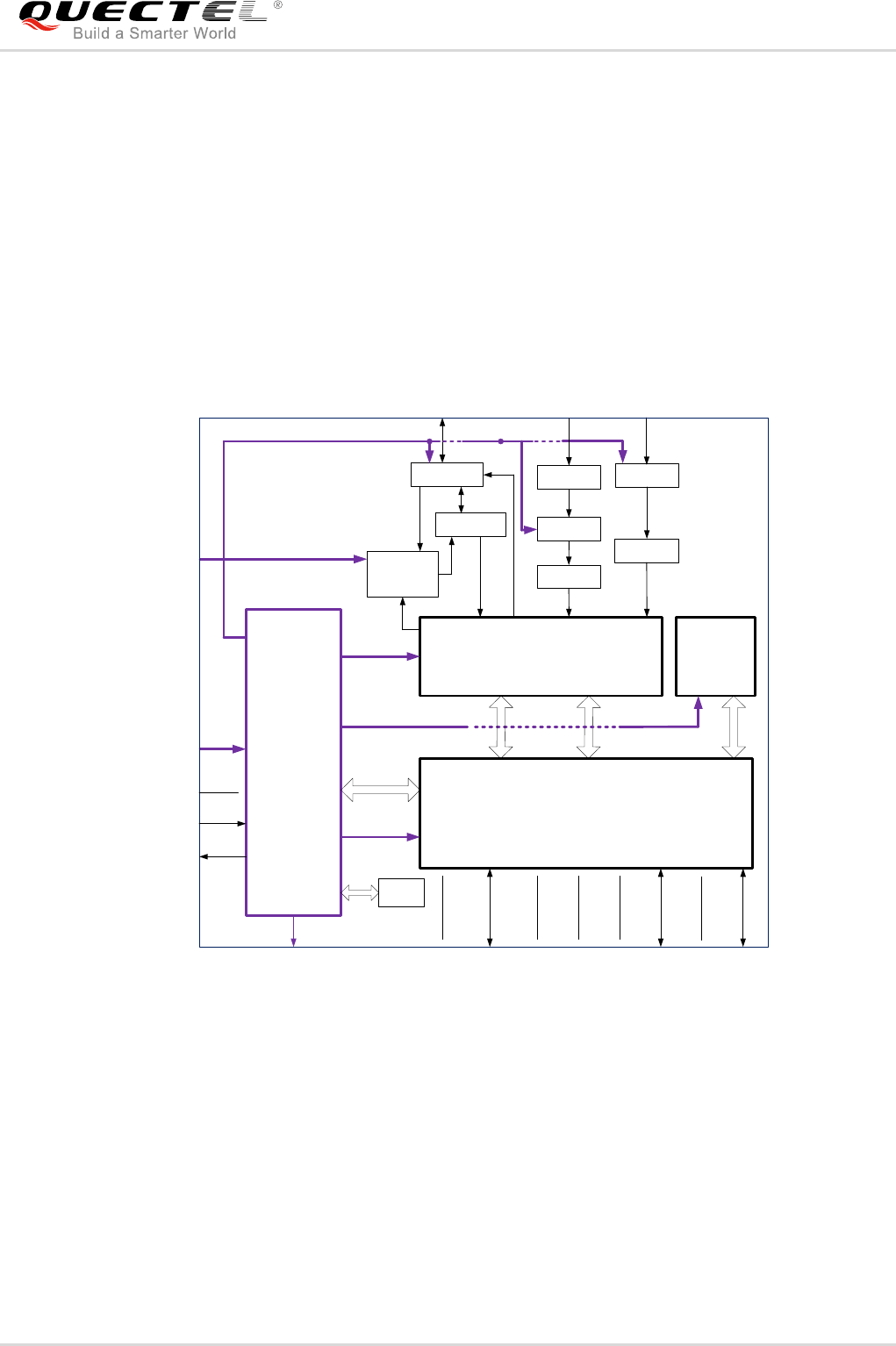
LTE Module Series
EG61-NA Hardware Design
EG61-NA_Hardware_Design 17 / 77
2.3. Functional Diagram
The following figure shows a block diagram of EG61-NA and illustrates the major functional parts.
Power management
Baseband
DDR+NAND flash
Radio frequency
Peripheral interfaces
Baseband
PMIC
Transceiver
NAND
DDR2
SDRAM
PA
SWITCH Switch
ANT_MAIN ANT_DIV
VBAT_BB
VBAT_RF
PWRKEY
VDD_EXT USB PCM UARTI2C
RESET_N
19.2M
XO
STATUS
GPIOs
Control
IQ Control
Duplexer
SAW
Tx
PRx DRx
(U)SIM2 SPI
(U)SIM1
SAW
LNA
ANT_GNSS
SAW
GPS
Figure 1: Functional Diagram
2.4. Evaluation Board
In order to help customers develop applications conveniently with EG61-NA, Quectel supplies
anevaluation board (EVB), USB data cable, earphone, antenna and other peripherals to control or test the
module.

LTE Module Series
EG61-NA Hardware Design
EG61-NA_Hardware_Design 18 / 77
3 Application Interfaces
3.1. General Description
EG61-NAis equipped with 62-pin 1.1mm pitch SMT pads plus 44-pin ground/reserved pads that can be
connected to customers’ cellular application platforms. Sub-interfaces included in these pads are
described in detail in the following chapters:
Power supply
(U)SIMinterfaces
USB interface
UART interfaces
PCMand I2C interfaces
SPI interface
Statusindication
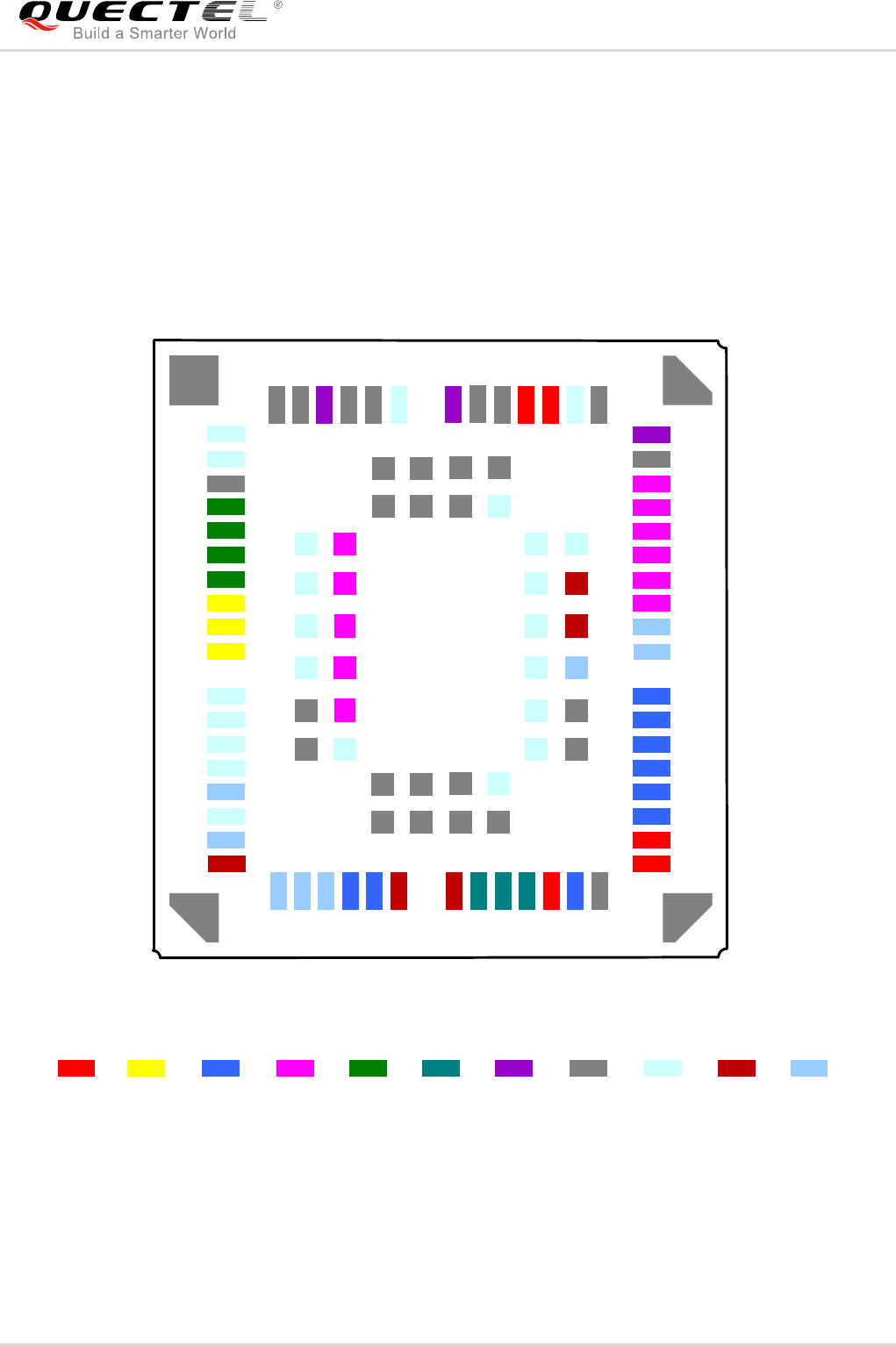
LTE Module Series
EG61-NA Hardware Design
EG61-NA_Hardware_Design 19 / 77
3.2. Pin Assignment
The following figure shows the pin assignment of EG61-NA module.
NC
PCM_SYNC
PCM_CLK
PCM_DIN
PCM_DOUT
NC
NC
PWRKEY 1)
NC
RESET_N
RESERVED
1
2
3
4
5
6
7
11
12
13
14
15
16
17
18
50
51
52
53
54
55
58
59
60
61
62
USB_DM
AP_READY
STATUS
NETLIGHT
DBG_RXD
DBG_TXD
RESERVED
RESERVED
SPI_CLK
SPI_MOSI
SPI_MISO
VDD_EXT
DTR
GND
USIM1_CLK
USIM1_DATA
USIM1_RST
USIM1_VDD
RI
DCD
CTS
TXD
RXD
VBAT_BB
VBAT_BB
USIM_GND
GND
31
30
29
28
27
26
23
22
21
20
19
10
9
USB_DP
USB_VBUS
NC
GND
NC
NC
RTS
I2C_SCL
I2C_SDA
8
49
48
47
46
45
44
43
40
41
42
39
38
37
36
35
34
33
32
24
57
56
GND
GND
ANT_MAIN
GND
GND
NC
VBAT_RF
VBAT_RF
GND
GND
NC
GND
USIM1_PRESENCE
63
64
65
66
67
68
83
84
85
86
87
88
98
97
96
95
94
93
78
77
76
75
74
73
91 92
89 90
71 72
69 70
80 79
82 81
100 99
102 101
POWER USB UART (U)SIM OTHERS
GND NC
PCM ANT
25
USIM2_PRESENCE
USIM2_CLK
USIM2_RST
USIM2_DATA
USIM2_VDD
SPI
USB_BOOT
103
104 105
106
ANT_DIV
ANT_GNSS
RESERVED
Figure 2: Pin Assignment (Top View)

LTE Module Series
EG61-NA Hardware Design
EG61-NA_Hardware_Design 20 / 77
1.
1)
PWRKEY output voltage is 0.8V because of the diode drop in the Qualcomm chipset.
2. Keep all RESERVEDpins and unused pins unconnected.
3. GND pads should be connected to ground in the design.
3.3. Pin Description
The following tables show the pin definition and description of EG61-NA.
Table 3: IO Parameters Definition
Type Description
AI Analog input
AO Analog output
DI Digital input
DO Digital output
IO Bidirectional
OD Open drain
PI Power input
PO Power output
Table 4: Pin Description
Power Supply
Pin Name Pin No. I/O Description DC Characteristics
Comment
VBAT_BB 32, 33 PI
Power supply for
module’s baseband
part
Vmax=4.3V
Vmin=3.3V
Vnorm=3.8V
It must be able to
provide sufficient
current up to 0.8A.
VBAT_RF 52,53 PI Power supply for
module’s RF part
Vmax=4.3V
Vmin=3.3V
Vnorm=3.8V
It must be able to
provide sufficient
current up to 1.8A in a
transmitting burst.
NOTES

LTE Module Series
EG61-NA Hardware Design
EG61-NA_Hardware_Design 21 / 77
VDD_EXT 29 PO Provide 1.8V for
external circuit
Vnorm=1.8V
IOmax=50mA
Power supply for
external GPIO’s pull up
circuits.
GND
3, 31, 48,
50, 54, 55,
58, 59, 61,
62, 67~74,
79~82,
89~91,
100~106
Ground
Turn on/off
Pin Name Pin No. I/O Description DC Characteristics Comment
PWRKEY 15 DI Turnon/off the
module
VIHmax=2.1V
VIHmin=1.3V
VILmax=0.5V
The output voltage is
0.8V because of the
diode drop in the
Qualcomm chipset.
RESET_N 17 DI Reset signal of the
module
VIHmax=2.1V
VIHmin=1.3V
VILmax=0.5V
Pull-up to 1.8V
internally.
Activelow.
If unused,keep it
open.
Status Indication
Pin Name Pin No. I/O Description DC Characteristics Comment
STATUS 20 DO Indicate the module
operation status
VOHmin=1.35V
VOLmax=0.45V
1.8V power domain.
If unused, keep it
open.
NETLIGHT 21 DO
Indicate the
module’s network
activity status
VOHmin=1.35V
VOLmax=0.45V
1.8V power domain.
If unused, keep it
open.
USB Interface
Pin Name Pin No. I/O Description DC Characteristics Comment
USB_VBUS 8 PI USB detection
Vmax=5.25V
Vmin=3.0V
Vnorm=5.0V
Typical:5.0V
If unused, keep it
open.
USB_DP 9 IO USB differential data
bus (+)
Compliant with USB
2.0 standard
specification.
Require differential
impedance of 90Ω.
USB_DM 10 IO USB differential data
bus (-)
Compliant with USB
2.0 standard
Require differential
impedance of 90Ω.

LTE Module Series
EG61-NA Hardware Design
EG61-NA_Hardware_Design 22 / 77
specification.
(U)SIMInterfaces
Pin Name Pin No. I/O Description DC Characteristics Comment
USIM_GND 47 Specified ground for
(U)SIM card
Connect to ground of
(U)SIM card
connector.
USIM1_VDD 43 PO Power supply for
(U)SIMcard
For 1.8V(U)SIM:
Vmax=1.9V
Vmin=1.7V
For 3.0V(U)SIM:
Vmax=3.05V
Vmin=2.7V
IOmax=50mA
Either 1.8V or 3.0V is
supported by the
module automatically.
USIM1_DATA 45 IO Data signal of
(U)SIMcard
For 1.8V (U)SIM:
VILmax=0.6V
VIHmin=1.2V
VOLmax=0.45V
VOHmin=1.35V
For 3.0V (U)SIM:
VILmax=1.0V
VIHmin=1.95V
VOLmax=0.45V
VOHmin=2.55V
USIM1_CLK 46 DO Clock signal of
(U)SIMcard
For 1.8V (U)SIM:
VOLmax=0.45V
VOHmin=1.35V
For 3.0V (U)SIM:
VOLmax=0.45V
VOHmin=2.55V
USIM1_RST 44 DO Reset signal of
(U)SIMcard
For 1.8V (U)SIM:
VOLmax=0.45V
VOHmin=1.35V
For 3.0V (U)SIM:
VOLmax=0.45V
VOHmin=2.55V

LTE Module Series
EG61-NA Hardware Design
EG61-NA_Hardware_Design 23 / 77
USIM1_
PRESENCE 42 DI (U)SIMcard insertion
detection
VILmin=-0.3V
VILmax=0.6V
VIHmin=1.2V
VIHmax=2.0V
1.8V power domain.
If unused, keep it
open.
USIM2_VDD 87 PO Power supply for
(U)SIMcard
For 1.8V(U)SIM:
Vmax=1.9V
Vmin=1.7V
For 3.0V(U)SIM:
Vmax=3.05V
Vmin=2.7V
IOmax=50mA
Either 1.8V or 3.0V is
supported by the
module automatically.
USIM2_DATA 86 IO Data signal of
(U)SIMcard
For 1.8V (U)SIM:
VILmax=0.6V
VIHmin=1.2V
VOLmax=0.45V
VOHmin=1.35V
For 3.0V (U)SIM:
VILmax=1.0V
VIHmin=1.95V
VOLmax=0.45V
VOHmin=2.55V
USIM2_CLK 84 DO Clock signal of
(U)SIMcard
For 1.8V (U)SIM:
VOLmax=0.45V
VOHmin=1.35V
For 3.0V (U)SIM:
VOLmax=0.45V
VOHmin=2.55V
USIM2_RST 85 DO Reset signal of
(U)SIMcard
For 1.8V (U)SIM:
VOLmax=0.45V
VOHmin=1.35V
For 3.0V (U)SIM:
VOLmax=0.45V
VOHmin=2.55V
USIM2_
PRESENCE 83 DI (U)SIMcard insertion
detection
VILmin=-0.3V
VILmax=0.6V
VIHmin=1.2V
VIHmax=2.0V
1.8V power domain.
If unused, keep it
open.
Main UART Interface

LTE Module Series
EG61-NA Hardware Design
EG61-NA_Hardware_Design 24 / 77
Pin Name Pin No. I/O Description DC Characteristics Comment
RI 39 DO Ring indicator VOLmax=0.45V
VOHmin=1.35V
1.8V power domain.
If unused, keep it
open.
DCD 38 DO Data carrier
detection
VOLmax=0.45V
VOHmin=1.35V
1.8V power domain.
If unused, keep it
open.
CTS 36 DO Clear to send VOLmax=0.45V
VOHmin=1.35V
1.8V power domain.
If unused, keep it
open.
RTS 37 DI Request to send
VILmin=-0.3V
VILmax=0.6V
VIHmin=1.2V
VIHmax=2.0V
1.8V power domain.
If unused, keep it
open.
DTR 30 DI Data terminal ready.
Sleep mode control.
VILmin=-0.3V
VILmax=0.6V
VIHmin=1.2V
VIHmax=2.0V
1.8V power domain.
Pull-up by default.
Low level wakes up
the module.
If unused, keep it
open.
TXD 35 DO Transmit data VOLmax=0.45V
VOHmin=1.35V
1.8V power domain.
If unused, keep it
open.
RXD 34 DI Receive data
VILmin=-0.3V
VILmax=0.6V
VIHmin=1.2V
VIHmax=2.0V
1.8V power domain.
If unused, keep it
open.
Debug UART Interface
Pin Name Pin No. I/O Description DC Characteristics Comment
DBG_TXD 23 DO Transmit data VOLmax=0.45V
VOHmin=1.35V
1.8V power domain.
If unused, keep it
open.
DBG_RXD 22 DI Receive data
VILmin=-0.3V
VILmax=0.6V
VIHmin=1.2V
VIHmax=2.0V
1.8V power domain.
If unused, keep it
open.
PCM Interface
Pin Name Pin No. I/O Description DC Characteristics Comment
PCM_DIN 6 DI PCM data input VILmin=-0.3V 1.8V power domain.

LTE Module Series
EG61-NA Hardware Design
EG61-NA_Hardware_Design 25 / 77
VILmax=0.6V
VIHmin=1.2V
VIHmax=2.0V
If unused, keep it
open.
PCM_DOUT 7 DO PCM data output VOLmax=0.45V
VOHmin=1.35V
1.8V power domain.
If unused, keep it
open.
PCM_SYNC 5 IO
PCM data frame
synchronization
signal
VOLmax=0.45V
VOHmin=1.35V
VILmin=-0.3V
VILmax=0.6V
VIHmin=1.2V
VIHmax=2.0V
1.8V power domain.
In master mode, it is
an output signal. In
slave mode, it is an
input signal.
If unused, keep it
open.
PCM_CLK 4 IO PCM clock
VOLmax=0.45V
VOHmin=1.35V
VILmin=-0.3V
VILmax=0.6V
VIHmin=1.2V
VIHmax=2.0V
1.8V power domain.
In master mode, it is
an output signal. In
slave mode, it is an
input signal.
If unused, keep it
open.
I2C Interface
Pin Name Pin No. I/O Description DC Characteristics Comment
I2C_SCL 40 OD
I2C serial clock.
Used for external
codec
An external pull-up
resistor is required.
1.8V only.
If unused, keep it
open.
I2C_SDA 41 OD I2C serial data. Used
for external codec
An external pull-up
resistor is required.
1.8V only.
If unused, keep it
open.
SPI Interface
Pin Name Pin No. I/O Description DC Characteristics Comment
SPI_CLK 26 DO Clock signal of SPI
interface
VOLmax=0.45V
VOHmin=1.35V
1.8V power domain.
If unused, keep it
open.
SPI_MOSI 27 DO Master output slave
input of SPI interface
VOLmax=0.45V
VOHmin=1.35V
1.8V power domain.
If unused, keep it
open.

LTE Module Series
EG61-NA Hardware Design
EG61-NA_Hardware_Design 26 / 77
SPI_MISO 28 DI
Master input slave
output of SPI
interface
VILmin=-0.3V
VILmax=0.6V
VIHmin=1.2V
VIHmax=2.0V
1.8V power domain.
If unused, keep it
open.
RF Interface
Pin Name Pin No. I/O Description DC Characteristics Comment
ANT_GNSS 49 AI GNSS antenna pad
50Ω impedance.
If unused, keep it
open.
ANT_DIV 56 AI Receive diversity
antenna pad
50Ω impedance.
If unused, keep it
open.
ANT_MAIN 60 IO Main antenna pad
50Ω impedance.
If unused, keep it
open.
Other Pins
Pin Name Pin No. I/O Description DC Characteristics Comment
AP_READY 19 DI
Application
processor sleep
state detection
VILmin=-0.3V
VILmax=0.6V
VIHmin=1.2V
VIHmax=2.0V
1.8V power domain.
If unused, keep it
open.
USB_BOOT 75 DI
Force the module to
enter into
emergency
download mode
VILmin=-0.3V
VILmax=0.6V
VIHmin=1.2V
VIHmax=2.0V
1.8V power domain.
If unused, keep it
open.
RESERVED Pins
Pin Name Pin No. I/O Description DC Characteristics Comment
NC
1, 2,
11~14, 16,
51,57,
63~66,
78,
88, 92~99
NC Keep these pins
unconnected.
RESERVED 18, 24,25
76, 77 Reserved Keep these pins
unconnected.

LTE Module Series
EG61-NA Hardware Design
EG61-NA_Hardware_Design 27 / 77
3.4. Operating Modes
The table below briefly summarizes the various operating modes referred in the following chapters.
Table 5: Overview of Operating Modes
Mode Details
Normal
Operation
Idle Software is active. The module hasregistered on network, and it is ready
to send and receive data.
Talk/Data Network connection is ongoing. In this mode, the power consumption is
decided by network settingand data transfer rate.
Minimum
Functionality
Mode
AT+CFUN command can set the module to a minimum functionality mode without
removing the power supply. In this case, both RF function and (U)SIM card will be invalid.
Airplane
Mode
AT+CFUN command or W_DISABLE# pin can set the module to airplane mode. In this
case, RF function will be invalid.
Sleep Mode
In this mode, the current consumption of the module will be reduced to the minimal level.
During this mode, the module can still receive paging message, SMS, voice call and
TCP/UDP data from the network normally.
Power Down
Mode
In this mode, the power management unit shuts down the power supply. Software is not
active. The serial interface is not accessible. Operating voltage (connected to VBAT_RF
and VBAT_BB) remains applied.
3.5. Power Saving
3.5.1. Sleep Mode
EG61-NA is able to reduce its current consumption to a minimum value during the sleep mode. The
following sectionsdescribe the power saving procedures of EG61-NA module.
3.5.1.1. UART Application
If the host communicates with the module via UART interface, the following preconditions can let the
module enter into sleep mode.
Execute AT+QSCLK=1commandto enable sleep mode.
Drive DTR to high level.
The following figure shows the connection between the module and the host.
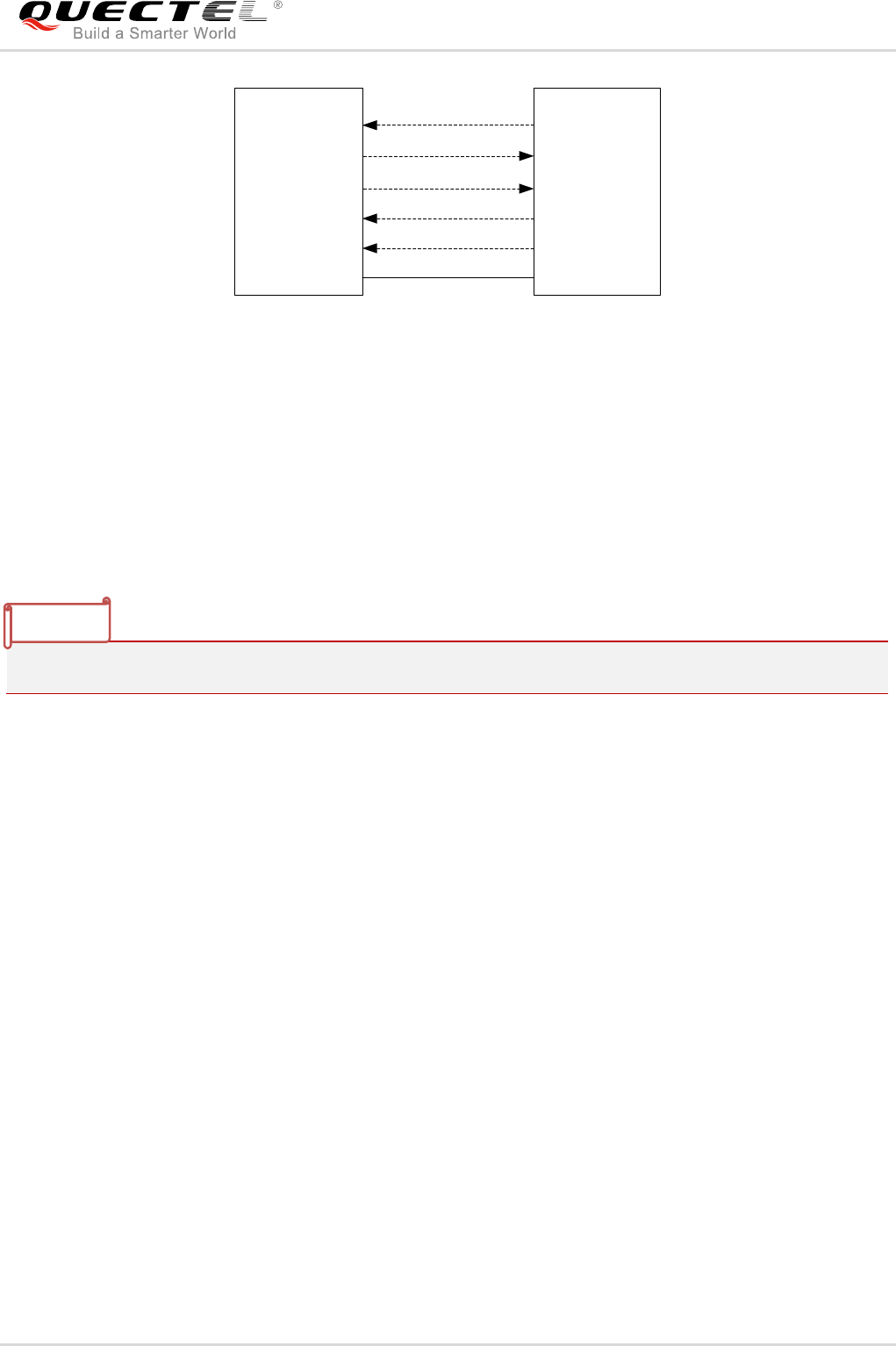
LTE Module Series
EG61-NA Hardware Design
EG61-NA_Hardware_Design 28 / 77
RXD
TXD
RI
DTR
AP_READY
TXD
RXD
EINT
GPIO
GPIO
Module Host
GND GND
Figure 3: Sleep Mode Application via UART
Driving the host DTR to low level will wake up the module.
When EG61-NA has a URC to report, RI signal will wake up the host. Refer to Chapter 3.16 for
details about RI behavior.
AP_READY will detect the sleep state of host (can be configured to high level or low level detection).
Please refer to AT+QCFG="apready"*commandfor details.
“*” means under development.
3.5.1.2. USB Application with USB Remote Wakeup Function
If the host supports USB suspend/resume and remote wakeup functions, the following three preconditions
must be met to let the module enter into sleep mode.
Execute AT+QSCLK=1commandto enable the sleep mode.
Ensure the DTR is held at high level or keep it open.
The host’s USB bus, which is connected with the module’s USB interface, enters into suspended
state.
The following figure shows the connection between the module and the host.
NOTE
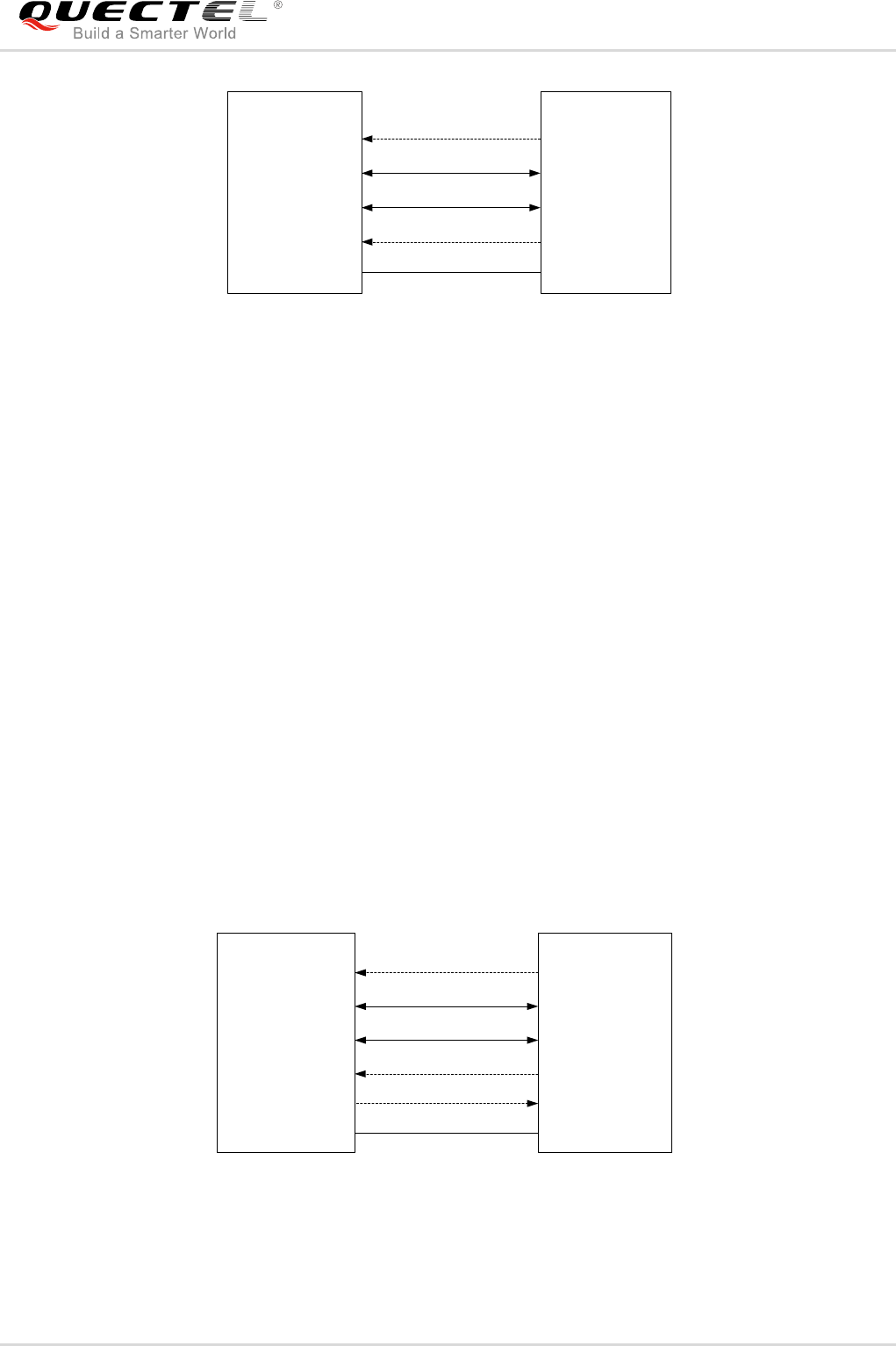
LTE Module Series
EG61-NA Hardware Design
EG61-NA_Hardware_Design 29 / 77
USB_VBUS
USB_DP
USB_DM
AP_READY
VDD
USB_DP
USB_DM
GPIO
Module Host
GND GND
Figure 4: Sleep Mode Application with USB Remote Wakeup
Sending data to EG61-NAthrough USB will wake up the module.
When EG61-NAhas a URC to report, the module will send remote wake-up signals via USB busso as
to wake up the host.
3.5.1.3. USB Application with USB Suspend/Resume and RI Function
If the host supports USB suspend/resume, but does not support remote wake-up function, the RI signal is
needed to wake up the host.
There are threepreconditions to let the module enter into the sleep mode.
Execute AT+QSCLK=1commandto enable sleep mode.
Ensure the DTR is held at high level or keep it open.
The host’s USB bus, which is connected with the module’s USB interface, enters into suspended
state.
The following figure shows the connection between the module and the host.
USB_VBUS
USB_DP
USB_DM
AP_READY
VDD
USB_DP
USB_DM
GPIO
Module Host
GND GND
RI EINT
Figure 5: Sleep Mode Application with RI
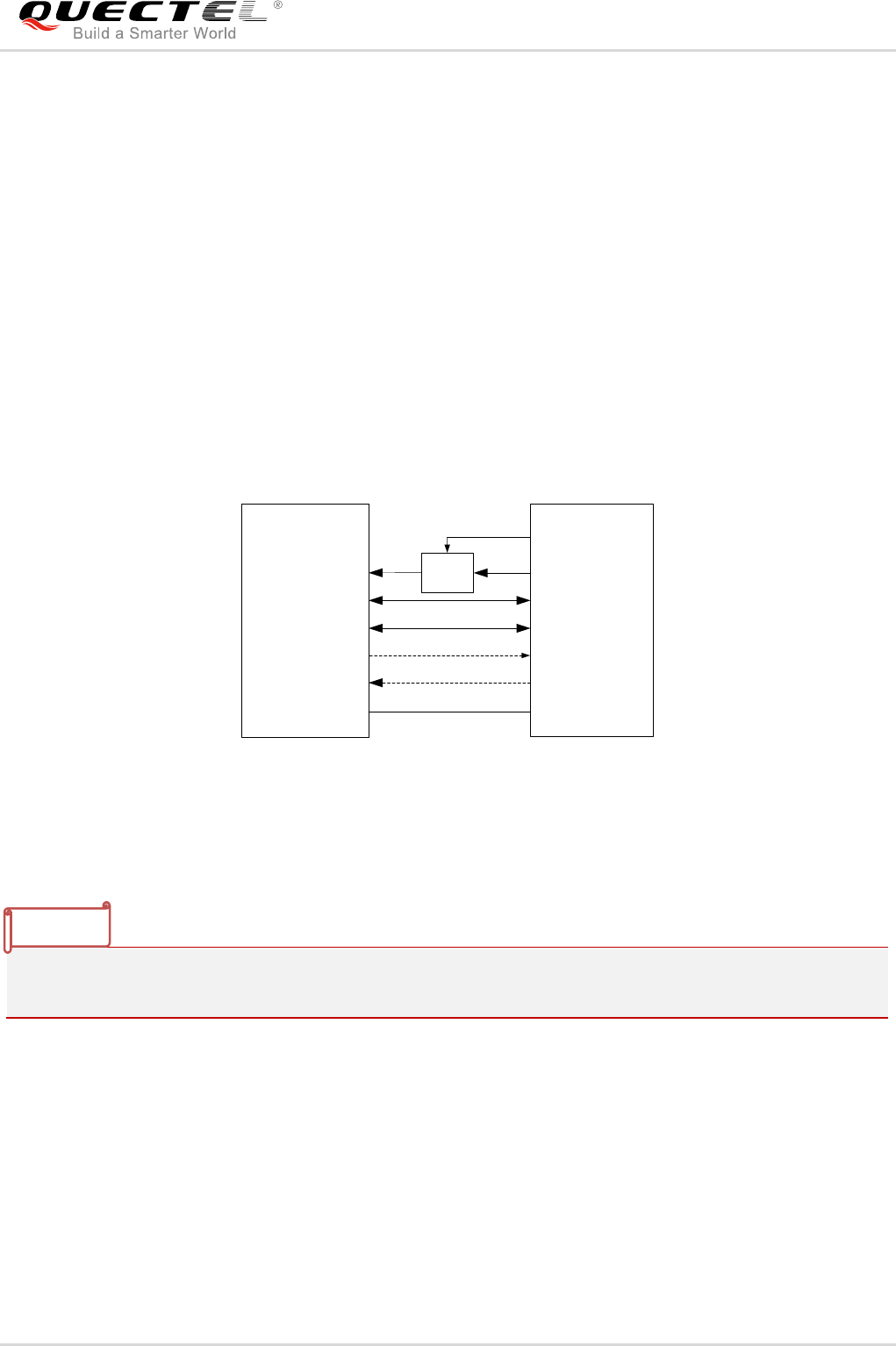
LTE Module Series
EG61-NA Hardware Design
EG61-NA_Hardware_Design 30 / 77
Sending data to EG61-NAthrough USB will wake up the module.
When EG61-NAhas a URC to report, RI signal will wake up the host.
3.5.1.4. USB Application without USB Suspend Function
If the host does not support USB suspend function, USB_VBUS should be disconnected with an
externalcontrol circuit to let the module enter into sleep mode.
Execute AT+QSCLK=1commandto enable the sleep mode.
Ensure the DTR is held at high level or keep it open.
Disconnect USB_VBUS.
The following figure shows the connection between the module and the host.
USB_VBUS
USB_DP
USB_DM
AP_READY
VDD
USB_DP
USB_DM
GPIO
Module Host
RI EINT
Power
Switch
GPIO
GND GND
Figure 6: Sleep Mode Application without Suspend Function
Switching onthe power switch tosupply power to USB_VBUS will wake up the module.
Please pay attention to the level match shown in dotted line between the module and the host.Refer to
document [1] for more details about EG61-NA power management application.
3.5.2. Airplane Mode
When the module enters into airplane mode, the RF function does not work, and all AT commands
correlative with RF function will be inaccessible. This mode can be set viathe following ways.
Hardware:
The W_DISABLE# pin is pulled up by default.Driving it to low level will let the module enter into airplane
mode.
NOTE

LTE Module Series
EG61-NA Hardware Design
EG61-NA_Hardware_Design 31 / 77
Software:
AT+CFUNcommandprovides the choice of functionality levels as shown below:
AT+CFUN=0: Minimum functionality mode.Both (U)SIM and RF functions are disabled.
AT+CFUN=1: Full functionality mode (by default).
AT+CFUN=4: Airplane mode. RF function is disabled.
1. Airplane mode control via W_DISABLE# is disabled in firmware by default. It can be enabled by
AT+QCFG="airplanecontrol" command and this command is under development.
2. The execution of AT+CFUN command will not affect GNSS function.
3.6. Power Supply
3.6.1. Power Supply Pins
EG61-NA provides four VBAT pins for connection with anexternal power supply. There are two separate
voltage domains for VBAT.
Two VBAT_RF pins for module’sRF part.
Two VBAT_BB pins for module’s baseband part.
The following table shows the details of VBAT pins and ground pins.
Table 6: VBAT and GND Pins
Pin Name Pin No. Description Min. Typ. Max. Unit
VBAT_RF 52,53 Power supply for module’s
RF part. 3.3 3.8 4.3 V
VBAT_BB 32,33 Power supply for module’s
baseband part. 3.3 3.8 4.3 V
GND
3, 31, 48,50,
54, 55,58, 59,
61,62, 67~74,
79~82,89~91,
100~106
Ground - 0 - V
NOTES
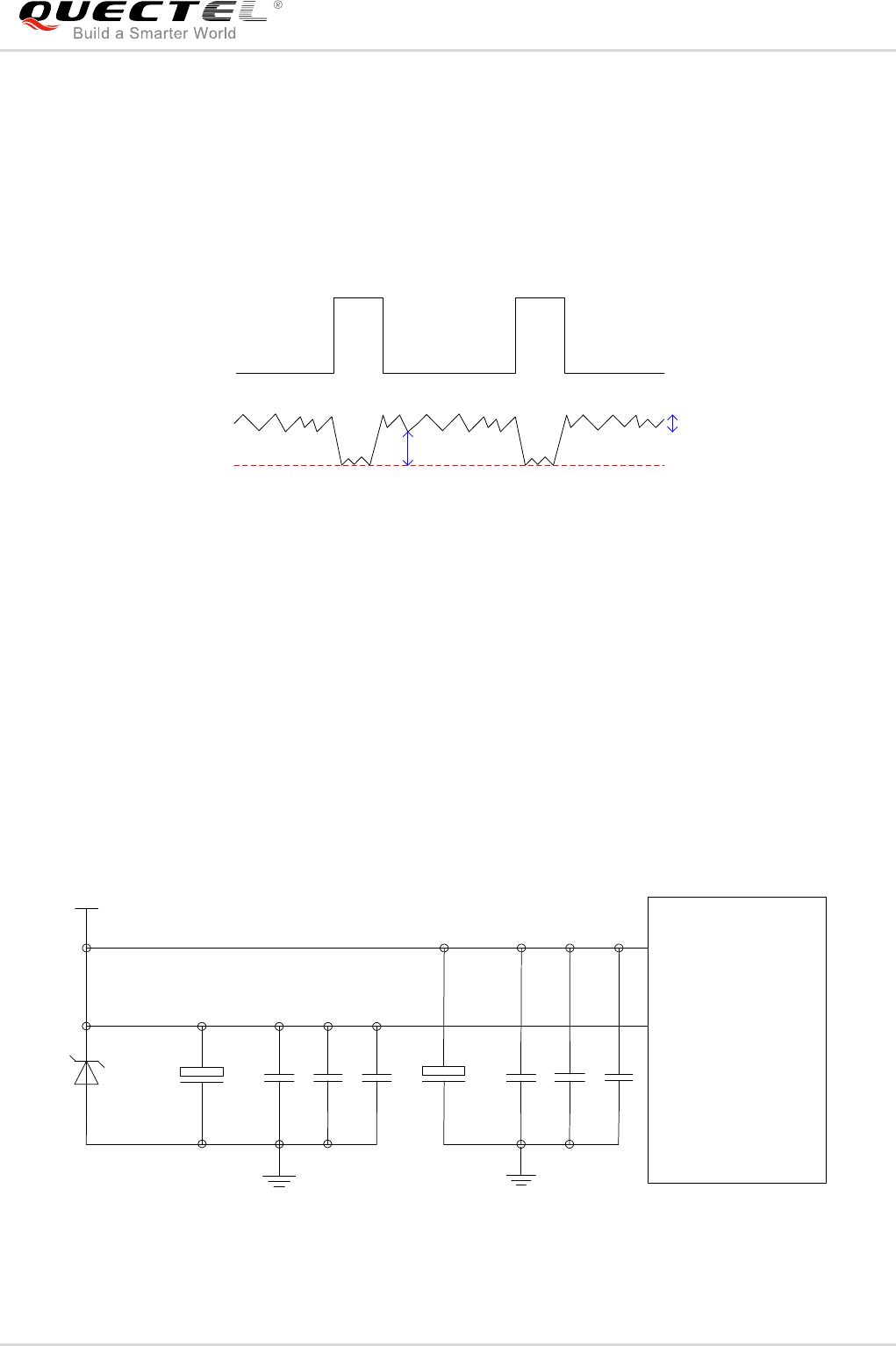
LTE Module Series
EG61-NA Hardware Design
EG61-NA_Hardware_Design 32 / 77
3.6.2. Decrease Voltage Drop
The power supply range of the module is from 3.3Vto4.3V. Please make sure thatthe input voltage will
never drop below 3.3V. The following figure shows the voltage drop during burst transmission in 2G
network.The voltage drop will be less in 3G and 4G networks.
VBAT
Min.3.3V
Ripple
Drop
Burst
Transmission
Burst
Transmission
Figure 7: Power Supply Limits during Burst Transmission
To decrease voltage drop, a bypass capacitor of about 100µF with low ESR(ESR=0.7Ω) should be used,
and amulti-layer ceramic chip (MLCC) capacitor array should also be reserved due to its ultra-low ESR. It
is recommended to usethree ceramic capacitors (100nF, 33pF, 10pF)for composing the MLCC array, and
place these capacitors close to VBAT_BB/VBAT_RF pins. The main power supply from an external
application has to be a single voltage source and can be expanded to two sub paths with star structure.
The width of VBAT_BB trace should be no less than 1mm, andthe width of VBAT_RF trace should be no
less than 2mm.In principle, the longerthe VBAT trace is, the wider it will be.
In addition, in order to get a stable power source,it is recommended to use a TVS diode of Model
WS4.5D3HV. The following figure shows the star structure of the power supply.
Module
VBAT_RF
VBAT_BB
VBAT
C1
100uF
C6
100nF
C7
33pF
C8
10pF
+
+
C2
100nF
C5
100uF
C3
33pF
C4
10pF
D1
Figure 8: Star Structure of the Power Supply
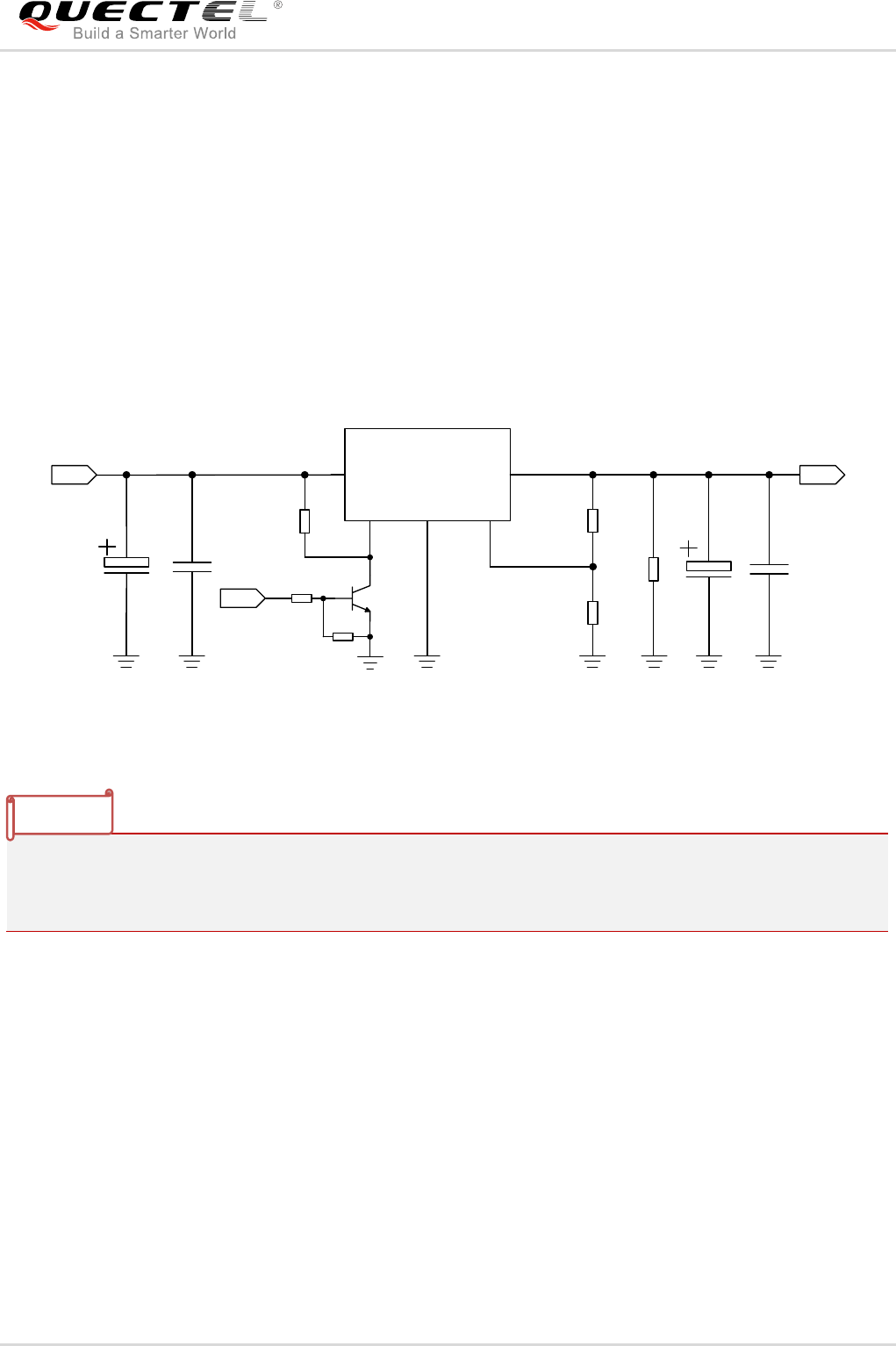
LTE Module Series
EG61-NA Hardware Design
EG61-NA_Hardware_Design 33 / 77
3.6.3. Reference Design for Power Supply
Power design for the module is very important, asthe performance of the module largely depends on the
power source. The power supply should be able to provide sufficient current up to 2A at least. If the
voltage drop between the input and output is not too high, it is suggested that an LDO should be usedto
supply power for the module. If there is a big voltage difference between the input source and the desired
output (VBAT), a buck converter is preferred to be used as the power supply.
The following figure shows a reference design for +5V input power source. The typicaloutput ofthe power
supply is about 3.8V and the maximum load current is 3A.
DC_IN
MIC29302WU
IN OUT
EN
GND
ADJ
2 4
1
3
5
VBAT
100nF 470uF 100nF
100K
47K
470uF
470R
51K 1%
1%
4.7K
47K
VBAT_EN
Figure 9: Reference Circuit of Power Supply
In order to avoid damaging internal flash, please do not switch off the power supply when the module
works normally. Only after the module is shutdown by PWRKEY or AT command, the power supply can be
cut off.
3.6.4. Monitor the Power Supply
AT+CBC command can be used to monitor the VBAT_BB voltage value. For more details, please refer to
document [2].
3.7. Turn-on and off Scenarios
3.7.1. Turn on Module Using the PWRKEY
The following table shows the pin definitionof PWRKEY.
NOTE
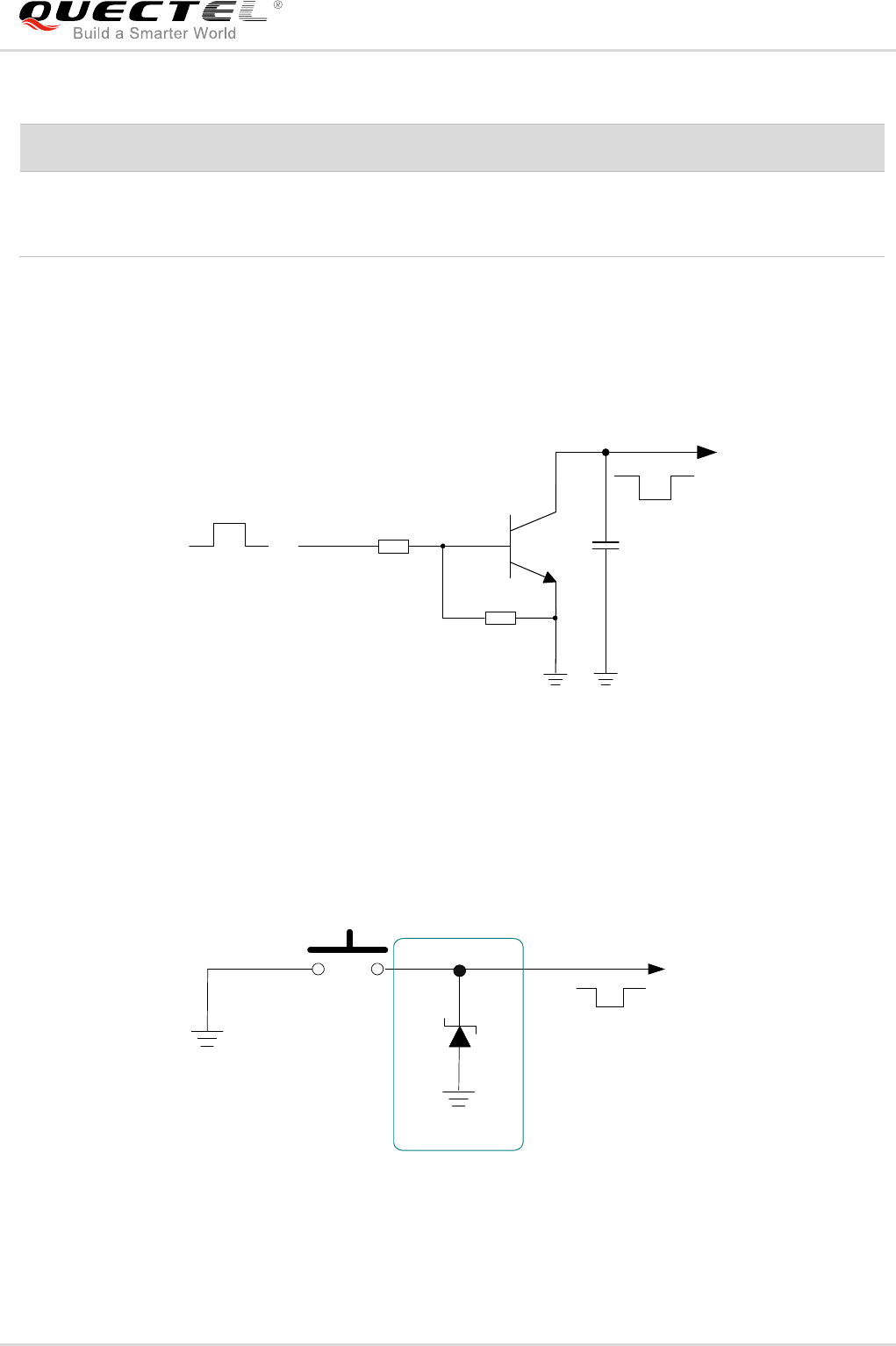
LTE Module Series
EG61-NA Hardware Design
EG61-NA_Hardware_Design 34 / 77
Table 7: Pin Definition of PWRKEY
Pin Name Pin No. Description DC Characteristics Comment
PWRKEY 15 Turn on/off the module
VIHmax=2.1V
VIHmin=1.3V
VILmax=0.5V
The output voltage is 0.8V
because of the diode drop in
the Qualcomm chipset.
When EG61-NA is in powerdownmode, it can be turned on to normal mode by driving the PWRKEY pin to
a low level for at least 500ms. It is recommended to use an open drain/collector driver to control the
PWRKEY.After STATUS pin outputting a high level, PWRKEY pin can be released. A simple reference
circuit is illustrated in the following figure.
Turn on pulse
PWRKEY
4.7K
47K
≥ 500ms
10nF
Figure 10: Turn on the Module Using Driving Circuit
Another way to control the PWRKEY is using a button directly. When pressing the key, electrostatic strike
may generate from the finger. Therefore, aTVS component is indispensable to be placed nearby the
button for ESD protection. A reference circuit is shownin the following figure.
PWRKEY
S1
Close to S1
TVS
Figure 11: Turn on the Module Using Button
The turn on scenario is illustrated in the following figure.
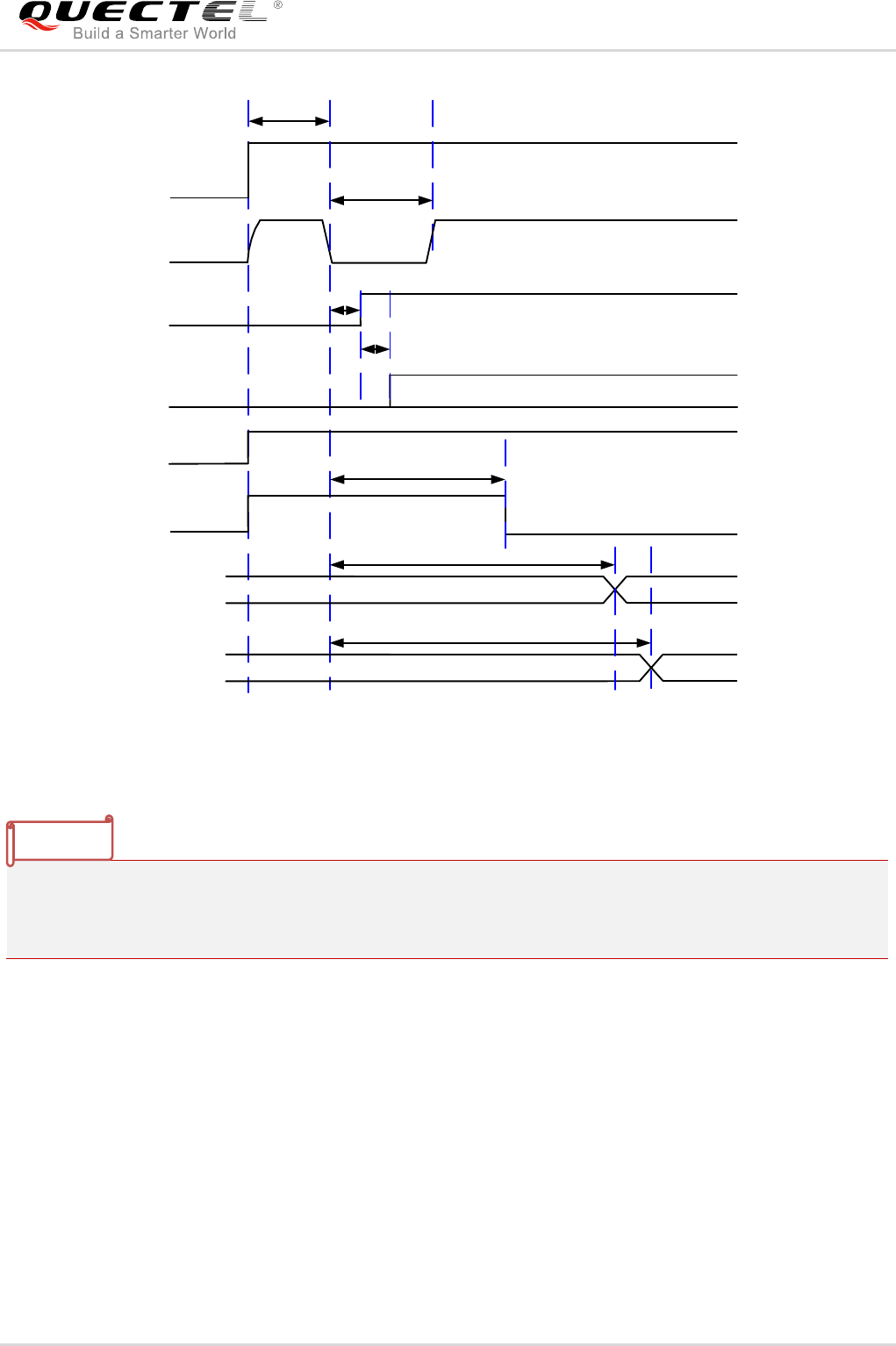
LTE Module Series
EG61-NA Hardware Design
EG61-NA_Hardware_Design 35 / 77
V
IL
≤0.5V
V
IH
≥1.3V
VBAT
PWRKEY
≥500ms
RESET_N
STATUS
(OD)
InactiveActive
UART
NOTE
InactiveActive
USB
≥2.5s
≥12s
≥13s
VDD_EXT
About 100ms
BOOT_CONFIG &
USB_BOOT PINS
≥100ms, after this time, the BOOT_CONFIG
pins can be set high level by external circuit
Figure 12: Timing of Turning on Module
1. Please make sure that VBAT is stable before pulling down PWRKEY pin, and the time between them
is no less than 30ms.
2. The recommended pull-up level range is 1.3V~2.1V if a pull-up circuit is added on PWRKEY pin.
3.7.2. Turn off Module
Either of the following methodscan be used to turn off the module:
Normal power down procedure: Turn off the module using the PWRKEY pin.
Normal power down procedure: Turn off the module using AT+QPOWDcommand.
NOTES
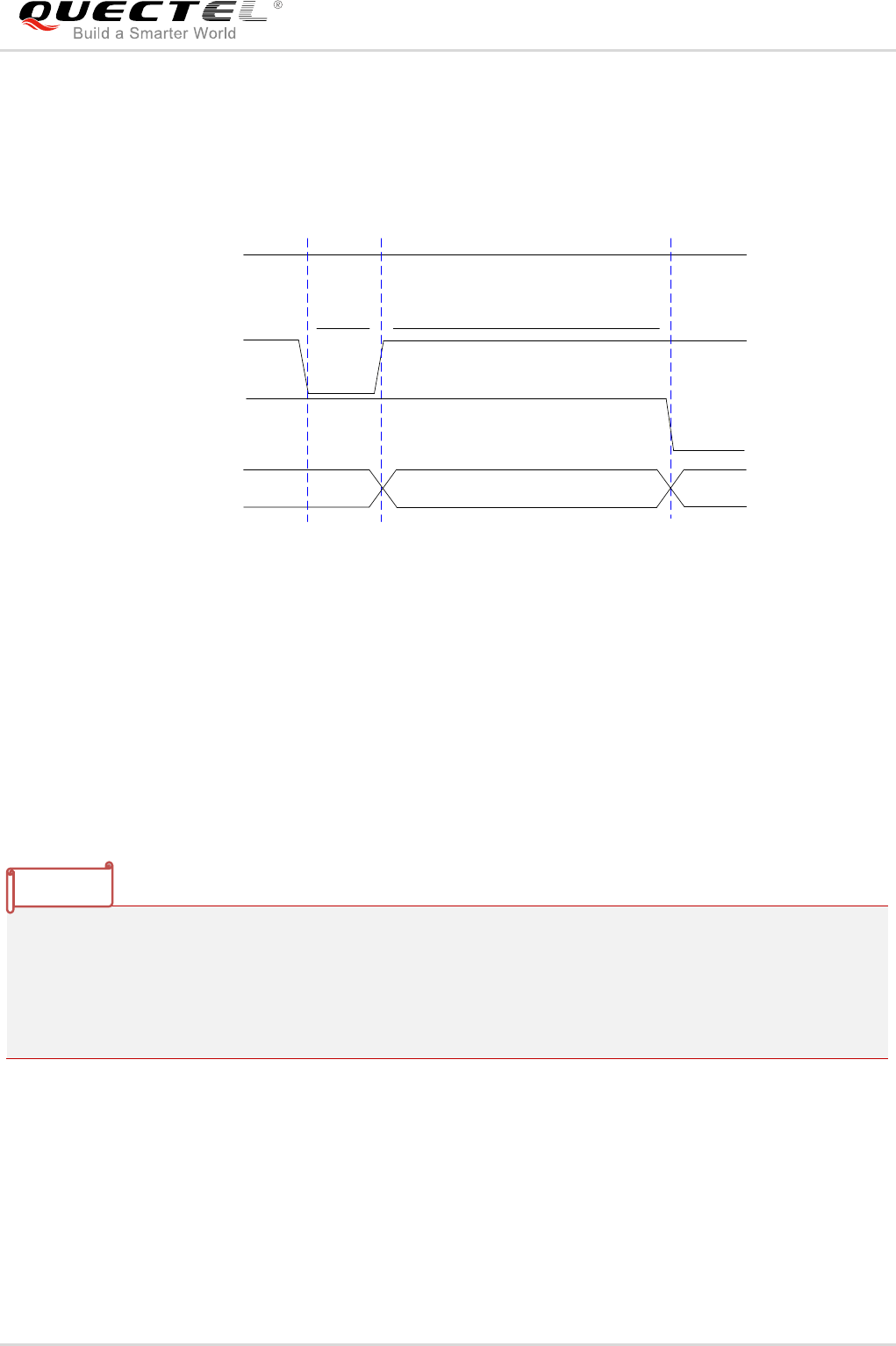
LTE Module Series
EG61-NA Hardware Design
EG61-NA_Hardware_Design 36 / 77
3.7.2.1. Turn off Module Using the PWRKEY Pin
Driving the PWRKEY pin to a low level voltage for at least 650ms, the module will execute power-down
procedure after the PWRKEY is released. The power-down scenario is illustrated inthe following figure.
VBAT
PWRKEY
≥ 30s
≥ 650ms
RUNNING Power-down procedure OFF
Module
Status
STATUS
Figure 13: Timing of Turning off Module
3.7.2.2. Turn off Module Using AT Command
It is also a safe way to use AT+QPOWDcommandto turn off the module, which is similar to turning off the
module via PWRKEY pin.
Please refer todocument [2] for details about the AT+QPOWDcommand.
1. In order to avoid damaging internal flash, please do not switch off the power supply when the module
works normally. Only after the module is shut down by PWRKEY or AT command, the power supply
can be cut off.
2. When turning off module with AT command, please keep PWRKEY at high level after the execution of
power-off command. Otherwise the module will be turned on again after successful turn-off.
3.8. Reset the Module
The RESET_N pin can be used to reset the module.The module can be reset by driving RESET_N to a
low level voltage for 150ms~460ms.
NOTES
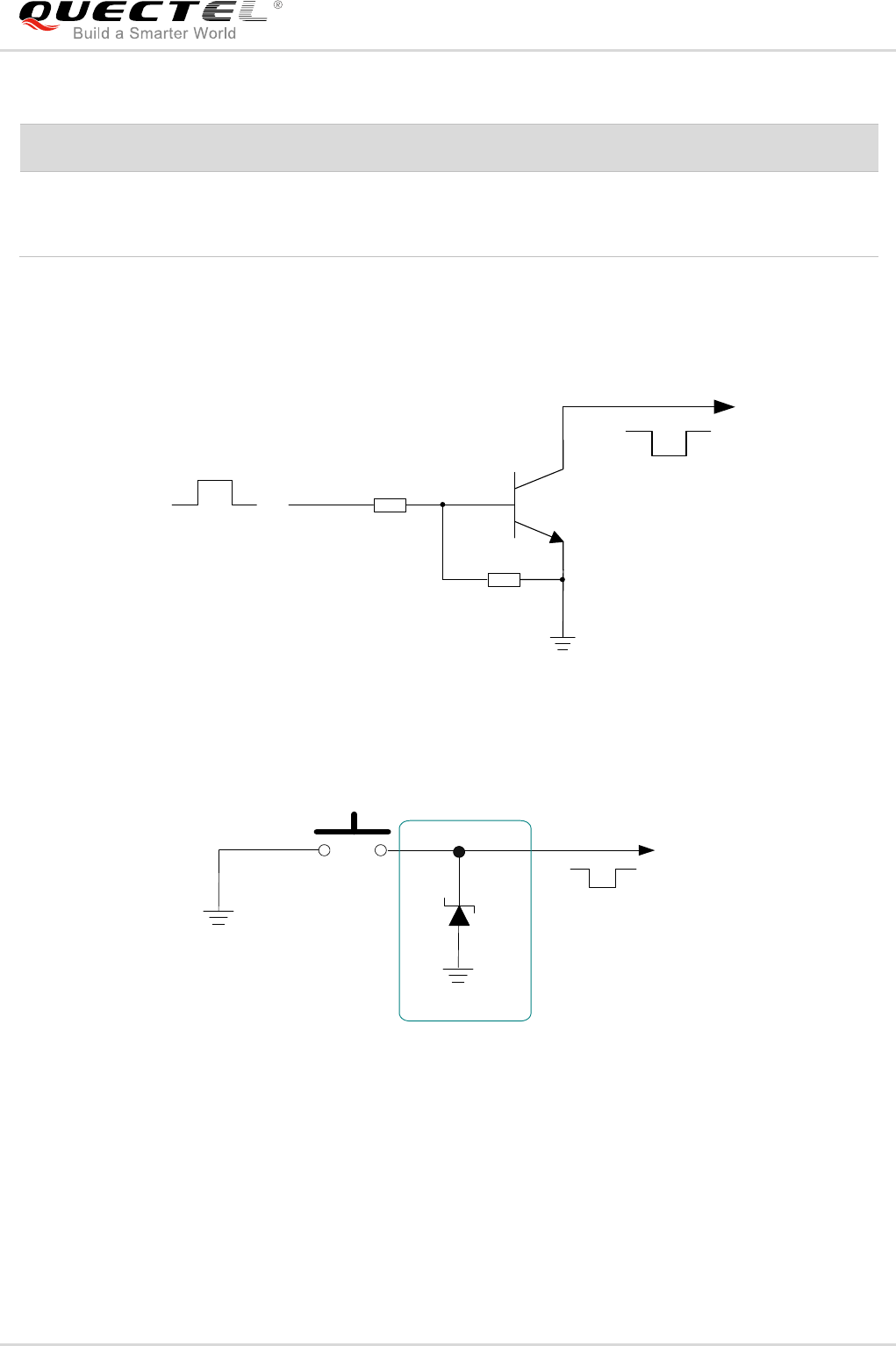
LTE Module Series
EG61-NA Hardware Design
EG61-NA_Hardware_Design 37 / 77
Table 8: Pin Definition of RESET_N
Pin Name Pin No. Description DC Characteristics Comment
RESET_N 17 Reset the module
VIHmax=2.1V
VIHmin=1.3V
VILmax=0.5V
The recommended circuit is similar to the PWRKEY control circuit. An open drain/collector driver or button
can be used to control the RESET_N.
Reset pulse
RESET_N
4.7K
47K
150ms~460ms
Figure 14: Reference Circuit of RESET_N by Using Driving Circuit
RESET_N
S2
Close to S2
TVS
Figure 15: Reference Circuit of RESET_N by Using Button
The reset scenario is illustrated inthe following figure.
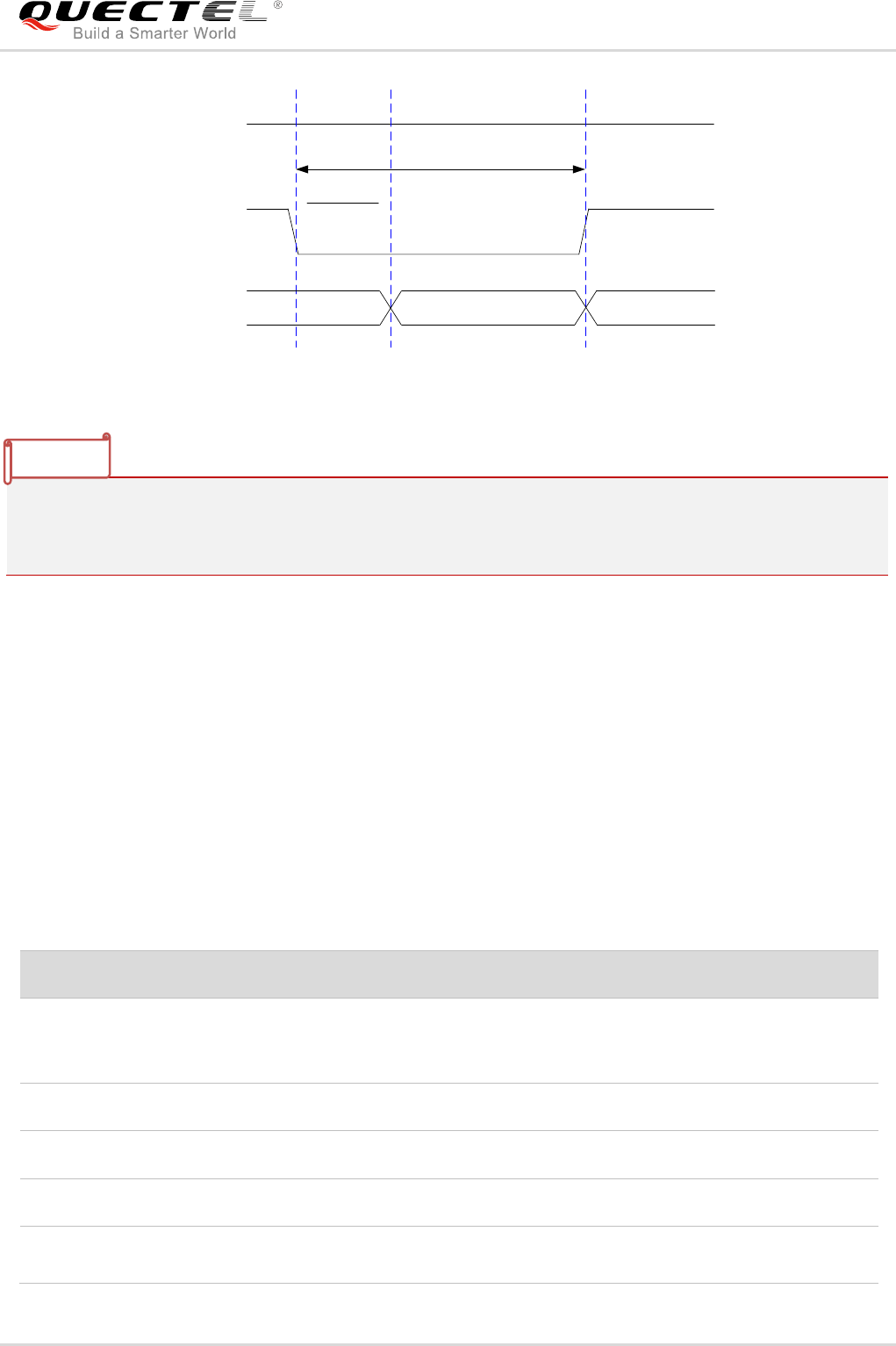
LTE Module Series
EG61-NA Hardware Design
EG61-NA_Hardware_Design 38 / 77
VIL ≤ 0.5V
VIH ≥ 1.3V
VBAT
≥ 150ms
Resetting
Module
Status
Running
RESET_N
Restart
≤ 460ms
Figure 16: Timing of Resetting Module
1. RESET_N is only used when the module fails to be shut down via AT+QPOWD command and the
PWRKEY pin.
2. Ensure that there is no large capacitance on PWRKEY and RESET_N pins.
3.9. (U)SIM Interfaces
EG61-NAprovides two (U)SIMinterfaces, andonly one (U)SIMcard can work at a time.The (U)SIM1 and
(U)SIM2cardscan be switched by AT+QDSIM*command.For more details, please refer to document [2].
The(U)SIMinterfacescircuitrymeet ETSI and IMT-2000 requirements. Both 1.8V and 3.0V (U)SIMcards
are supported.
Table 9: Pin Definition of (U)SIMInterfaces
Pin Name Pin No. I/O Description Comment
USIM1_VDD 43 PO Power supply for (U)SIM1 card
Either 1.8V or 3.0V is
supported by the module
automatically.
USIM1_DATA 45 IO Data signal of (U)SIM1 card
USIM1_CLK 46 DO Clock signal of (U)SIM1card
USIM1_RST 44 DO Reset signal of (U)SIM1 card
USIM1_
PRESENCE 42 DI (U)SIM1 card insertion detection
NOTES
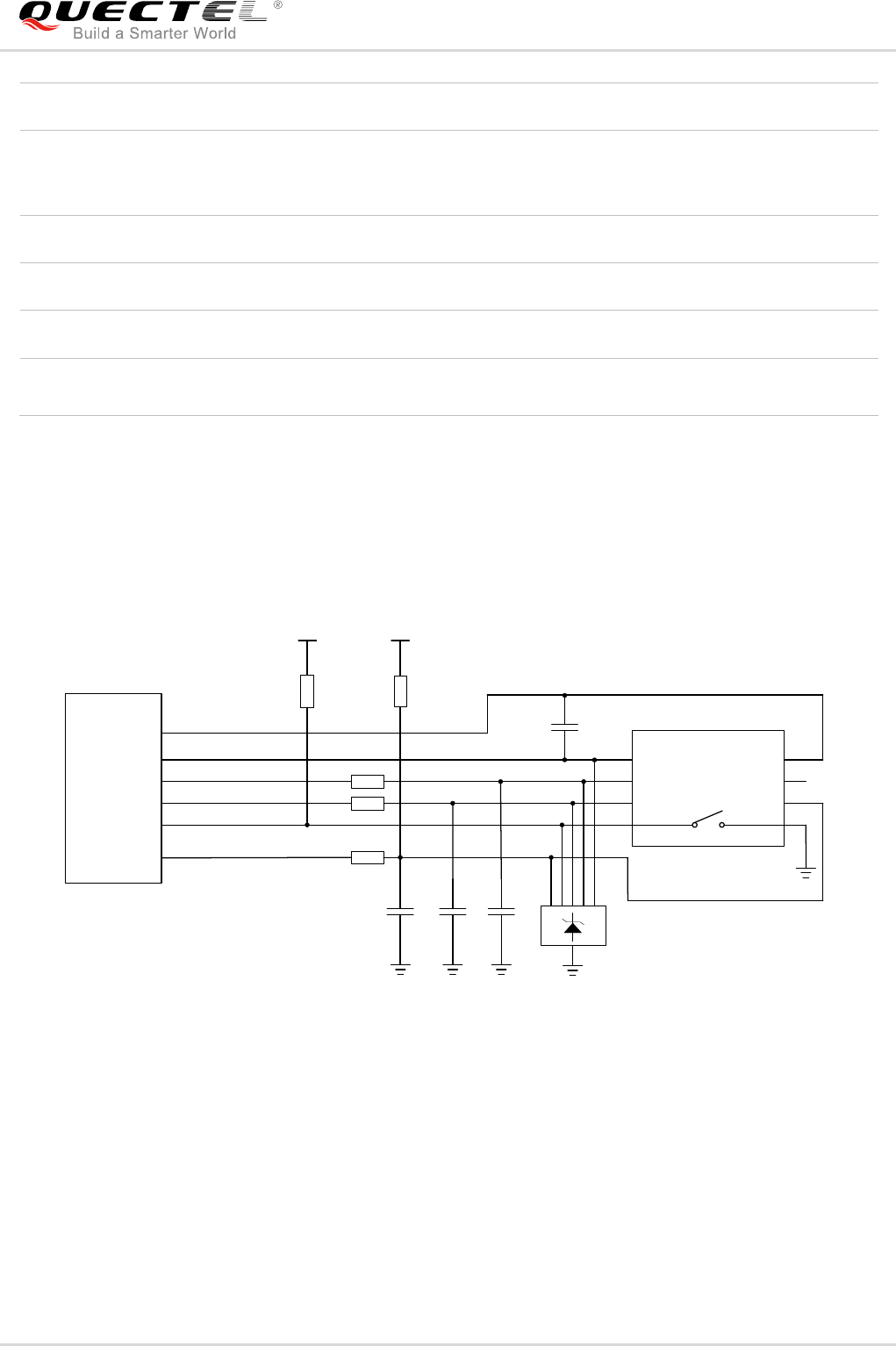
LTE Module Series
EG61-NA Hardware Design
EG61-NA_Hardware_Design 39 / 77
USIM_GND 47 Specified ground for (U)SIMcard
USIM2_VDD 87 PO Power supply for (U)SIM2 card
Either 1.8V or 3.0V is
supported by the module
automatically.
USIM2_DATA 86 IO Data signal of (U)SIM2 card
USIM2_CLK 84 DO Clock signal of (U)SIM2 card
USIM2_RST 85 DO Reset signal of (U)SIM2 card
USIM2_
PRESENCE 83 DI (U)SIM2 card insertion detection
EG61-NA supports (U)SIMcard hot-plug via the USIM_PRESENCE
(USIM1_PRESENCE/USIM2_PRESENCE) pin. The functionsupports low level and high level detections,
andis disabled by default. Pleaserefer to document [2] about AT+QSIMDETcommand for details.
The following figure shows a reference design for (U)SIM interface with an8-pin (U)SIMcard connector.
Module
USIM_VDD
USIM_GND
USIM_RST
USIM_CLK
USIM_DATA
USIM_PRESENCE
0R
0R
0R
VDD_EXT
51K
100nF
GND
GND
33pF 33pF 33pF
VCC
RST
CLK IO
VPP
GND
GND
USIM_VDD
15K
(U)SIM Card Connector
Figure 17: Reference Circuitof (U)SIMInterface with an 8-Pin (U)SIMCard Connector
If (U)SIM card detection function is not needed, please keep USIM_PRESENCE unconnected.
Areference circuit of (U)SIM interface with a 6-pin (U)SIMcard connector is illustrated inthe following
figure.
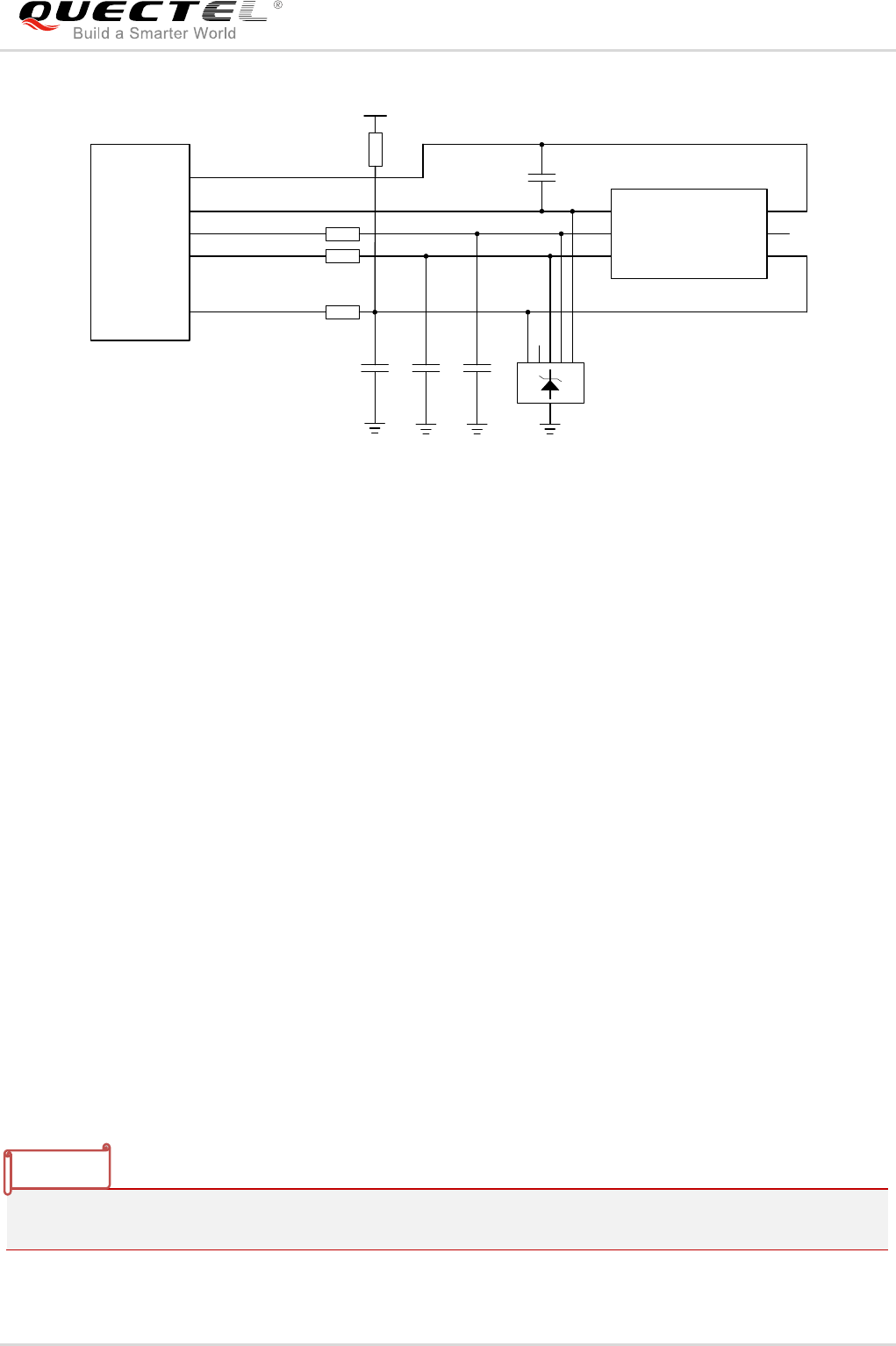
LTE Module Series
EG61-NA Hardware Design
EG61-NA_Hardware_Design 40 / 77
Module
USIM_VDD
USIM_GND
USIM_RST
USIM_CLK
USIM_DATA 0R
0R
0R
100nF
GND
33pF 33pF 33pF
VCC
RST
CLK IO
VPP
GND
GND
15K
USIM_VDD
(U)SIM Card Connector
Figure 18: Reference Circuitof (U)SIM Interface with a 6-Pin (U)SIM Card Connector
In order to enhance the reliability and availability of the (U)SIM card in customers’ applications, please
follow the criteria below in the (U)SIM circuit design:
Keep placement of (U)SIM card connector as close to the module as possible. Keep the trace length
as less than 200mm as possible.
Keep (U)SIM card signals away from RF and VBAT traces.
Assure the ground trace between the module and the (U)SIMcard connector short and wide. Keep
the trace width of ground and USIM_VDD no less than 0.5mm to maintain the same electric potential.
Make sure the bypass capacitor between USIM_VDD and USIM_GND less than 1uF, and place it as
close to (U)SIM card connector as possible.If the ground is complete on customers’ PCB,
USIM_GND can be connected to PCB ground directly.
To avoid cross-talk between USIM_DATA and USIM_CLK, keep them away from each other and
shield them with surrounded ground.
In order to offer good ESD protection, it is recommended to add a TVS diode array whose parasitic
capacitance should not be more than 15pF. The 0Ω resistors should be added in series between the
module and the (U)SIM card to facilitatedebugging. The 33pF capacitors are used for filtering
interference of GSM900MHz.Please note that the (U)SIM peripheral circuit should be close to the
(U)SIMcard connector.
The pull-up resistor on USIM_DATA line can improve anti-jamming capability when long layout trace
and sensitive occasion are applied, and should be placed close to the (U)SIM card connector.
“*” means under development.
NOTE
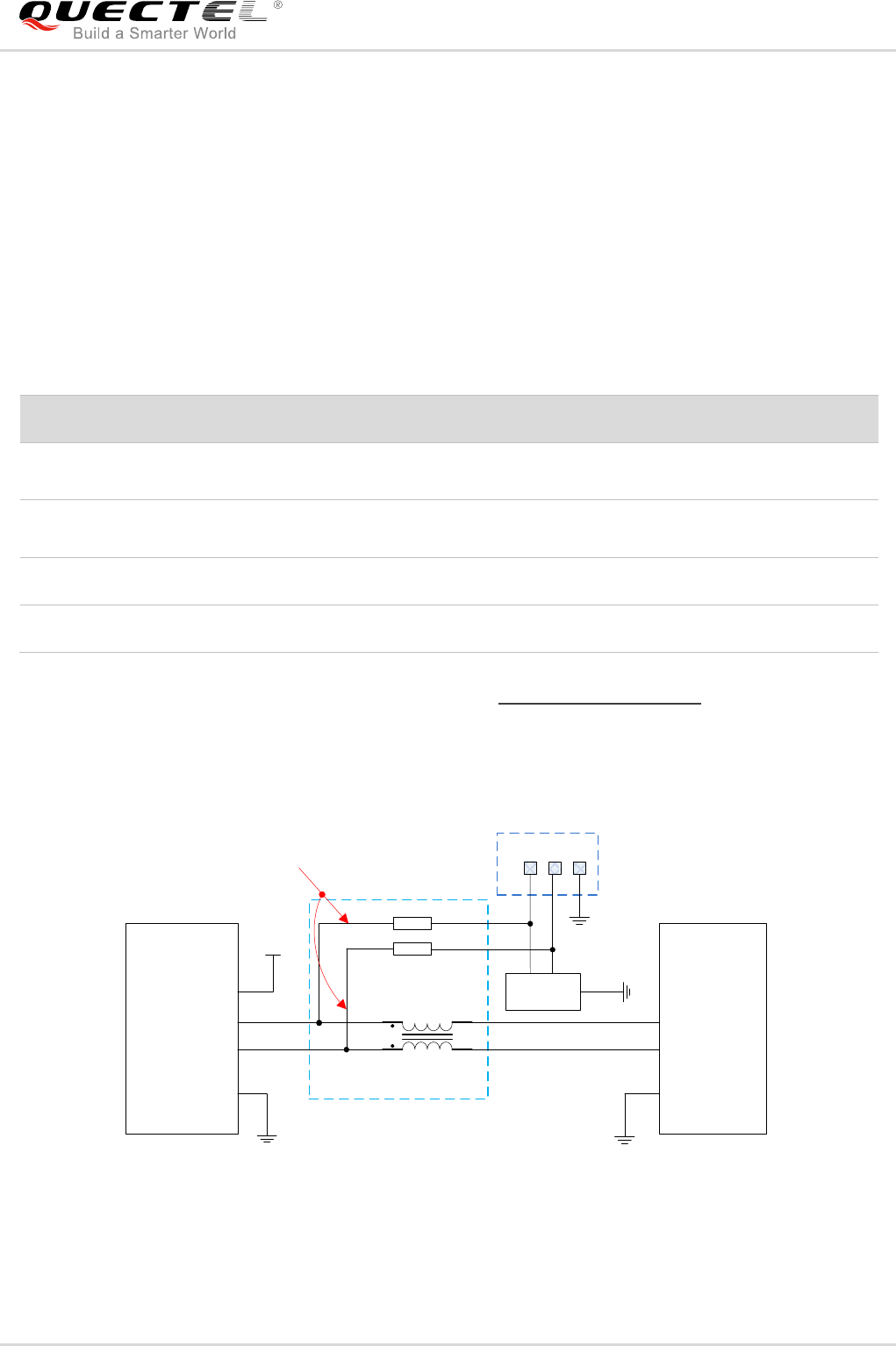
LTE Module Series
EG61-NA Hardware Design
EG61-NA_Hardware_Design 41 / 77
3.10. USB Interface
EG61-NA contains one integrated Universal Serial Bus (USB) interfacewhich complies with the USB 2.0
specification and supports high-speed (480Mbps) and full-speed (12Mbps) modes. The USB interface is
used for AT command communication, data transmission, GNSS NMEA sentences output,software
debugging, firmware upgrade and voice over USB*. The following table shows the pin definition of USB
interface.
Table 10: Pin Definition of USB Interface
Pin Name Pin No. I/O Description Comment
USB_DP 9 IO USB differential data bus (+) Require differential
impedance of 90Ω.
USB_DM 10 IO USB differential data bus (-) Require differential
impedance of 90Ω.
USB_VBUS 8 PI USB detection Typically 5.0V
GND 3 Ground
More details about the USB 2.0 specifications, please visit http://www.usb.org/home.
The USB interface is recommended to be reserved for firmware upgrade in customers’ design. The
following figure shows areference circuit of USB interface.
USB_DP
USB_DM
GND
USB_DP
USB_DM
GND
L1
Close to Module
R3
R4
Test Points
ESD Array
NM_0R
NM_0R
Minimize these stubs
Module MCU
USB_VBUS
VDD
Figure 19: Reference Circuit of USB Interface

LTE Module Series
EG61-NA Hardware Design
EG61-NA_Hardware_Design 42 / 77
A common mode choke L1 is recommended to be added in series between the module and
customer’sMCU in order to suppress EMI spurious transmission. Meanwhile, the 0Ω resistors (R3 and R4)
should beadded in series between the module and the test points so as to facilitate debugging, and the
resistors are
not mounted by default. In order to ensure the integrity of USB data line signal, L1/R3/R4 components
must be placed close to the module, and also these resistors should be placed close to each other.
Theextra stubs of trace must be as short as possible.
The following principles should be complied with when design the USB interface, so as to meet USB 2.0
specification.
It is important to route the USB signal traces as differential pairs with total grounding. The impedance
of USB differential trace is 90Ω.
Do not route signal traces under crystals, oscillators, magnetic devices and RF signal traces. It is
important to route the USB differential traces in inner-layer with ground shielding onnot only upper
and lower layers but also right and left sides.
Pay attention to the influence of junction capacitance of ESD protection component on USB data
lines. Typically, the capacitance value should be less than 2pF.
Keep the ESD protection components to the USB connector as close as possible.
1. EG61-NA module can only be used as a slave device.
2. “*” means under development.
3.11. UART Interfaces
The module provides two UART interfaces: the main UART interface and thedebug UART interface. The
following shows their features.
The main UART interface supports 9600bps, 19200bps, 38400bps, 57600bps, 115200bps,
230400bps, 460800bps and 921600bpsbaud rates, and the default is 115200bps. The interface can
be used for data transmission and AT command communication.
The debug UART interface supports 115200bpsbaud rate. It is used forLinux console and log output.
The following tables show the pin definition of the two UART interfaces.
NOTES

LTE Module Series
EG61-NA Hardware Design
EG61-NA_Hardware_Design 43 / 77
Table 11: Pin Definition of Main UART Interface
Pin Name
Pin No. I/O Description Comment
RI 39 DO Ring indicator
1.8V power domain
DCD 38 DO Data carrier detection
CTS 36 DO Clear to send
RTS 37 DI Request to send
DTR 30 DI Sleep mode control
TXD 35 DO Transmit data
RXD 34 DI Receive data
Table 12: Pin Definition of Debug UART Interface
Pin Name Pin No. I/O Description Comment
DBG_TXD 23 DO Transmit data 1.8V power domain
DBG_RXD 22 DI Receive data 1.8V power domain
The logic levels are described in the following table.
Table 13:Logic Levels of Digital I/O
Parameter Min. Max. Unit
VIL -0.3 0.6 V
VIH 1.2 2.0 V
VOL 0 0.45 V
VOH 1.35 1.8 V
The module provides 1.8V UART interface. A level translator should be used if customers’ application is
equipped with a 3.3V UART interface. A level translator TXS0108EPWR provided by Texas Instruments is
recommended. The following figure shows areference design.
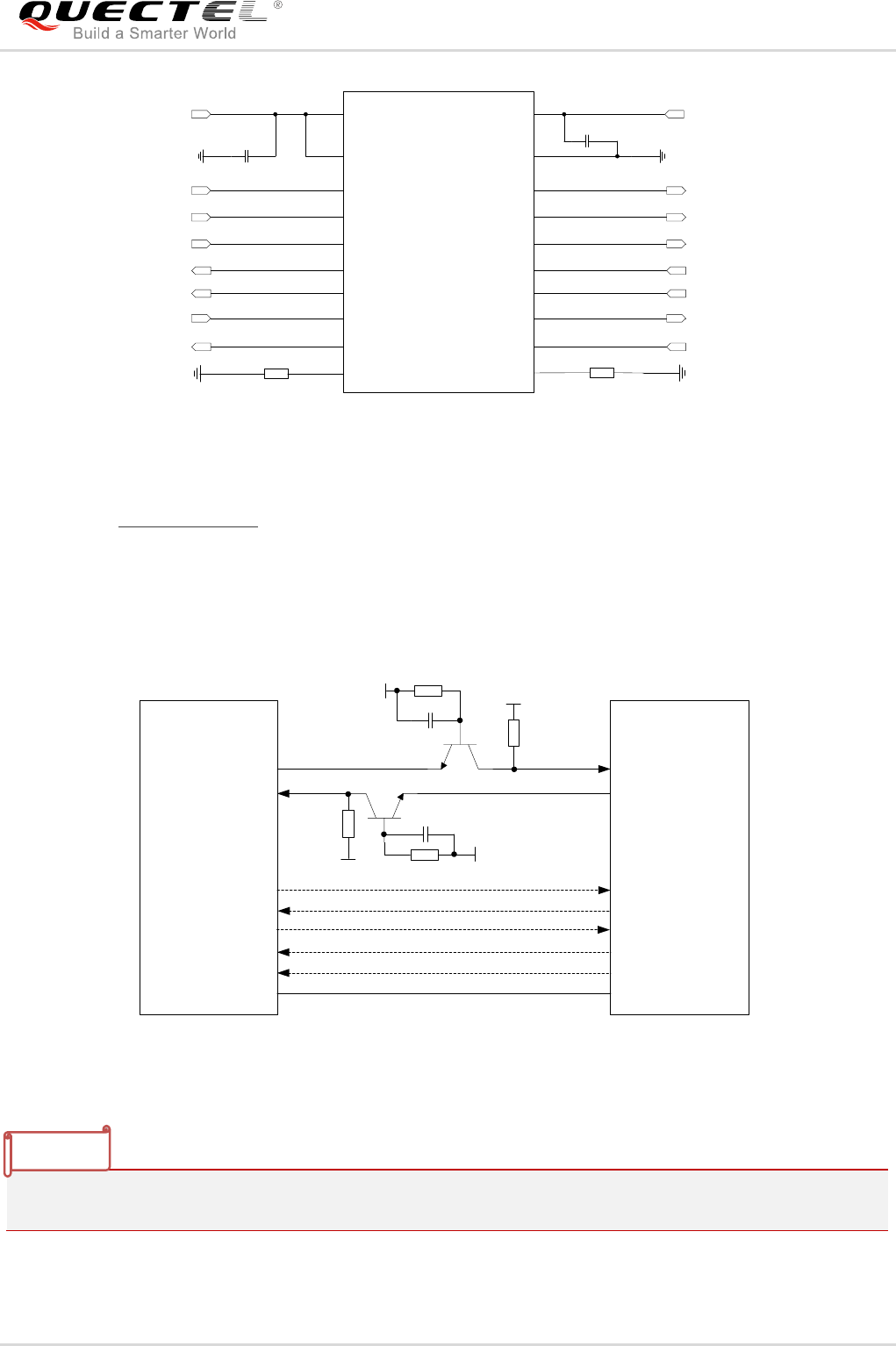
LTE Module Series
EG61-NA Hardware Design
EG61-NA_Hardware_Design 44 / 77
VCCA VCCB
OE
A1
A2
A3
A4
A5
A6
A7
A8
GND
B1
B2
B3
B4
B5
B6
B7
B8
VDD_EXT
RI
DCD
RTS
RXD
DTR
CTS
TXD
51K 51K
0.1uF 0.1uF
RI_MCU
DCD_MCU
RTS_MCU
RXD_MCU
DTR_MCU
CTS_MCU
TXD_MCU
VDD_MCU
Translator
Figure 20: Reference Circuit with Translator Chip
Please visit http://www.ti.com formore information.
Another example with transistor translation circuit is shown as below. Thecircuitdesign of dotted line
section can refer to the circuitdesign of solid linesection, in terms of both module input and output circuit
design. Please pay attention to the direction of connection.
MCU/ARM
TXD
RXD
VDD_EXT
10K
VCC_MCU
4.7K
10K
VDD_EXT
TXD
RXD
RTS
CTS
DTR
RI
RTS
CTS
GND
GPIO DCD
Module
GPIO
EINT
VDD_EXT
4.7K
GND
1nF
1nF
Figure 21: Reference Circuit with Transistor Circuit
Transistor circuit solution is not suitable for applications with high baud rates exceeding 460Kbps.
NOTE
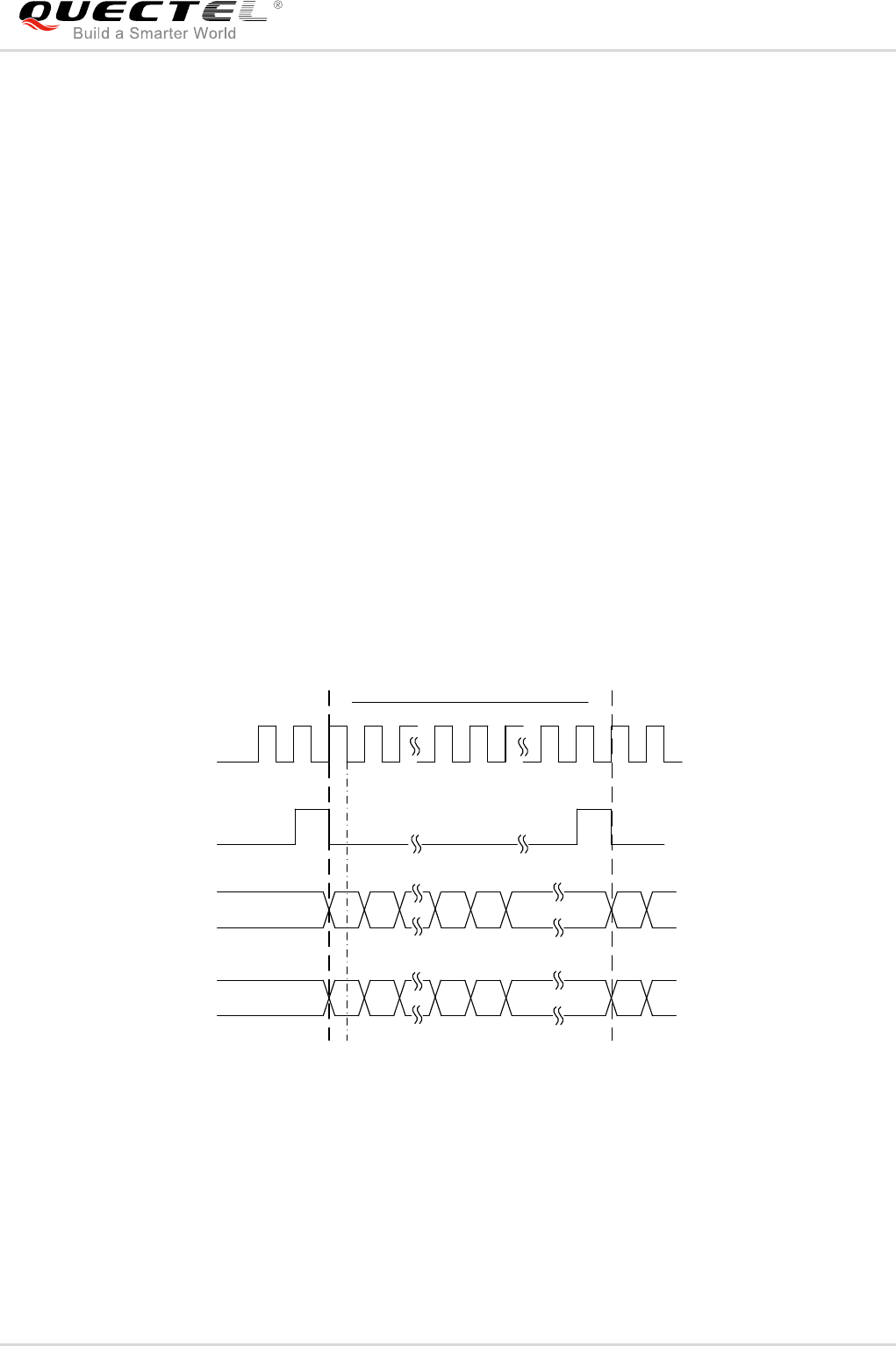
LTE Module Series
EG61-NA Hardware Design
EG61-NA_Hardware_Design 45 / 77
3.12. PCM and I2C Interfaces
EG61-NA provides one Pulse Code Modulation (PCM) digital interface for audio design, which supports
the following modes and one I2C interface:
Primary mode (short frame synchronization, works as both master and slave)
Auxiliary mode (long frame synchronization, works as master only)
In primary mode, the data is sampled on the falling edge of the PCM_CLK and transmitted on the rising
edge. The PCM_SYNC falling edge represents the MSB. In this mode, the PCM interface supports
256kHz, 512kHz, 1024kHz or 2048kHz PCM_CLK at 8kHz PCM_SYNC, and also supports 4096kHz
PCM_CLK at 16kHz PCM_SYNC.
In auxiliary mode, the data is also sampled on the falling edge of the PCM_CLK and transmitted on the
rising edge. The PCM_SYNC rising edge represents the MSB. In this mode, the PCM interface operates
with a 256kHz, 512kHz, 1024kHz or 2048kHz PCM_CLK and an 8kHz, 50% duty cycle PCM_SYNC.
EG61-NA supports 16-bit linear data format. The following figures show theprimary mode’s timing
relationship with 8KHz PCM_SYNC and 2048KHz PCM_CLK, as well asthe auxiliary mode’s timing
relationship with 8KHz PCM_SYNC and 256KHz PCM_CLK.
PCM_CLK
PCM_SYNC
PCM_DOUT
MSB LSB MSB
125us
1 2 256255
PCM_DIN
MSB
LSBMSB
Figure 22: Primary Mode Timing
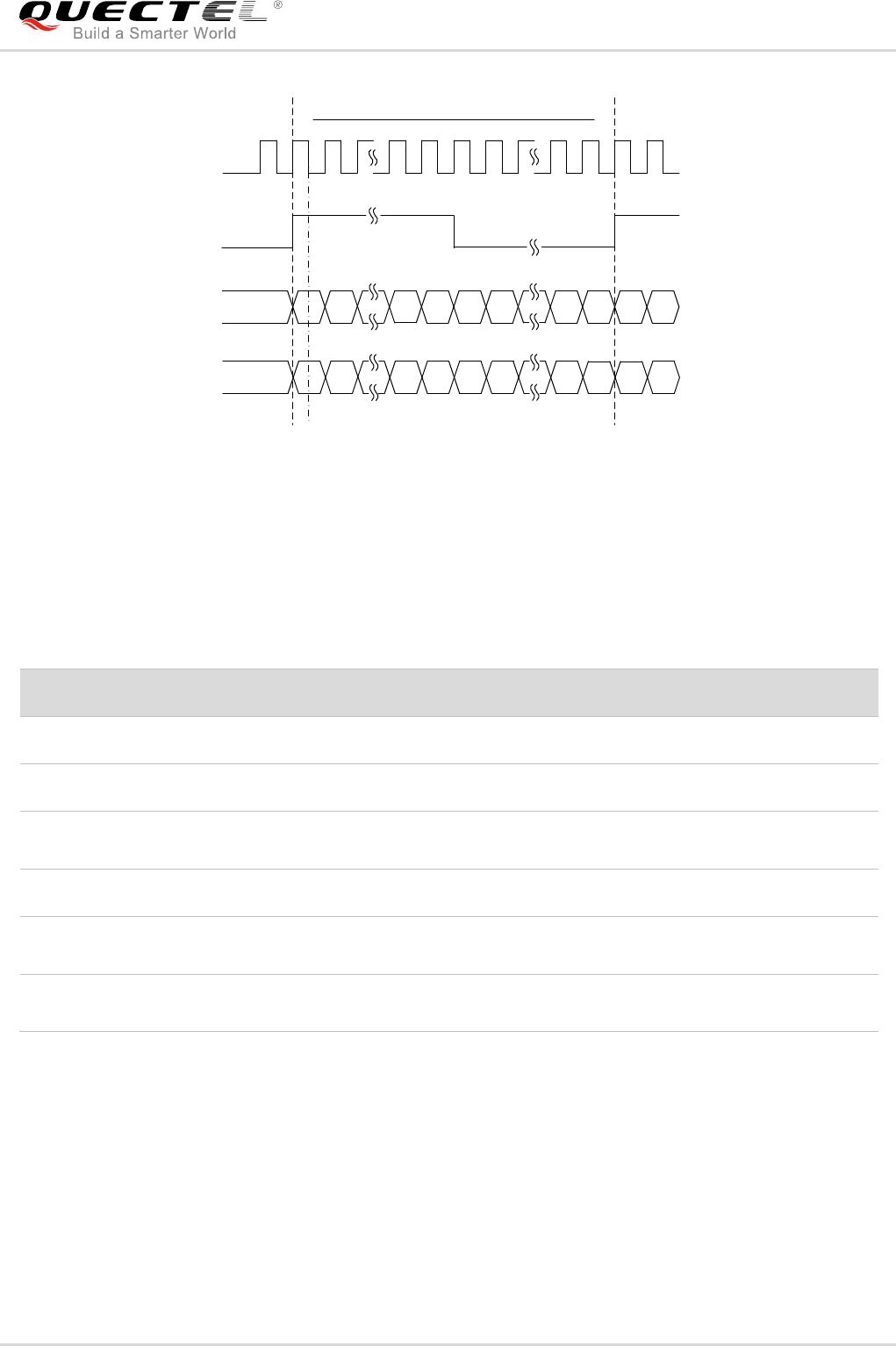
LTE Module Series
EG61-NA Hardware Design
EG61-NA_Hardware_Design 46 / 77
PCM_CLK
PCM_SYNC
PCM_DOUT
MSB LSB
PCM_DIN
125us
MSB
1 2 3231
LSB
Figure 23: Auxiliary Mode Timing
The following table shows the pin definition of PCM and I2C interfaces which can be applied on audio
codec design.
Table 14: Pin Definition of PCM and I2C Interfaces
Pin Name Pin No. I/O Description Comment
PCM_DIN 6 DI PCM data input 1.8V power domain
PCM_DOUT 7 DO PCM data output 1.8V power domain
PCM_SYNC 5 IO PCM data frame
synchronization signal 1.8V power domain
PCM_CLK 4 IO PCM data bit clock 1.8V power domain
I2C_SCL 40 OD I2C serial clock Require an external pull-up to
1.8V
I2C_SDA 41 OD I2C serial data Require an external pull-up to
1.8V
Clock and mode can be configured by AT command, and the default configuration is master mode using
short frame synchronizationformat with 2048KHzPCM_CLK and 8KHz PCM_SYNC.Please refer to
document [2] aboutAT+QDAIcommand for details.
The following figure shows areference design of PCM interface with external codec IC.
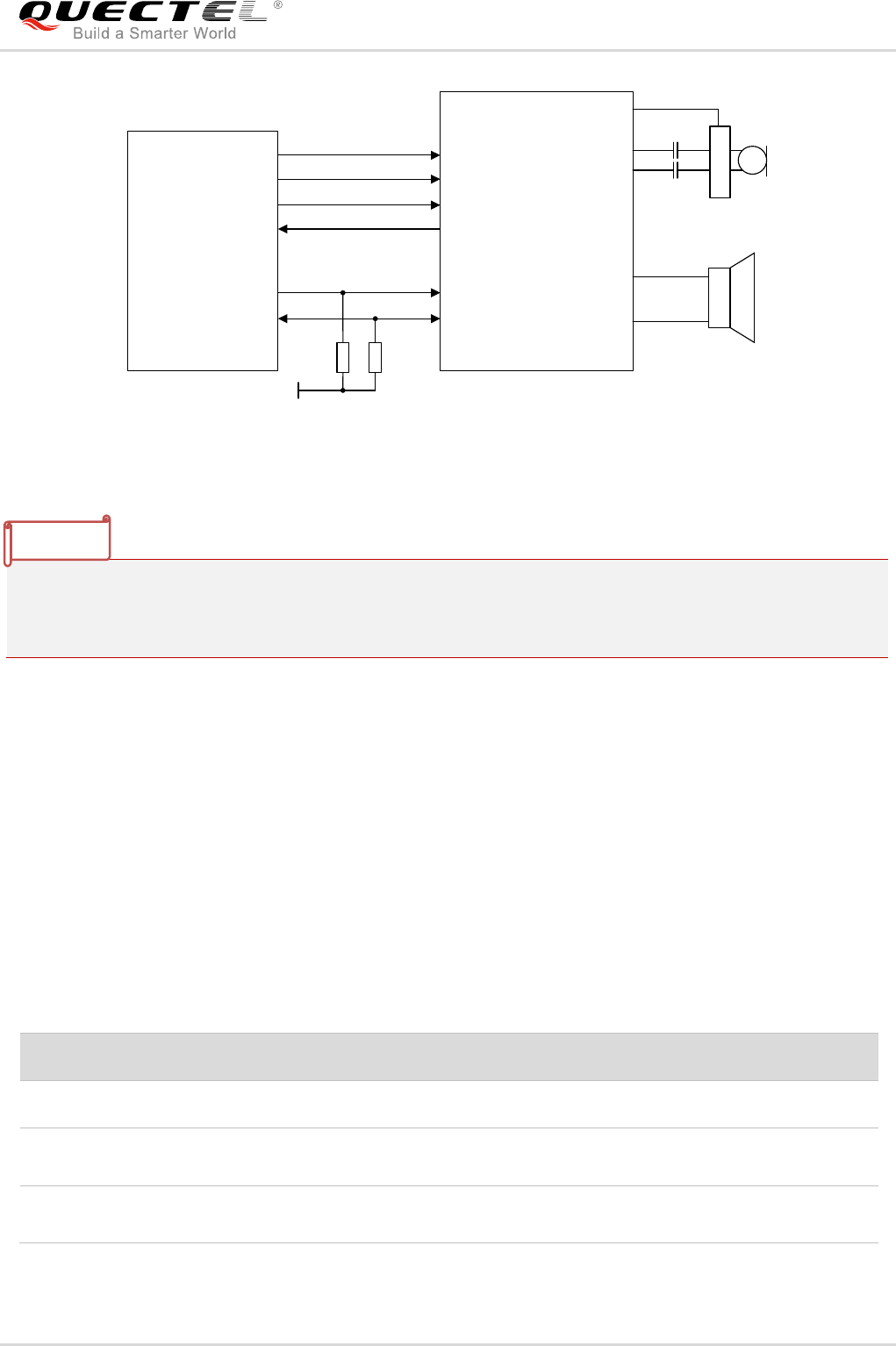
LTE Module Series
EG61-NA Hardware Design
EG61-NA_Hardware_Design 47 / 77
PCM_DIN
PCM_DOUT
PCM_SYNC
PCM_CLK
I2C_SCL
I2C_SDA
Module
1.8V
4.7K
4.7K
BCLK
LRCK
DAC
ADC
SCL
SDA
BIAS
MICBIAS
INP
INN
LOUTP
LOUTN
Codec
Figure 24: Reference Circuit of PCM Application with Audio Codec
1. It is recommended to reserve RC (R=22Ω, C=22pF) circuit on the PCM lines, especially for
PCM_CLK.
2. EG61-NA works as a master device pertaining to I2C interface.
3.13. SPI Interface
SPI interface of EG61-NAacts asthe master only. It provides a duplex, synchronous and serial
communication link with the peripheral devices. It isdedicated to one-to-one connection, withoutchip
select.Its operation voltage is 1.8V with clock rates up to 50MHz.
The following table shows the pin definition of SPI interface.
Table 15: Pin Definition of SPI Interface
Pin Name Pin No. I/O Description Comment
SPI_CLK 26 DO Clock signal of SPI interface 1.8V power domain
SPI_MOSI 27 DO Master output slave input of SPI
interface 1.8V power domain
SPI_MISO 28 DI Master input slave output of SPI
interface 1.8V power domain
The following figure shows areference design of SPI interface with peripherals.
NOTES

LTE Module Series
EG61-NA Hardware Design
EG61-NA_Hardware_Design 48 / 77
SPI_MISO
SPI_MOSI
SPI_CLK
Module
SPI_CLK
SPI_MISO
SPI_MOSI
Peripherals
Figure 25: Reference Circuit of SPI Interface with Peripherals
3.14. Network Status Indication
The module provides one network indication pin: NETLIGHT. The pin is used to drive a network status
indication LED.
The following tables describe the pin definition and logic level changes of NETLIGHT in different network
status.
Table 16: Pin Definition of Network StatusIndicator
Pin Name Pin No. I/O Description Comment
NETLIGHT 21 DO Indicate the module’snetwork activity status 1.8V power domain
Table 17: Working State of the Network Status Indicator
Pin Name Logic Level Changes Network Status
NETLIGHT
Flicker slowly (200ms High/1800ms Low) Network searching
Flicker slowly (1800ms High/200ms Low) Idle
Flicker quickly (125ms High/125ms Low) Data transfer is ongoing
Always High Voice calling
A reference circuit is shown in the following figure.
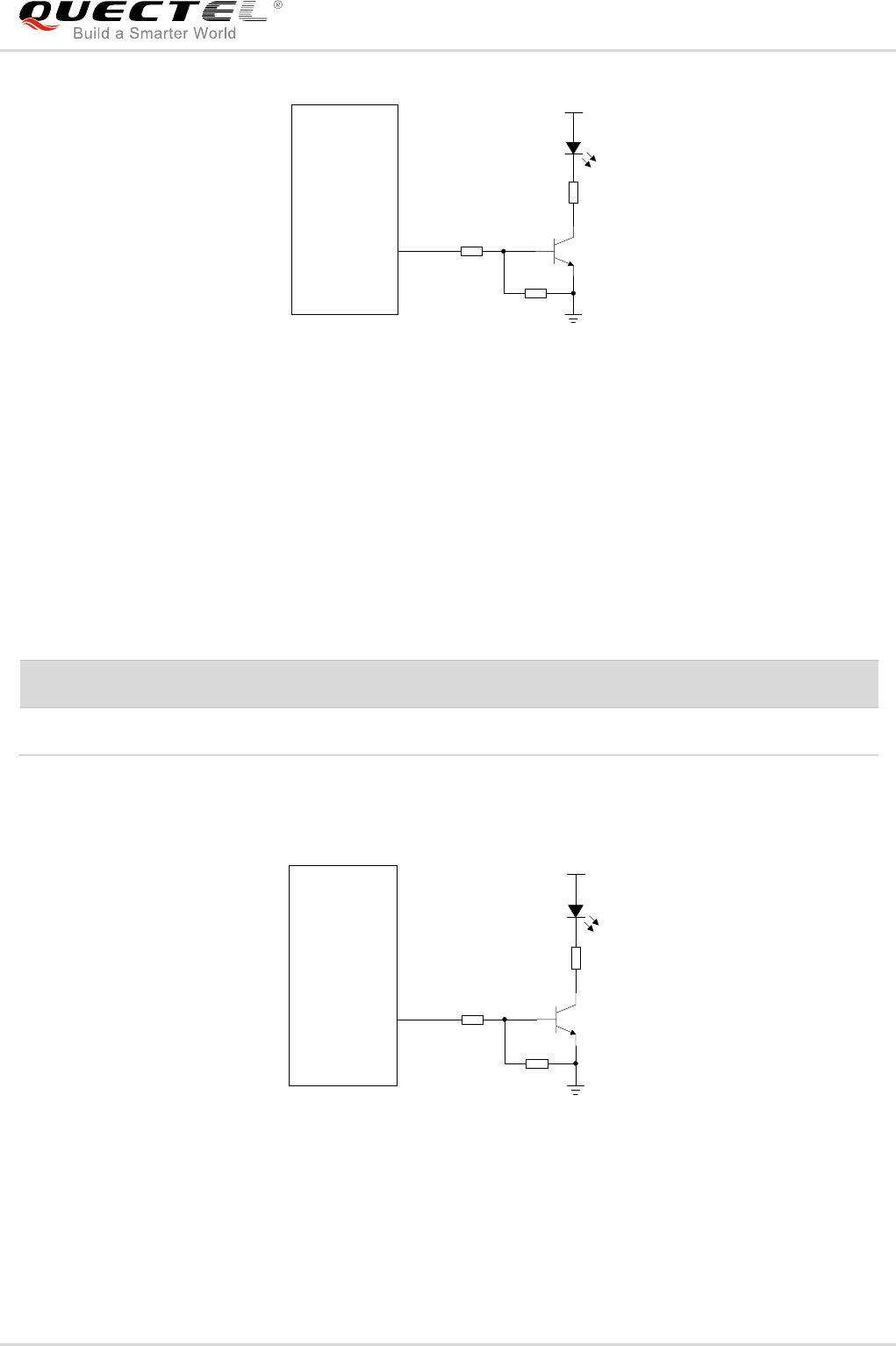
LTE Module Series
EG61-NA Hardware Design
EG61-NA_Hardware_Design 49 / 77
4.7K
47K
VBAT
2.2K
Module
NETLIGHT
Figure 26: Reference Circuit of the Network Status Indicator
3.15. STATUS
The STATUS pin is set as the module’s operation status indicator. It will output high level when the
module is powered on. The following table describes the pin definition of STATUS.
Table 18: Pin Definition of STATUS
Pin Name Pin No. I/O Description Comment
STATUS 20 DO Indicate the module’s operation status 1.8V power domain
A reference circuit is shown as below.
4.7K
47K
VBAT
2.2K
Module
STATUS
Figure 27: Reference Circuits of STATUS
3.16. Behaviors of RI
AT+QCFG="risignaltype","physical"command can be used to configure RI behavior.

LTE Module Series
EG61-NA Hardware Design
EG61-NA_Hardware_Design 50 / 77
No matter on which port URC is presented, URC will trigger the behavior ofRI pin.
URC can be outputted from UART port, USB AT port and USB modem port through configuration via
AT+QURCCFG command. The default port is USB AT port.
In addition, RI behavior can be configured flexibly. The default behaviors of the RI are shown as below.
Table 19: Default Behaviors of RI
State Response
Idle RI keeps athigh level
URC RI outputs 120ms low pulse when a new URC returns
The default RI behaviorscan be changed by AT+QCFG="urc/ri/ring"command.Please refer to
document [2] for details.
3.17. USB_BOOT Interface
EC61-NA provides a USB_BOOT pin. Customers can pull up USB_BOOT to VDD_EXT before powering
on the module, thus the module will enter into emergency download mode when powered on. In this mode,
the module supports firmware upgrade over USB interface.
Table 20: Pin Definition of USB_BOOT Interface
Pin Name Pin No. I/O Description Comment
USB_BOOT 75 DI
Force the module to enter into
emergency download mode
1.8V power domain.
Active high.
It is recommended to
reserve the pin as test
point.
The following figures show the reference circuit of USB_BOOT interface and timing sequence of Entering
into emergency download mode.
NOTE
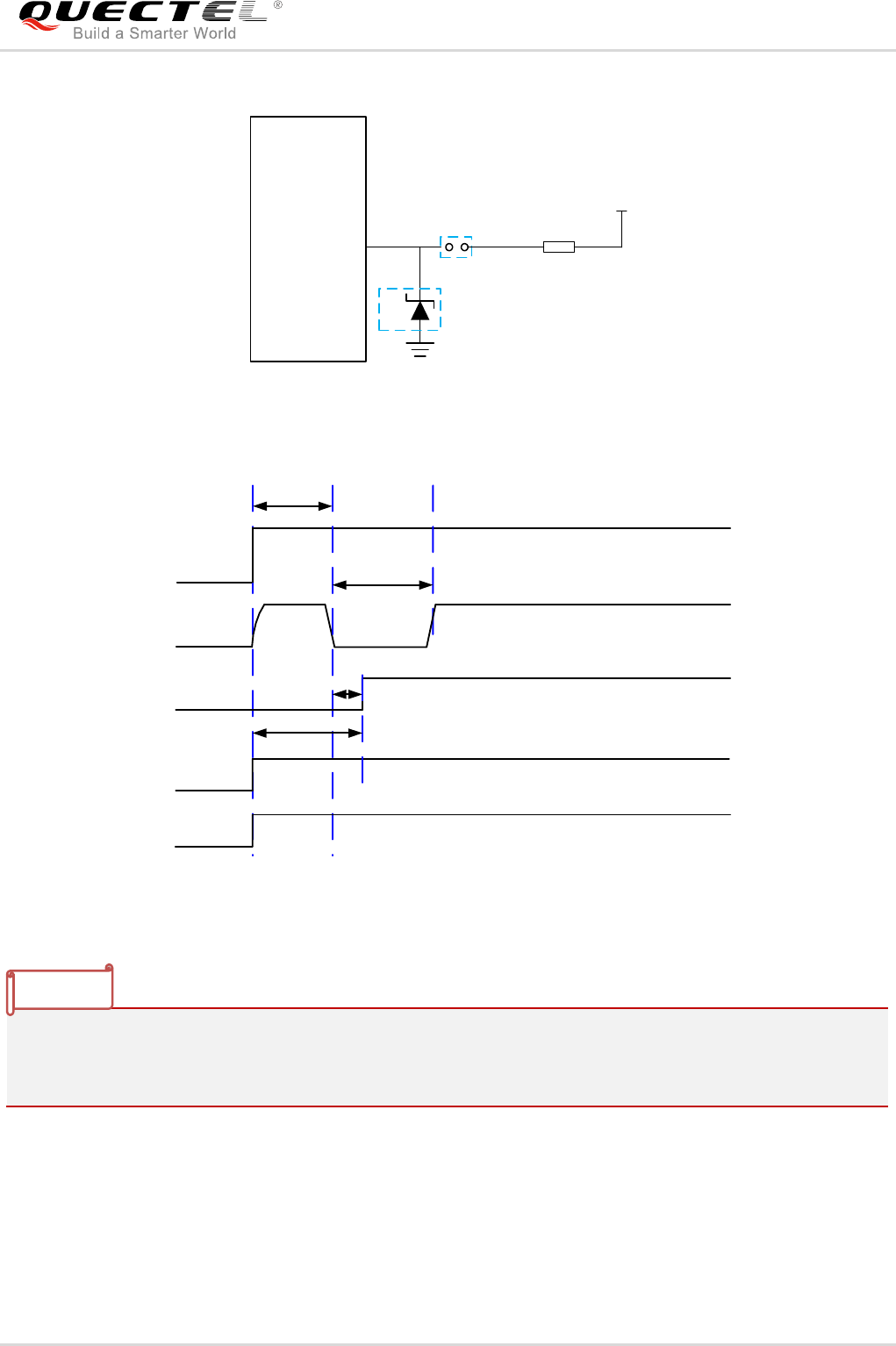
LTE Module Series
EG61-NA Hardware Design
EG61-NA_Hardware_Design 51 / 77
Module
USB_BOOT
VDD_EXT
4.7K
Test point
TVS
Close to test point
Figure 28: Reference Circuit of USB_BOOT Interface
VIL≤0.5V
VIH≥1.3V
VBAT
PWRKEY
≥500ms
RESET_N
NOTE
VDD_EXT
About 100ms
USB_BOOT
Setting USB_BOOT to high level between
VBAT rising on and VDD_EXT rising on can let
the module enter into emergency download
mode
Figure 29: Timing Sequence for Entering into Emergency Download Mode
1. Please make sure that VBAT is stable before pulling down PWRKEY pin, and the time between
themis no less than 30ms.
2. The recommended pull-up level range is 1.3V~2.1V if a pull-up circuit is added on PWRKEY pin.
NOTES

LTE Module Series
EG61-NA Hardware Design
EG61-NA_Hardware_Design 52 / 77
4 GNSS Receiver
4.1. General Description
EG61-NA includes a fully integrated global navigation satellite system solution that supports Gen8C-Lite
of Qualcomm (GPS, GLONASS, BeiDou, Galileo and QZSS).
EG61-NA supports standard NMEA-0183 protocol, and outputs NMEA sentences at 1Hz data update rate
via USB interface by default.
By default, EG61-NA GNSS engine is switched off. It has to be switched on via AT command. For more
details about GNSS engine technology and configurations, please refer to document [3].
4.2. GNSS Performance
The following table shows GNSS performance of EG61-NA.
Table 21: GNSS Performance
Parameter Description Conditions Typ. Unit
Sensitivity
(GNSS)
Cold start Autonomous -145 dBm
Reacquisition Autonomous -157 dBm
Tracking Autonomous -157 dBm
TTFF
(GNSS)
Cold start
@open sky
Autonomous 34.4 s
XTRA enabled 15.6 s
Warm start
@open sky
Autonomous 28.6 s
XTRA enabled 2.2 s
Hot start Autonomous 2.3 s

LTE Module Series
EG61-NA Hardware Design
EG61-NA_Hardware_Design 53 / 77
@open sky XTRA enabled 2.1 s
Accuracy
(GNSS) CEP-50 Autonomous
@open sky 4 m
1. Tracking sensitivity: the lowest GNSS signal value at the antenna port on which the module can keep
on positioning for 3 minutes.
2. Reacquisition sensitivity: the lowest GNSS signal value at the antenna port on which the module can
fix position again within 3 minutes after loss of lock.
3. Cold start sensitivity: the lowest GNSS signal value at the antenna port on which the module fixes
position within 3 minutes after executing cold start command.
4.3. Layout Guidelines
The following layout guidelines should be taken into account in customers’ design.
Maximize the distance among GNSS antenna, main antenna and Rx-diversity antenna.
Digital circuits such as (U)SIM card, USB interface, camera module and display connector should be
kept away from the antennas.
Use ground vias around the GNSS trace and sensitive analog signal traces to provide coplanar
isolation and protection.
Keep the characteristic impedance for ANT_GNSS trace as 50Ω.
Please refer to Chapter 5 for GNSS reference design and antenna installation information.
NOTES

LTE Module Series
EG61-NA Hardware Design
EG61-NA_Hardware_Design 54 / 77
5 Antenna Interfaces
EG61-NA antenna interfaces include a main antenna interface andanRx-diversity antennainterface which
is used toresist the fall of signals caused by high speed movement and multipath effect, and a GNSS
antenna interface which is only supported on EG61-NA.The impedance of the antenna port is 50Ω.
5.1. Main/Rx-diversityAntenna Interfaces
5.1.1. Pin Definition
The pin definitionof main antenna and Rx-diversityantenna interfaces is shown below.
Table 22: Pin Definition of RF Antenna
Pin Name Pin No. I/O Description Comment
ANT_MAIN 60 IO Main antenna pad 50Ωimpedance
ANT_DIV 49 AI Receive diversityantenna pad 50Ωimpedance
ANT_DIV 56 AI Receive diversity antenna pad 50Ω impedance
5.1.2. Operating Frequency
Table 23: Module Operating Frequencies
3GPP Band Transmit Receive Unit
WCDMA B2 1850~1910 1930~1990 MHz
WCDMA B4 1710~1755 2110~2155 MHz
WCDMA B5 824~849 869~894 MHz
LTE FDD B2 1850~1910 1930~1990 MHz
LTE FDD B4 1710~1755 2110~2155 MHz
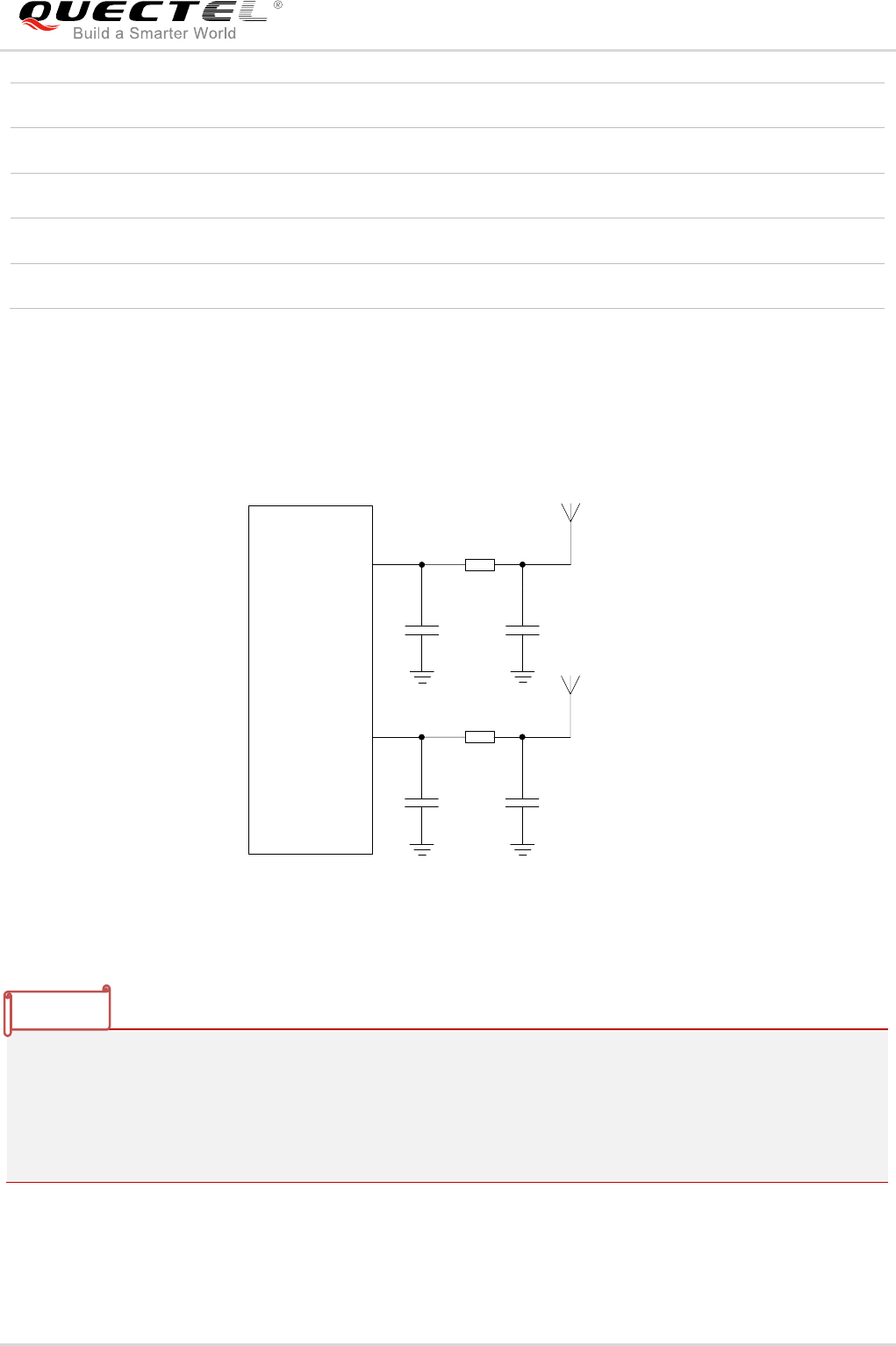
LTE Module Series
EG61-NA Hardware Design
EG61-NA_Hardware_Design 55 / 77
LTE FDD B5 824~849 869~894 MHz
LTE FDD B12 699~716 729~746 MHz
LTE FDD B13 777~787 746~756 MHz
LTE-FDDB66 1710~1780 2100~2200 MHz
LTE-FDD B71 663~698 617~652 MHz
5.1.3. Reference Design of RF Antenna Interface
Areference design of ANT_MAIN and ANT_DIVantenna pads is shown as below. Aπ-type matching circuit
should be reserved for better RF performance. The capacitors are not mounted by default.
ANT_MAIN
R1 0R
C1
Module
Main
antenna
NM
C2
NM
R2 0R
C3
Diversity
antenna
NM
C4
NM
ANT_DIV
Figure 30: Reference Circuit of RF Antenna Interface
1. Keep a proper distance between the main antenna and theRx-diversityantenna to improve the
receiving sensitivity.
2. ANT_DIV function is enabledby default.AT+QCFG="diversity",0command can be used to disable
receive diversity.
3. Place the π-type matching components (R1/C1/C2, R2/C3/C4) as close to the antenna as possible.
5.1.4. Reference Design of RF Layout
For user’s PCB, the characteristic impedance of all RF traces should be controlled as 50Ω. The
NOTES
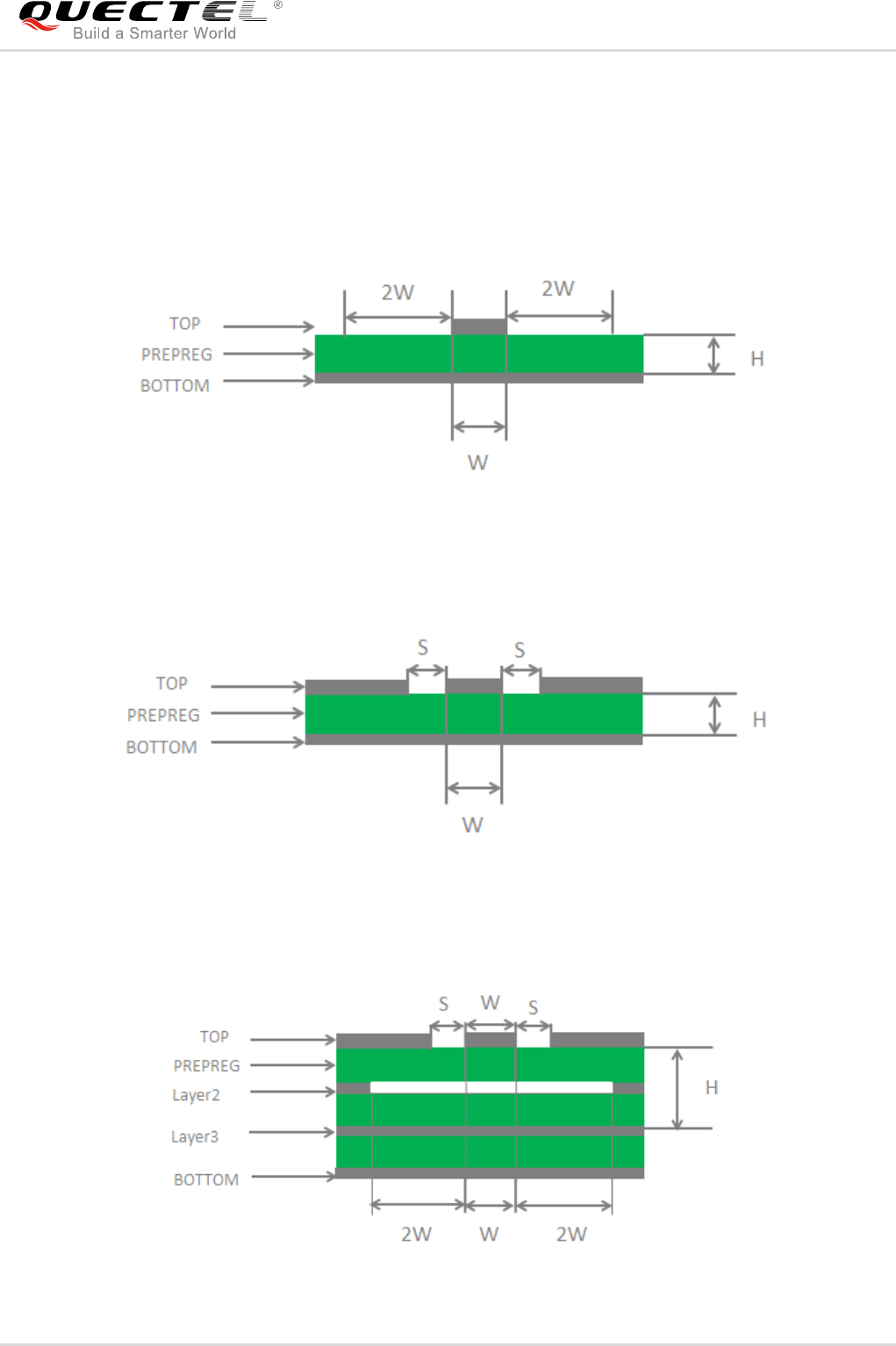
LTE Module Series
EG61-NA Hardware Design
EG61-NA_Hardware_Design 56 / 77
impedance of the RF traces is usually determined by the trace width (W), the materials’ dielectric constant,
the distance between signal layer and reference ground (H), and the clearance between RF trace and
ground (S). Microstrip line or coplanar waveguide line is typically used in RF layout for characteristic
impedance control. The following are reference designs of microstrip line or coplanar waveguide line with
different PCB structures.
.
Figure 31: Microstrip Line Design on a 2-layer PCB
Figure 32: Coplanar Waveguide Line Design on a 2-layer PCB
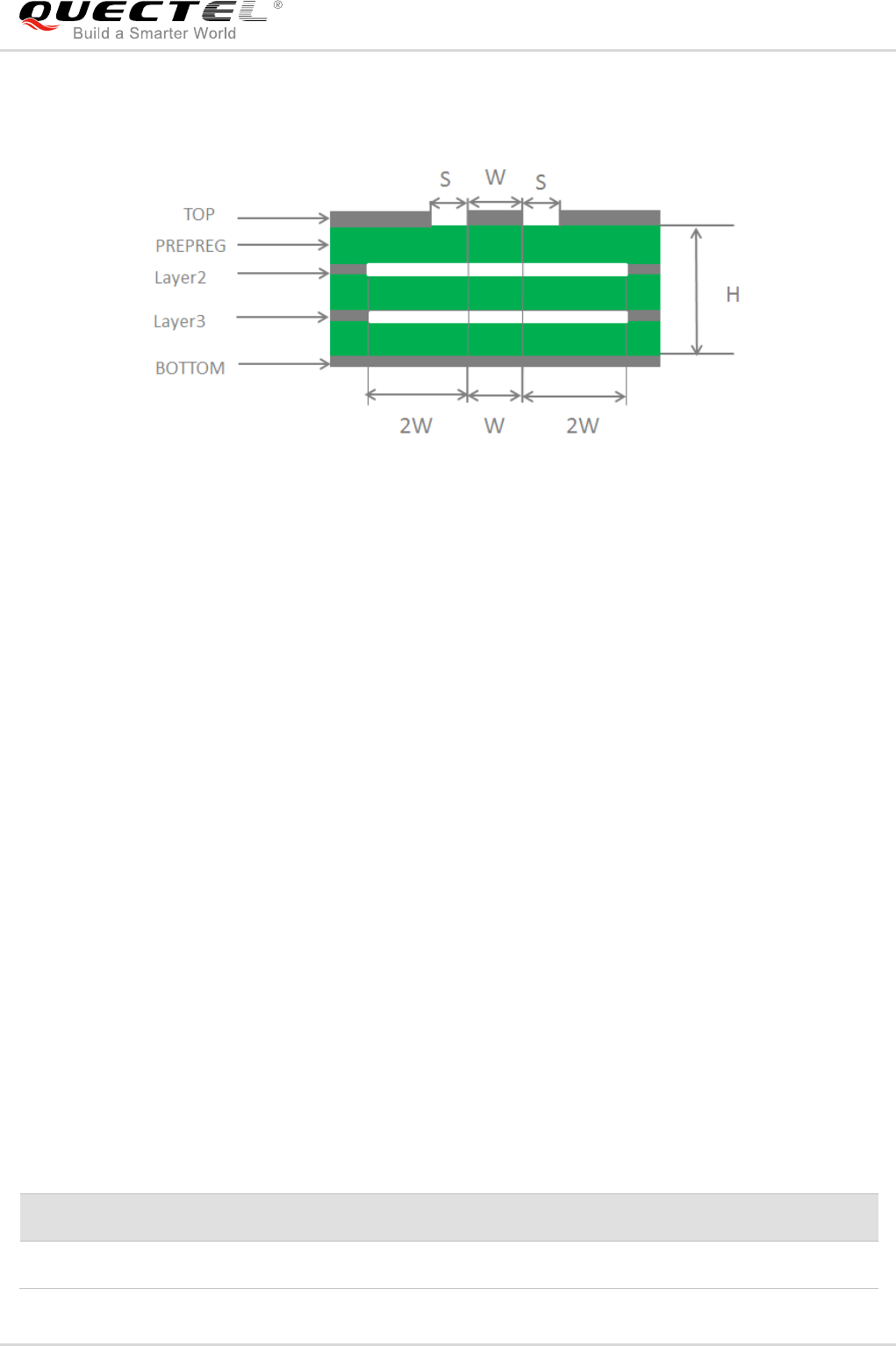
LTE Module Series
EG61-NA Hardware Design
EG61-NA_Hardware_Design 57 / 77
Figure 33: Coplanar Waveguide Line Design on a 4-layer PCB (Layer 3 as Reference Ground)
Figure 34: Coplanar Waveguide Line Design on a 4-layer PCB (Layer 4 as Reference Ground)
In order to ensure RF performance and reliability, the following principles should be complied with in RF
layout design:
Use impedance simulation tool to control the characteristic impedanceof RF tracesas 50Ω.
The GND pins adjacent to RF pins should not bedesigned as thermal relief pads, and should be fully
connected to ground.
The distance between the RF pinsand the RFconnector should be as short as possible, and all the
right angle traces should be changed to curved ones.
There should be clearance area under the signal pin of the antenna connector or solder joint.
The reference ground of RF traces should be complete. Meanwhile, adding some ground viasaround
RF traces and the reference ground could help to improve RF performance. The distance between
the ground viasand RF traces should be no less than two times the width of RF signal traces (2*W).
For more details about RF layout, please refer to document [4].
5.2. GNSS Antenna Interface
The GNSS antenna interface is only supported on EG61-NA.The following tables show pin definition and
frequency specification of GNSS antenna interface.
Table 24: Pin Definition of GNSS Antenna Interface
Pin Name Pin No. I/O Description Comment
ANT_GNSS 49 AI GNSS antenna 50Ωimpedance
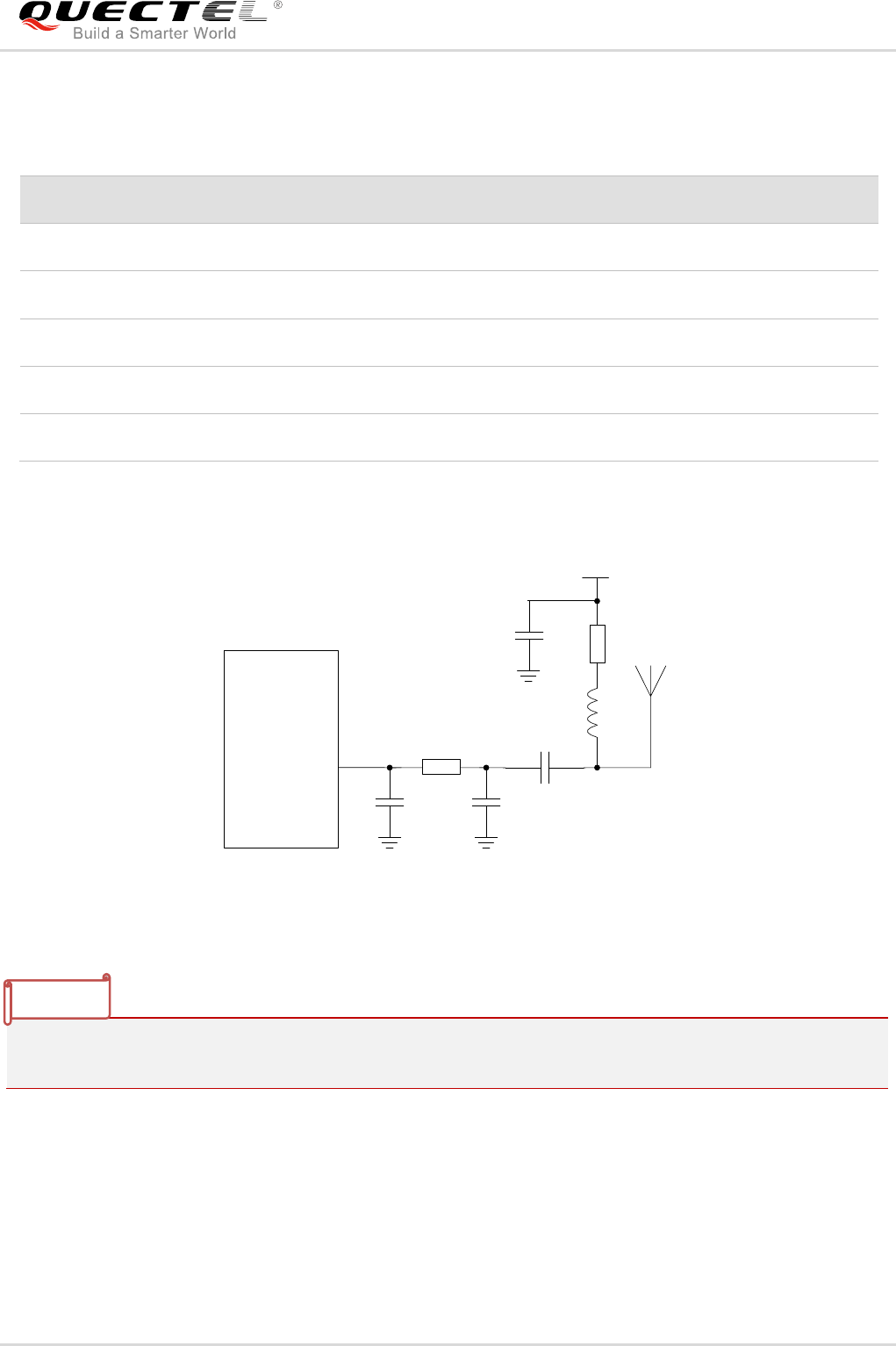
LTE Module Series
EG61-NA Hardware Design
EG61-NA_Hardware_Design 58 / 77
Table 25: GNSS Frequency
Type Frequency Unit
GPS 1575.42±1.023 MHz
GLONASS 1597.5~1605.8 MHz
Galileo 1575.42±2.046 MHz
BeiDou 1561.098±2.046 MHz
QZSS 1575.42 MHz
A reference design of GNSS antenna is shown as below.
GNSS
Antenna
VDD
Module
ANT_GNSS
47nH
10R
0.1uF
0R
NM NM
100pF
Figure 35: Reference Circuit of GNSS Antenna
1. An external LDO can be selected to supply power according to the active antenna requirement.
2. If the module is designed with a passive antenna, then the VDD circuit is not needed.
5.3. Antenna Installation
5.3.1. Antenna Requirement
The following table shows the requirements on main antenna, Rx-diversity antenna and GNSS antenna.
NOTES
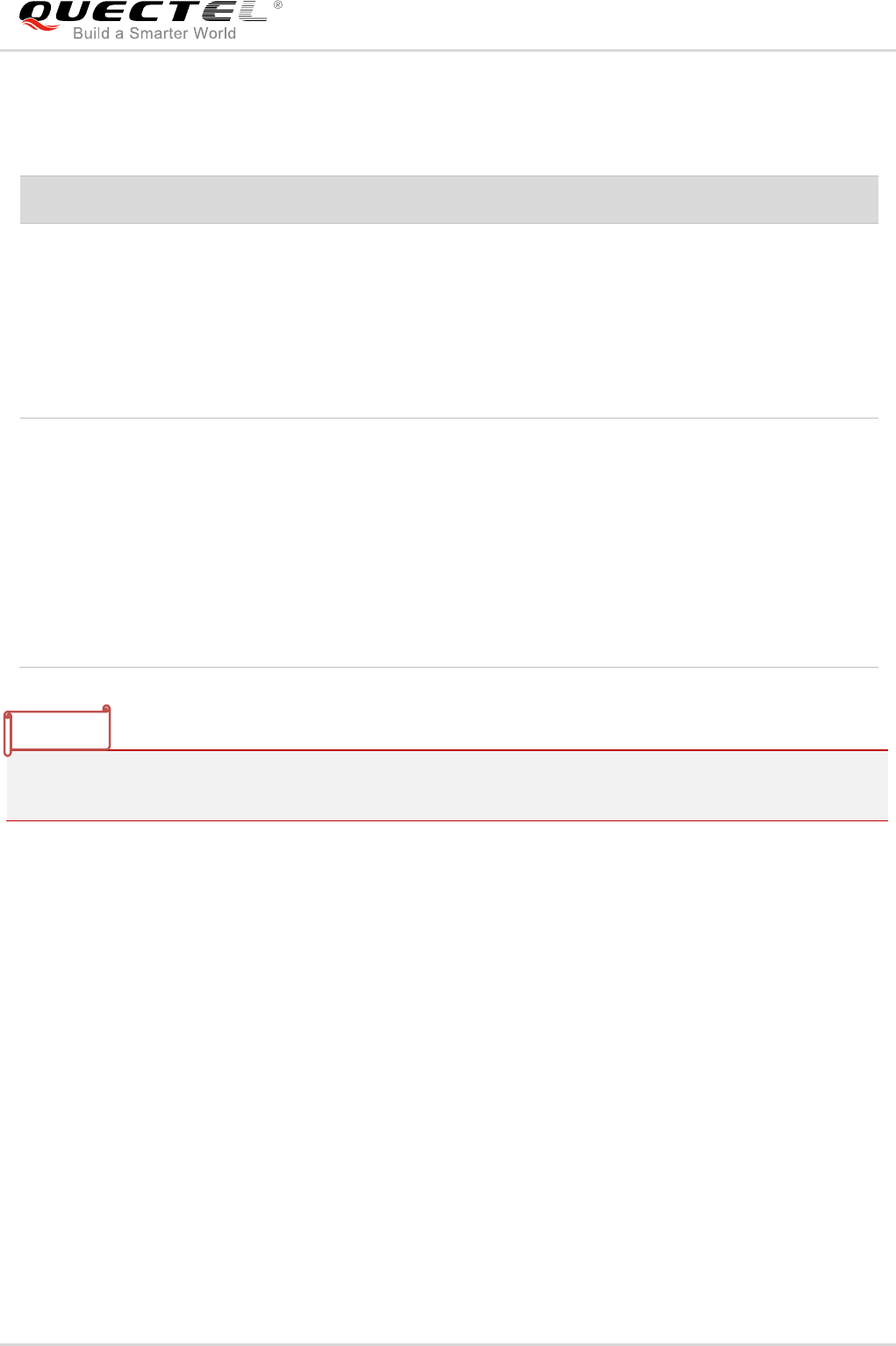
LTE Module Series
EG61-NA Hardware Design
EG61-NA_Hardware_Design 59 / 77
Table 26: Antenna Requirements
Type Requirements
GNSS1)
Frequency range: 1559MHz~1609MHz
Polarization: RHCP or linear
VSWR: < 2 (Typ.)
Passive antenna gain: > 0dBi
Active antenna noise figure: < 1.5dB
Active antenna gain: > 0dBi
Active antenna embedded LNA gain: < 17dB
WCDMA/LTE
VSWR: ≤2
Efficiency: > 30%
Max Input Power: 50 W
Input Impedance: 50Ω
Cable insertion loss: <1dB
(WCDMA B5
LTE B5/B12/B13/B71)
Cable Insertion Loss: <1.5dB
(WCDMAB2/B4, LTE B2/B4/B66)
1)
It is recommended to use a passive GNSS antenna when LTE B13 is supported, as the use of active
antenna may generate harmonics which will affect the GNSS performance.
5.3.2. Recommended RF Connector for Antenna Installation
If RF connector is used for antenna connection, it is recommended to use U.FL-R-SMT connector
provided by Hirose.
NOTE
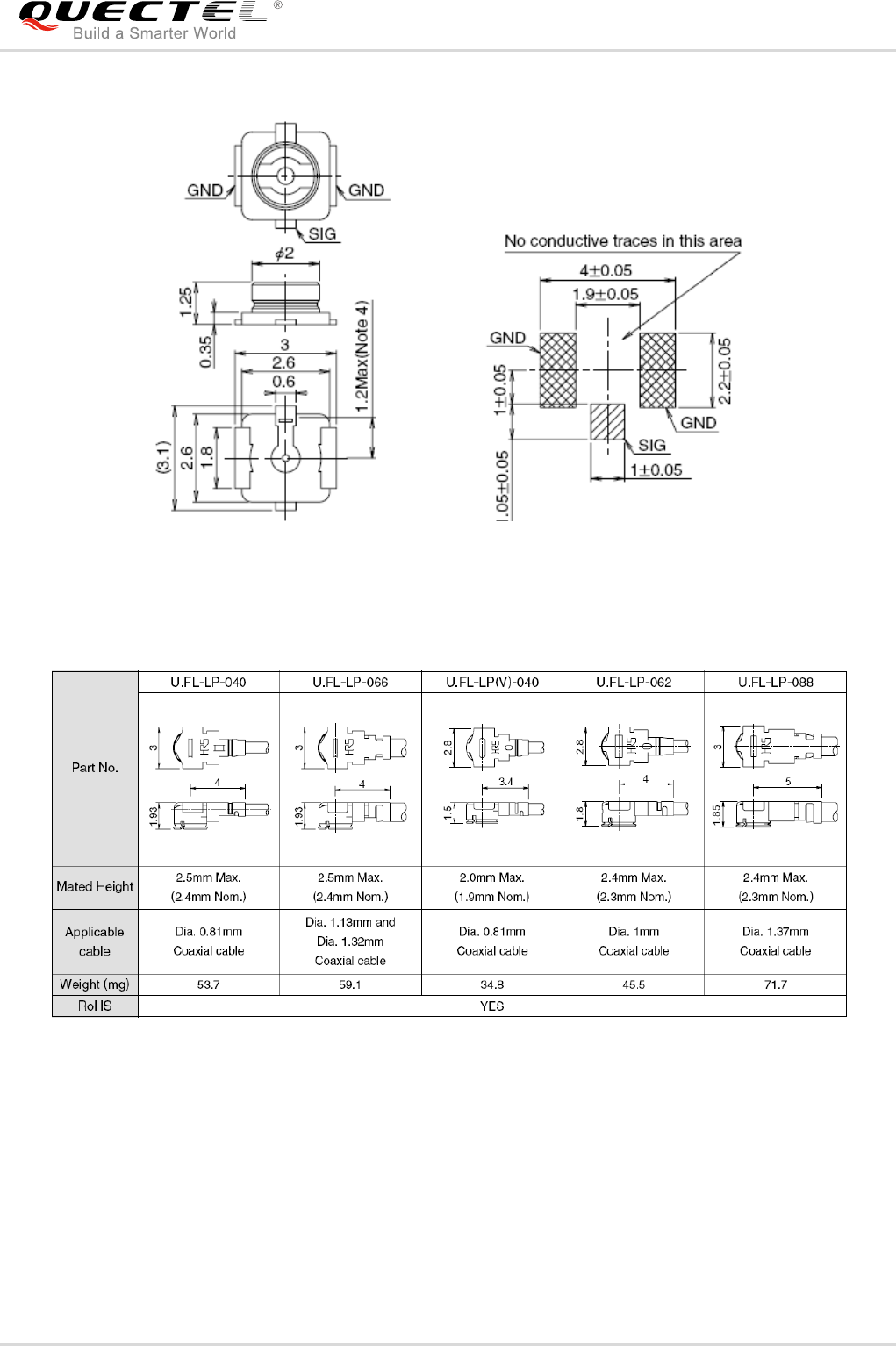
LTE Module Series
EG61-NA Hardware Design
EG61-NA_Hardware_Design 60 / 77
Figure 36: Dimensions of the U.FL-R-SMT Connector (Unit: mm)
U.FL-LP serial connectors listed in the following figure can be used to match the U.FL-R-SMT.
Figure 37:Mechanicals of U.FL-LP Connectors
The following figure describes the space factor of mated connector.

LTE Module Series
EG61-NA Hardware Design
EG61-NA_Hardware_Design 62 / 77
6 Electrical, Reliability and
RadioCharacteristics
6.1. Absolute Maximum Ratings
Absolute maximum ratings for power supply and voltage on digital and analog pins of the module are
listed in the following table.
Table 27: Absolute Maximum Ratings
Parameter Min. Max. Unit
VBAT_RF/VBAT_BB -0.3 4.7 V
USB_VBUS -0.3 5.5 V
Peak Current of VBAT_BB 0 0.8 A
Peak Current of VBAT_RF 0 TBD A
Voltage at Digital Pins -0.3 2.3 V
6.2. Power Supply Ratings
Table 28: Power Supply Ratings
Parameter Description Conditions Min. Typ. Max. Unit
VBAT VBAT_BB and
VBAT_RF
The actual input voltages
must stay between the
minimum and maximum
values.
3.3 3.8 4.3 V
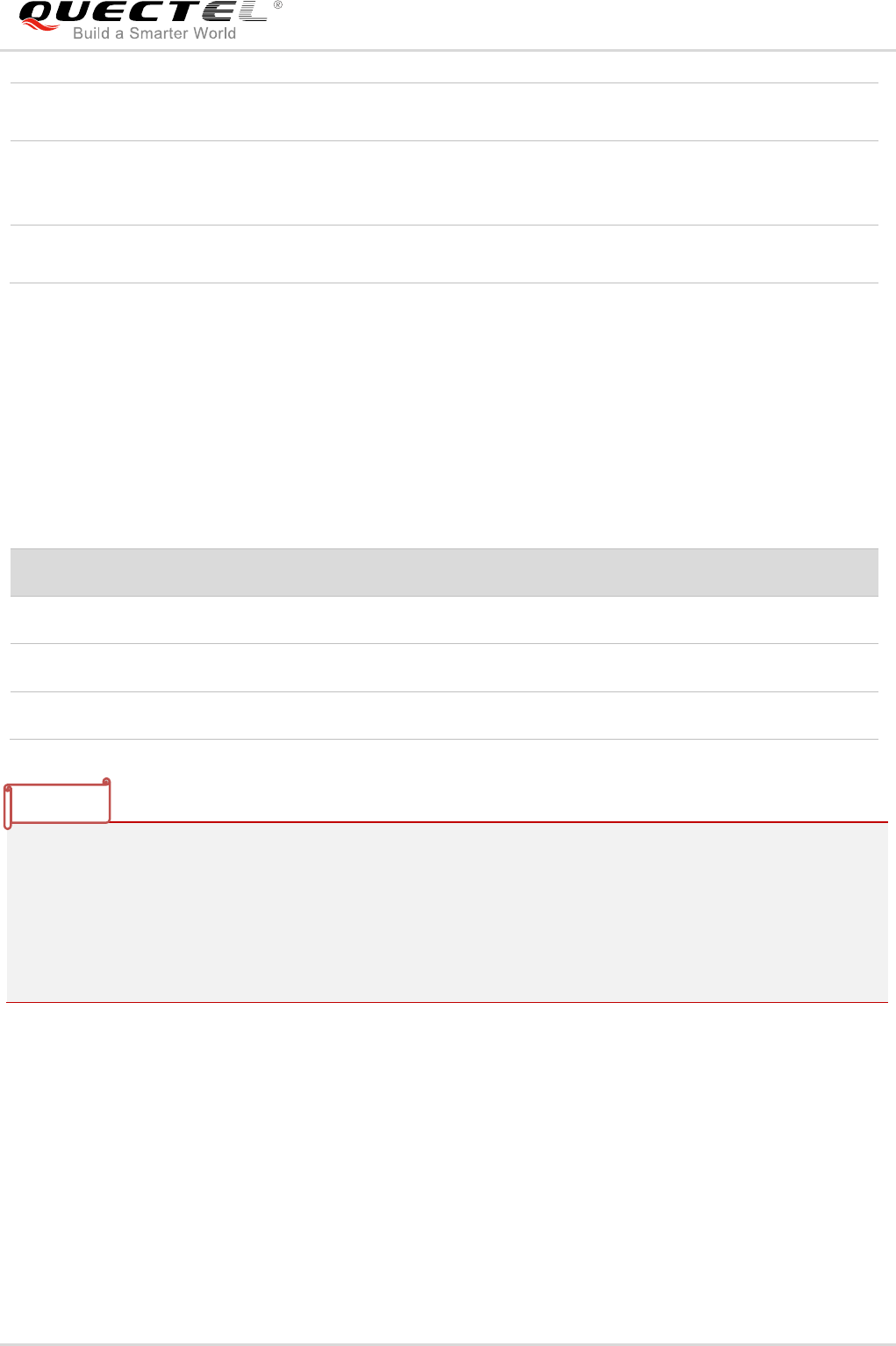
LTE Module Series
EG61-NA Hardware Design
EG61-NA_Hardware_Design 63 / 77
Voltage drop during
burst transmission
Maximum power control
level on LTE 400 mV
IVBAT
Peak supply current
(during
transmissionslot)
Maximum power control
level on LTE A
USB_VBUS USB connection
detection 3.0 5.0 5.25 V
6.3. Operation and Storage Temperatures
The operation and storage temperaturesare listed in the following table.
Table 29: Operation and Storage Temperatures
Parameter Min. Typ. Max. Unit
Operation Temperature Range1) -35 +25 +75 ºC
ExtendedTemperatureRange2) -40 +85 ºC
Storage Temperature Range -40 +90 ºC
1.
1)
Within operation temperature range, the module is 3GPP compliant.
2. 2) Within extended temperature range, the module remains the ability to establish and maintain a
voice, SMS, data transmission, emergency call, etc. There is no unrecoverable malfunction. There
are also no effects on radio spectrum and no harm to radio network. Only one or more parameters
like Pout might reduce in their value and exceed the specified tolerances. When the temperature
returns to the normal operation temperature levels, the module will meet 3GPP specifications again.
NOTES

LTE Module Series
EG61-NA Hardware Design
EG61-NA_Hardware_Design 64 / 77
6.4. Current Consumption
The values of current consumption are shown below.
Table 30: EG61-NA Current Consumption
Parameter Description Conditions Typ. Unit
IVBAT
OFF state Power down 12 uA
Sleep state
AT+CFUN=0 (USB disconnected) 0.646 mA
WCDMA PF=64 (USB disconnected) 1.483 mA
WCDMA PF=64 (USB suspend) 1.844 mA
WCDMA PF=512 (USB disconnected) 0.912 mA
LTE-FDD PF=64 (USB disconnected) 1.96 mA
LTE-FDD PF=64 (USB suspend) 2.152 mA
LTE-FDD PF=256 (USB disconnected) 1.219 mA
Idle state
WCDMA PF=64 (USB disconnected) 17.225 mA
WCDMA PF=64 (USB connected) 27.656 mA
LTE-FDDPF=64 (USB disconnected) 18.09 mA
LTE-FDDPF=64 (USB connected) 28.768 mA
WCDMA
datatransfer
WCDMA B2 HSDPA@21.69dBm 592.0 mA
WCDMA B2 HSUPA@21.76dBm 606.0 mA
WCDMA B4 HSDPA@23.22dBm 604.0 mA
WCDMA B4 HSUPA@22.49dBm 606.0 mA
WCDMA B5 HSDPA@23.22dBm 551.0 mA
WCDMA B5 HSUPA@22.46dBm 546.0 mA
LTE
datatransfer
LTE-FDD B2 @22.89dBm 705.0 mA
LTE-FDD B4 @22.91dBm 754.0 mA

LTE Module Series
EG61-NA Hardware Design
EG61-NA_Hardware_Design 65 / 77
LTE-FDD B5 @23.2dBm 602.0 mA
LTE-FDD B12 @23.0dBm 714.0 mA
LTE-FDD B13 @23.16dBm 663.0 mA
LTE-FDD B66 @22.90dBm 746.3 mA
LTE-FDD B71 @22.93dBm 718.0 mA
WCDMA
voice call
WCDMA B2 @22.96dBm 647.0 mA
WCDMA B4 @23.35dBm 607.0 mA
WCDMA B5 @23.36dBm 550.0 mA
Table 31: GNSS Current Consumption of EG61-NA
6.5. RF Output Power
The following table shows the RF output power of EG61-NA module.
Table 32: RF Output Power
Frequency Max. Min.
WCDMA B2/B4/B5 24dBm+1/-3dB <-49dBm
LTE-FDD B2/B4/B5/B12/B13
B66/B71 23dBm±2dB <-39dBm
Parameter Description Conditions Typ. Unit
IVBAT
(GNSS)
Searching
(AT+CFUN=0)
Cold start @Passive Antenna 52.765 mA
Lost state @Passive Antenna 52.306 mA
Tracking
(AT+CFUN=0)
Instrument Environment 34.547 mA
Open Sky @Passive Antenna TBD mA
Open Sky @Active Antenna TBD mA

LTE Module Series
EG61-NA Hardware Design
EG61-NA_Hardware_Design 66 / 77
6.6. RF Receiving Sensitivity
The following tables show the conducted RF receiving sensitivity of EG61-NA module.
Table 33: EG61-NA Conducted RF Receiving Sensitivity
Frequency Primary Diversity SIMO 3GPP
WCDMA B2 -109dBm -110dBm / -104.7dBm
WCDMA B4 -109dBm -110dBm / -106.7dBm
WCDMA B5 -110.5dBm -110.5dBm / -104.7dBm
LTE-FDD B2 (10M) -97.7 -98.7 -101.7 -94.3dBm
LTE-FDD B4 (10M) -97.7 -98.2 -100.2 -96.3dBm
LTE-FDD B5 (10M) -99.7 -99.4 -102.7 -94.3dBm
LTE-FDD B12 (10M) -98.7 -99.2 -101.7 -93.3dBm
LTE-FDD B13 (10M) -98.7 -98.9 -102.2 -93.3dBm
LTE-FDD B66 (10M) -97.7 -98.3 -101.2 -95.8dBm
LTE-FDD B71 (10M) -99.2 -99 -102.2 -93.5dBm
6.7. Electrostatic Discharge
The module is not protected against electrostatic discharge (ESD) in general. Consequently, it is subject
to ESD handling precautions that typically apply to ESD sensitive components. Proper ESD handling and
packaging procedures must be applied throughout the processing, handling and operation of any
application that incorporates the module.
The following table shows the module’s electrostatic discharge characteristics.
Table 34: Electrostatic Discharge Characteristics
Test Points Contact Discharge Air Discharge Unit
VBAT, GND ±8 ±12 KV

LTE Module Series
EG61-NA Hardware Design
EG61-NA_Hardware_Design 67 / 77
ANT_MAIN,ANT_DIV ±8 ±12 KV
ANT_GNSS ±6 ±10 KV
Other Interfaces TBD TBD KV
6.8. Thermal Consideration
In order to achieve better performance of the module, it is recommended to comply with the following
principles for thermal consideration:
On customers’ PCB design, please keep placement of the module away from heating sources,
especially high power components such as ARM processor, audio power amplifier, power supply, etc.
Do not place components on the opposite side of the PCB area where the module is mounted, in
order to facilitate adding of heatsink when necessary.
Do not apply solder mask on the opposite side of the PCB area where the module is mounted, so as
to ensure better heat dissipation performance.
The reference ground of the area where the module is mounted should be complete, and add ground
vias as many as possible for better heat dissipation.
Make sure the ground pads of the module and PCB are fully connected.
According to customers’ application demands, the heatsink can be mounted on the top of the module,
or the opposite side of the PCB area where the module is mounted, or both of them.
The heatsink should be designed with as many fins as possible to increase heat dissipation area.
Meanwhile, a thermal pad with high thermal conductivity should be used between the heatsink and
module/PCB.
The following shows two kinds of heatsink designs for reference and customers can choose one or bothof
them according to their application structure.
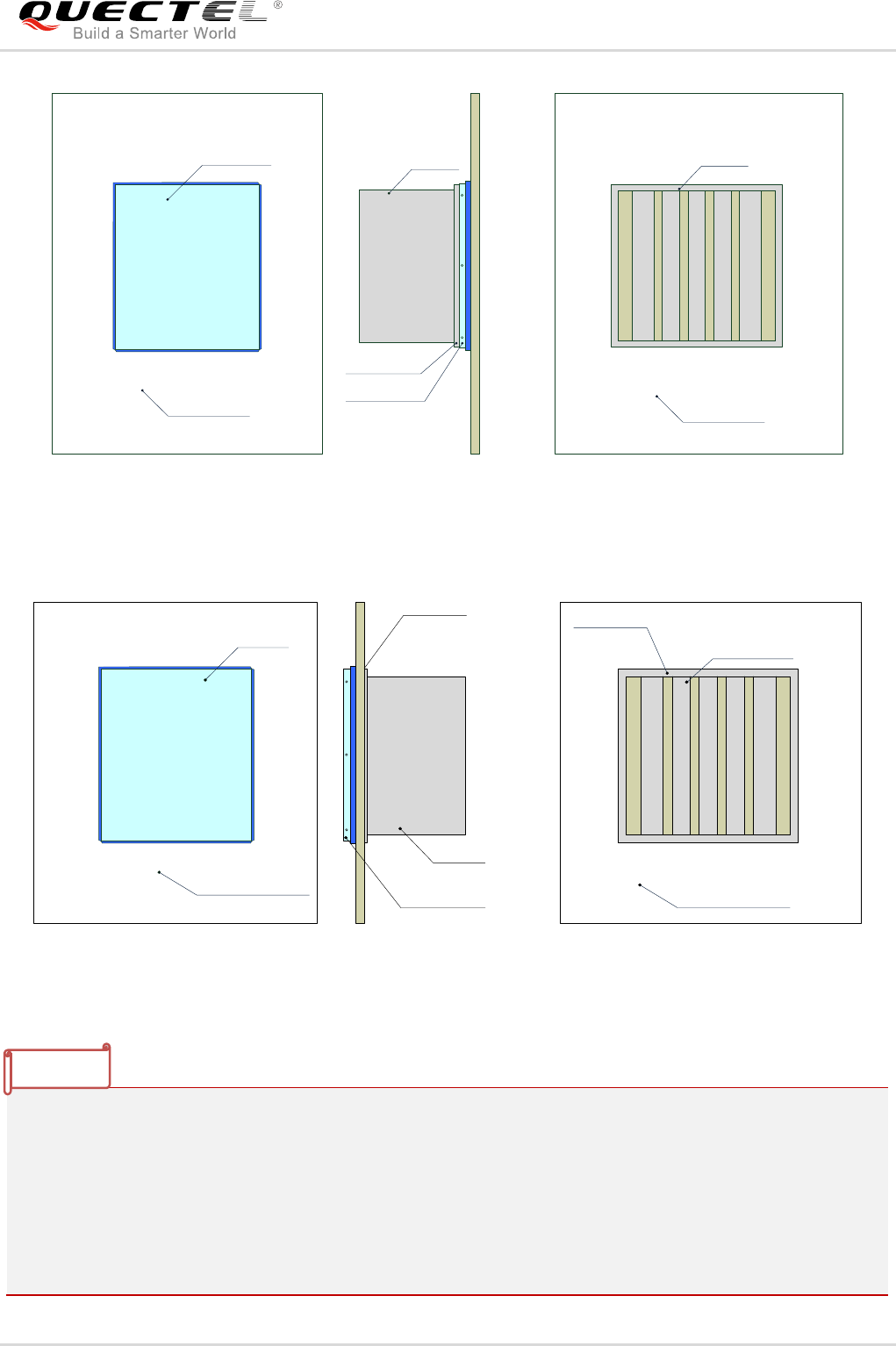
LTE Module Series
EG61-NA Hardware Design
EG61-NA_Hardware_Design 68 / 77
Heatsink
EG61-NA Module
Application Board Application Board
Heatsink
Thermal Pad
Shielding Cover
Figure 39: Referenced Heatsink Design (Heatsink at the Top of the Module)
Thermal Pad
Heatsink
Application Board Application Board
Heatsink
Thermal Pad
EG61-NA Module
Shielding Cover
Figure 40: Referenced Heatsink Design (Heatsink at the Bottom of Customers’ PCB)
1. The module offers the best performance when the internal BB chip stays below 105°C. When the
maximum temperature of the BB chip reaches or exceeds 105°C, the module works normal but
provides reduced performance (such as RF output power, data rate, etc.). When the maximum BB
chip temperature reaches or exceeds 115°C, the module will disconnect from the network, and it will
recover to network connected state after the maximum temperature falls below 115°C. Therefore, the
thermal design should be maximally optimized to make sure the maximum BB chip temperature
always maintains below 105°C. Customers can execute AT+QTEMP
command and get the
NOTES

LTE Module Series
EG61-NA Hardware Design
EG61-NA_Hardware_Design 69 / 77
maximum BB chip temperature from the first returned value.
2. For more detailed guidelines on thermal design, please refer to document [5].
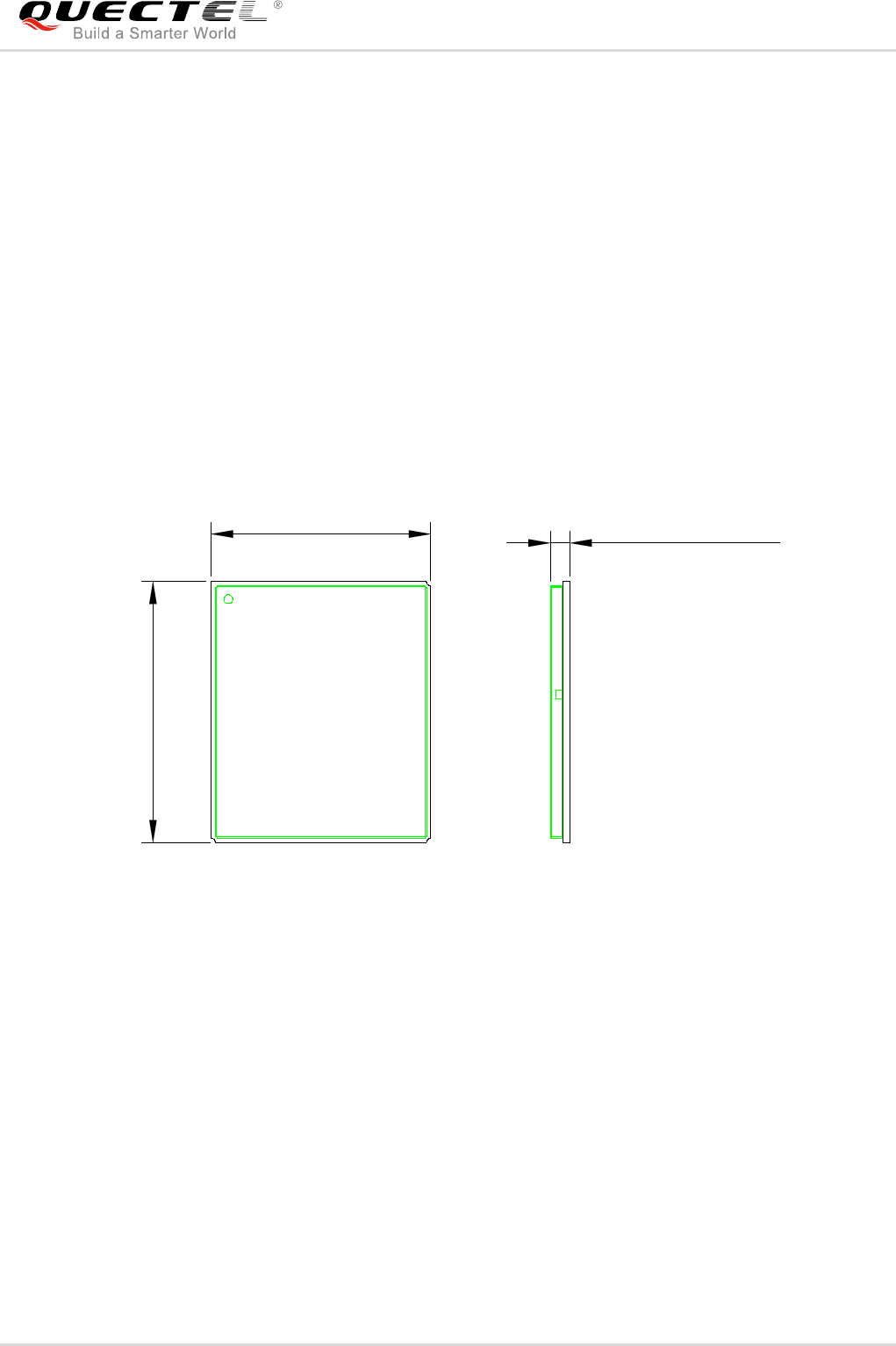
LTE Module Series
EG61-NA Hardware Design
EG61-NA_Hardware_Design 70 / 77
7 Mechanical Dimensions
This chapter describes the mechanical dimensions of the module.All dimensions are measured in mm.
The tolerances for dimensions without tolerance values are ±0.05mm.
7.1. Mechanical Dimensions of the Module
25±0.15
31±0.15
2.45±0.2
Figure 41: Module Top and Side Dimensions
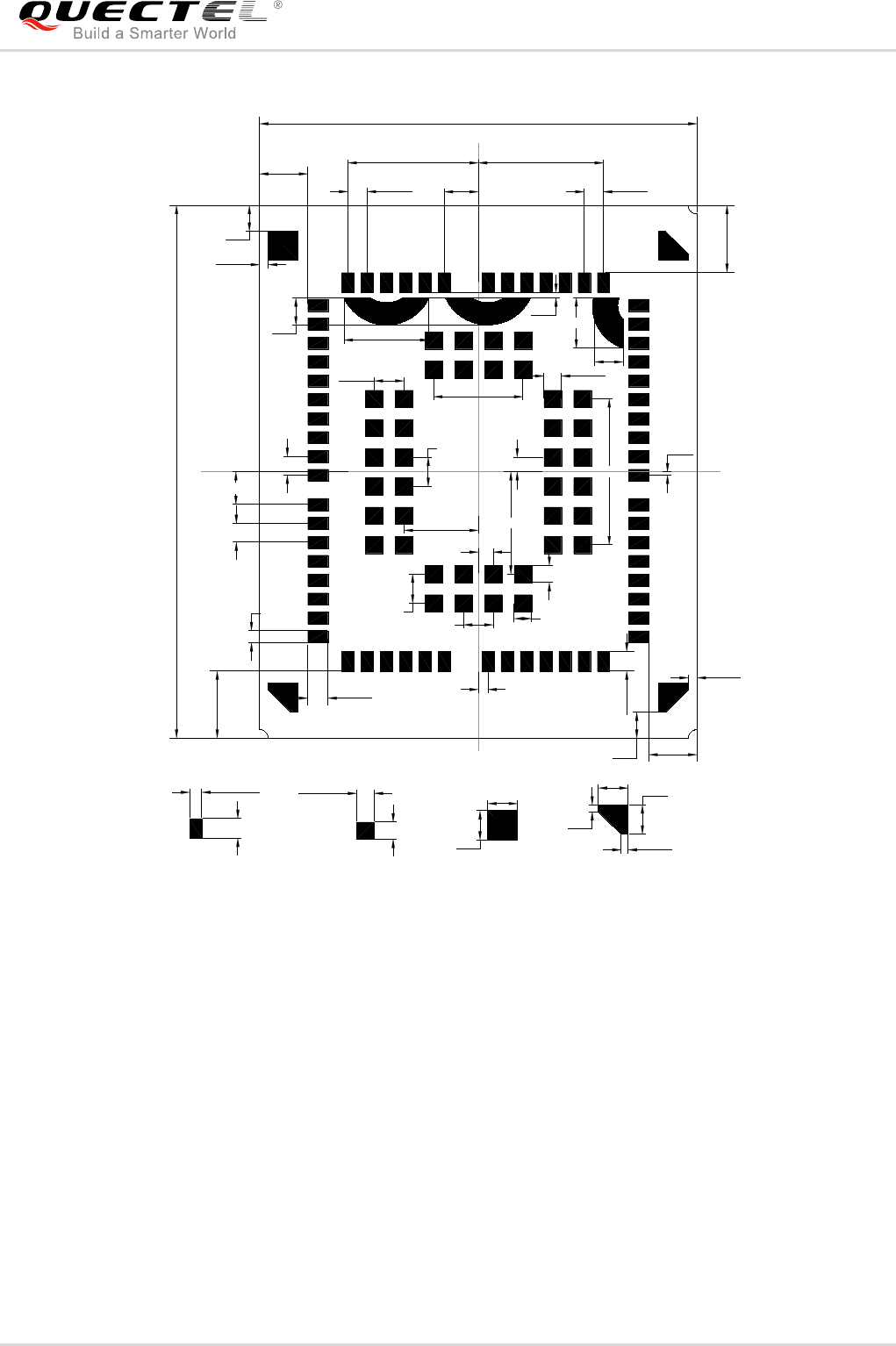
LTE Module Series
EG61-NA Hardware Design
EG61-NA_Hardware_Design 71 / 77
1.00
1.70
0.70
0.55
0.85
1.00
1.70
1.70
62x0.7
40x1.0
40x1.0
25±0.15
31±0.15
3.90
2.75
2.75
3.90
1.15
1.15
7.45 7.15
0.85 8.50
5.10
0.20
1.10
1.90
1.10
1.95
1.00
1.10 1.10
62x1.15
1.50
1.70
1.70
0.40
1.70
1.70
0.40
0.50
1.50
4.85
1.58
0.33
2.93
1.63
5.95
4.25
0.50
1.70
Figure 42: Module Bottom Dimensions (TopView)
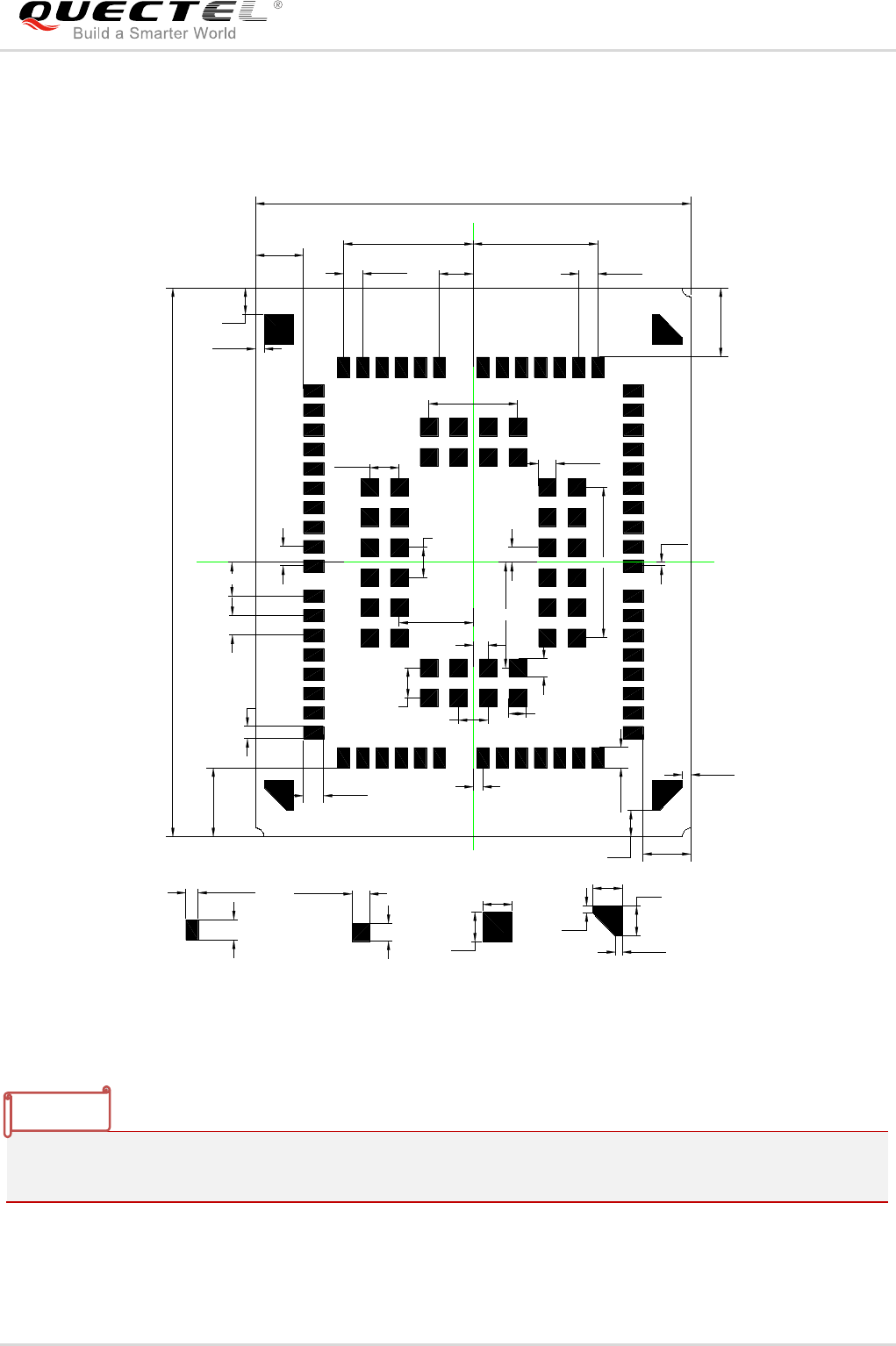
LTE Module Series
EG61-NA Hardware Design
EG61-NA_Hardware_Design 72 / 77
7.2. Recommended Footprint
1.00
1.70
0.70
0.55
0.85
1.00
1.70
1.70
62x0.7
40x1.0
40x1.0
25±0.15
31±0.15
3.90
2.75
2.75
3.90
1.15
1.15
7.45 7.15
0.85 8.50
5.10
0.20
1.10
1.90
1.10
1.95
1.00
1.10 1.10
62x1.15
1.50
1.70
1.70
0.40
1.70 1.70
0.40
0.50
1.50
5.95
4.25
0.50
1.70
Figure 43: Recommended Footprint (Top View)
For easymaintenance of the module, please keep about 3mm between the module and other components
in thehost PCB.
NOTE
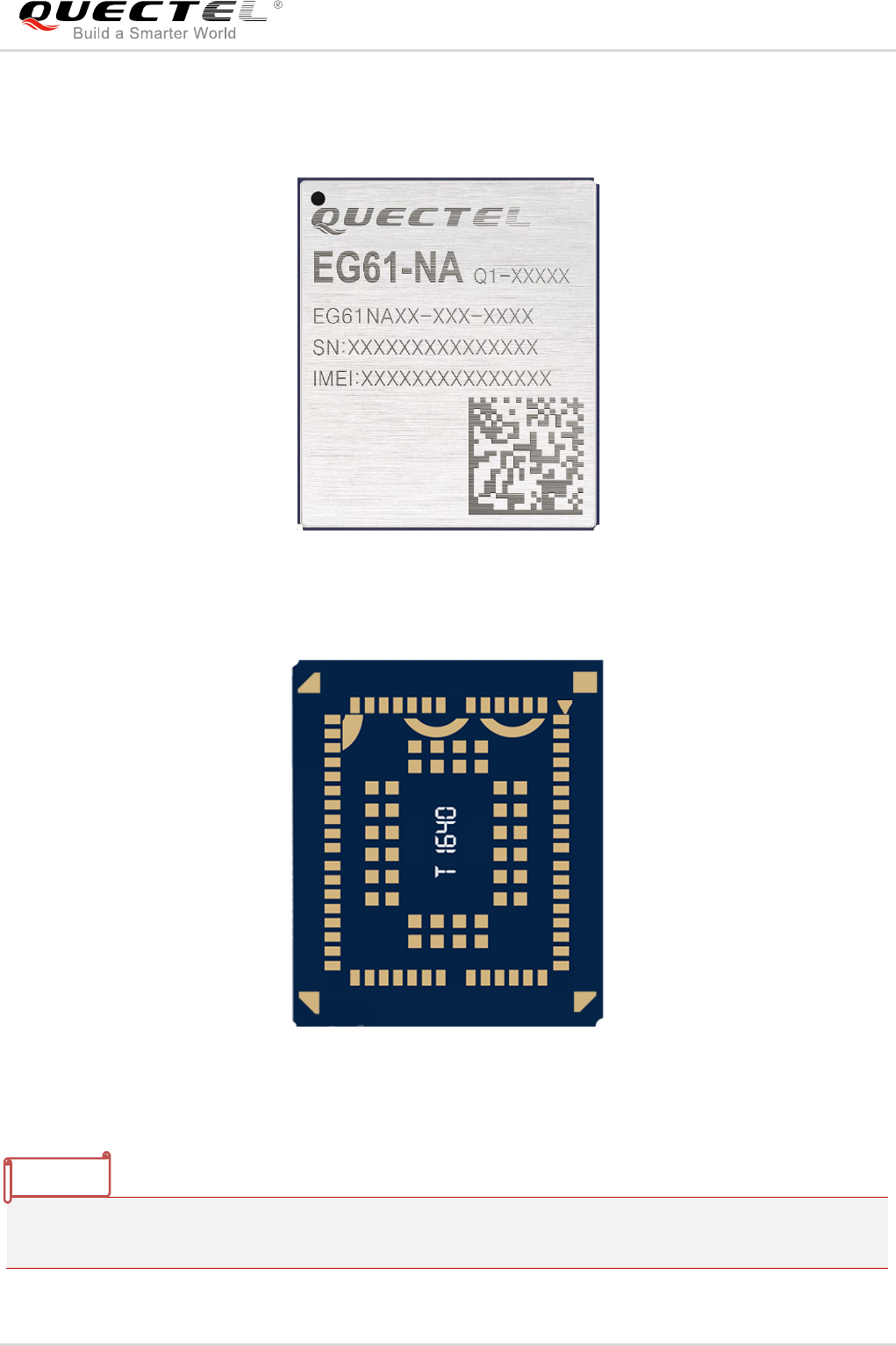
LTE Module Series
EG61-NA Hardware Design
EG61-NA_Hardware_Design 73 / 77
7.3. Design Effect Drawings of the Module
Figure 44: Top View of the Module
Figure 45: Bottom View of the Module
These are design effect drawings of EG61-NA module. For more accurate pictures, please refer to the
module that you get from Quectel.
NOTE

LTE Module Series
EG61-NA Hardware Design
EG61-NA_Hardware_Design 74 / 77
8 Storage, Manufacturing and
Packaging
8.1. Storage
EG61-NAis stored in a vacuum-sealed bag. It is rated at MSL 3, and its storage restrictions are listed
below.
1. Shelf life in vacuum-sealed bag: 12 months at <40ºC/90%RH.
2. After the vacuum-sealed bag is opened, devices that will be subjected to reflow soldering or other
high temperature processes must be:
Mounted within 168 hours at the factory environment of ≤30ºC/60%RH.
Stored at <10% RH.
3. Devices require bake before mounting, if any circumstances below occurs:
When the ambient temperature is 23ºC±5ºC and the humidity indicator card shows the humidity
is >10% before opening the vacuum-sealed bag.
Device mounting cannot be finished within 168 hours at factory conditions of ≤30ºC/60%RH.
4. If baking is required, devices may be baked for 8 hours at 120ºC±5ºC.
As the plastic package cannot be subjected to high temperature, it should be removed from devices
before high temperature (120ºC) baking. If shorter baking time is
desired, please refer to
IPC/JEDECJ-STD-033 for baking procedure.
NOTE
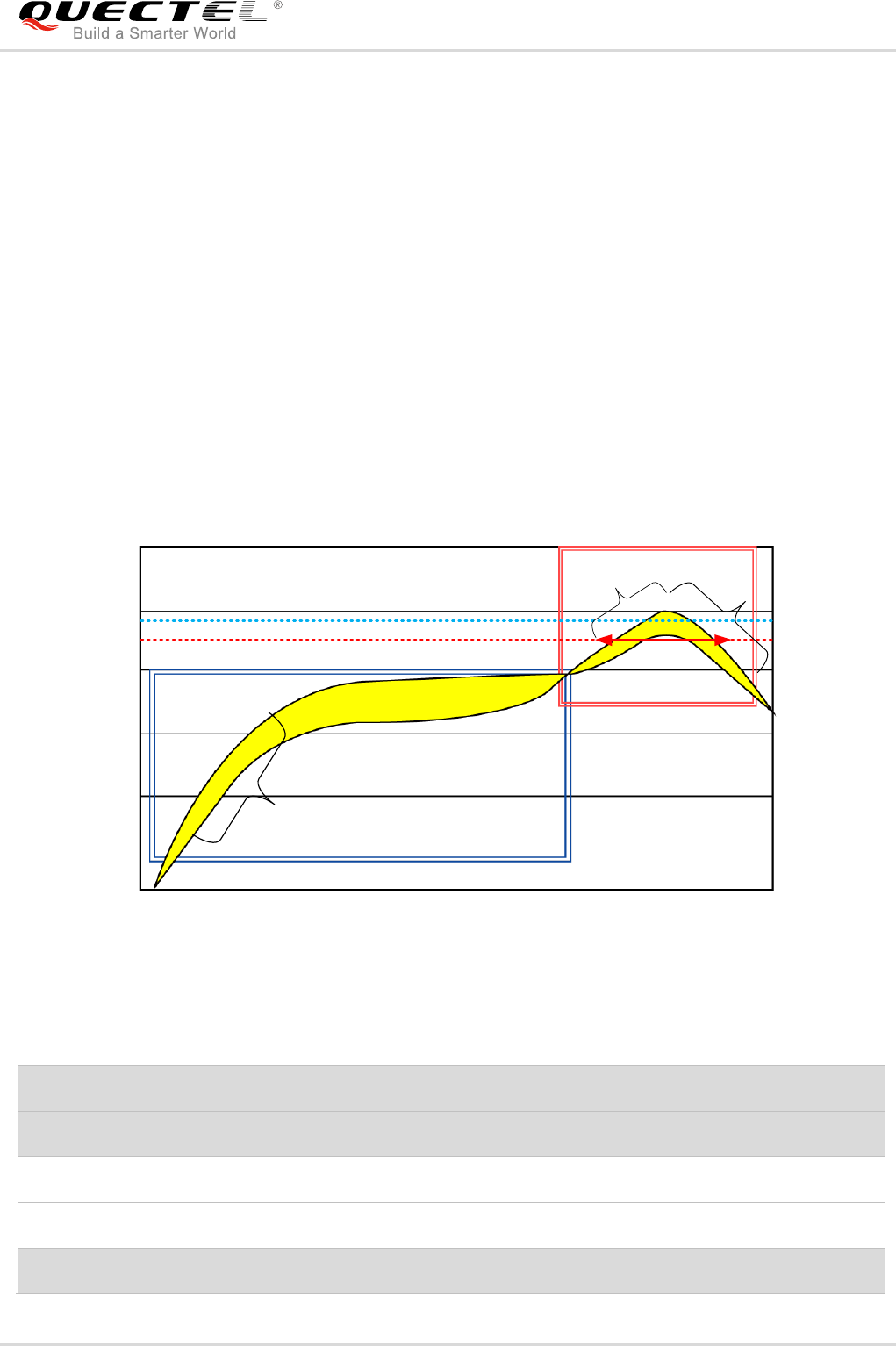
LTE Module Series
EG61-NA Hardware Design
EG61-NA_Hardware_Design 75 / 77
8.2. Manufacturing and Soldering
Push the squeegee to apply the solder paste on the surface of stencil, thus making the paste fill the
stencil openings and then penetrate to the PCB. The force on the squeegee should be adjusted
properlyso as to produce a clean stencil surface on a single pass. To ensure the module soldering quality,
thethickness of stencil for the module is recommended to be 0.15mm~0.18mm. For more details, please
refer todocument [3].
It is suggested that the peak reflow temperature is 240ºC ~245ºC, and the absolute maximum reflow
temperature is 245ºC. To avoid damage to the module caused by repeated heating, it is strongly
recommended that the module should be mounted after reflow soldering for the other side of PCB has
been completed. The recommended reflow soldering thermal profile (lead-free reflow soldering) and
related parameters are shown below.
Temp. (°C)
Reflow Zone
Soak Zone
245
200
220
240
C
D
B
A
150
100
Max slope: 1~3°C/sec
Cooling down
slope: 1~4°C/sec
Max slope:
2~3°C/sec
Figure 46: Reflow Soldering Thermal Profile
Table 35: Recommended Thermal Profile Parameters
Factor Recommendation
Soak Zone
Max slope 1 to 3°C/sec
Soak time (between A and B: 150°C and 200°C) 60 to 120 sec
Reflow Zone

LTE Module Series
EG61-NA Hardware Design
EG61-NA_Hardware_Design 76 / 77
1. During manufacturing and soldering, or any other processes that may contact the module directly,
NEVER wipe the module’s shielding can with organic solvents, such as acetone, ethyl alcohol,
isopropyl alcohol, trichloroethylene, etc. Otherwise, the shielding can may become rusted.
2. The shielding can for the module is made of Cupro-Nickel base material. It is tested that after 12
hours’ Neutral Salt Spray test, the laser engraved label information on the shielding can is still clearly
identifiable and the 2Dbarcode is still readable, although white rust may be found.
8.3. Packaging
EG61-NAis packaged in a vacuum-sealed bag which is ESD protected. The bag should not be opened
until the devices are ready to be soldered onto the application.
The reel is 330mm in diameter and each reel contains 250pcs modules. The following figures show the
packaging details, measured in mm.
Max slope 2 to 3°C/sec
Reflow time (D: over 220°C) 40 to 60 sec
Max temperature 240°C ~ 245°C
Cooling down slope 1 to 4°C/sec
Reflow Cycle
Max reflow cycle 1
NOTES
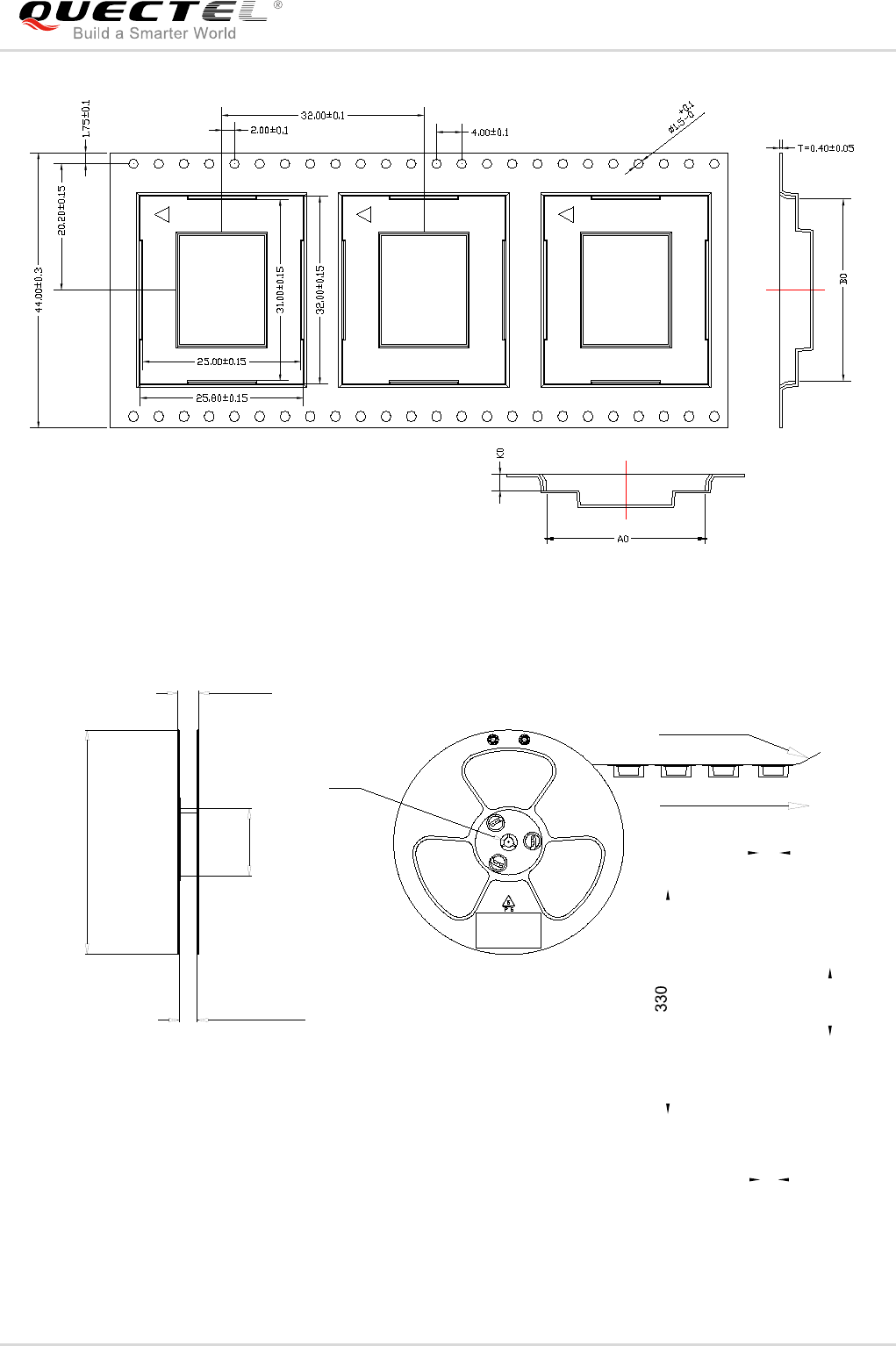
LTE Module Series
EG61-NA Hardware Design
EG61-NA_Hardware_Design 77 / 77
Figure 47: Tape Dimensions
Direction of feed
Cover tape
13
100
44.5
+0.20
-0.00
48.5
Figure 48: Reel Dimensions

LTE Module Series
EG61-NA Hardware Design
EG61-NA_Hardware_Design 78 / 77
9 Appendix A References
Table 36: Related Documents
SN Document Name Remark
[1] Quectel_EC2x&EG9x&EM05_Power_Management_
Application_Note
Power Management Application Note
for EC25, EC21, EC20 R2.0, EC20
R2.1, EG61-NA, EG91 and EM05
[2] Quectel_EG61-NA_AT_Commands_Manual AT Commands Manual for EG61-NA
[3] Quectel_Module_Secondary_SMT_User_Guide Module Secondary SMT User Guide
[4] Quectel_RF_Layout_Application_Note RF Layout Application Note
[5] Quectel_LTE_Module_Thermal_Design_Guide
Thermal design guide for LTE modules
including EC25, EC21, EC20 R2.0,
EC20 R2.1, EG91, EG95, EG25-G,
EP06, EG06, EM06 and AG35.
Table 37: Terms and Abbreviations
Abbreviation Description
AMR Adaptive Multi-rate
bps Bits Per Second
CHAP Challenge Handshake Authentication Protocol
CS Coding Scheme
CSD Circuit Switched Data
CTS Clear To Send
HSPA+ High Speed Packet Access+
DFOTA Delta Firmware Upgrade Over The Air
DL Downlink

LTE Module Series
EG61-NA Hardware Design
EG61-NA_Hardware_Design 79 / 77
DTR Data Terminal Ready
DTX Discontinuous Transmission
EFR Enhanced Full Rate
ESD Electrostatic Discharge
FDD Frequency Division Duplex
FR Full Rate
GSM Global System For Mobile Communications
HR Half Rate
HSPA High Speed Packet Access
HSDPA High Speed Downlink Packet Access
HSUPA High Speed Uplink Packet Access
I/O Input/Output
Inorm Normal Current
LED Light Emitting Diode
LNA Low Noise Amplifier
LTE Long Term Evolution
MIMO Multiple Input Multiple Output
MO Mobile Originated
MSB Most Significant Bit
MSL Moisture Sensitivity Level
MT Mobile Terminated
PAP Password Authentication Protocol
PCB Printed Circuit Board
PDU Protocol Data Unit
PPP Point-to-Point Protocol

LTE Module Series
EG61-NA Hardware Design
EG61-NA_Hardware_Design 80 / 77
QAM Quadrature Amplitude Modulation
QPSK Quadrature Phase Shift Keying
RF Radio Frequency
RHCP Right Hand Circularly Polarized
Rx Receive
SMS Short Message Service
TDD Time Division Duplexing
TX Transmitting Direction
UL Uplink
UMTS Universal Mobile Telecommunications System
URC Unsolicited Result Code
(U)SIM (Universal) Subscriber Identity Module
Vmax Maximum Voltage Value
Vnorm Normal Voltage Value
Vmin Minimum Voltage Value
VIHmax Maximum Input High Level Voltage Value
VIHmin Minimum Input High Level Voltage Value
VILmax Maximum Input Low Level Voltage Value
VILmin Minimum Input Low Level Voltage Value
VImax Absolute Maximum Input Voltage Value
VImin Absolute Minimum Input Voltage Value
VOax Maximum Output High Level Voltage Value
VOin Minimum Output High Level Voltage Value
VOLmax Maximum Output Low Level Voltage Value
VOLmin Minimum Output Low Level Voltage Value

LTE Module Series
EG61-NA Hardware Design
EG61-NA_Hardware_Design 81 / 77
VSWR Voltage Standing Wave Ratio
WCDMA Wideband Code Division Multiple Access

